Ethiopia, Part 8: Addis Ababa, Lucy and Shashamane
— Ethiopia — 14 min read
17 - 25 July 2011
After spending four weeks in northern Ethiopia, I arrived in the capital, Addis Ababa. I had a few things to take care of such as renewing my Ethiopian visa and getting my visa for Kenya. sanDRina was also long overdue for some maintenance, such as a new chain and oil change, which I did at the overland junction of Wim's Holland House.
Besides the above tasks, I also took some time to just relax and do nothing as a very long off-road leg of the journey was coming up south of here. In the evenings, I met up with new and recent friends and enjoyed the night life of the city. The one touristy and very interesting thing I did during my stay was to pay a visit to Lucy, a very famous and important hominin skeleton that was discovered in Ethiopia in the 1970s and dates back to 3.2 million years ago.
Heading south of Addis, I visited the Melka Kunture archeological site where more human remains and tools were on display and then spent a few days in the Rastafari headquarters of Shashamane, where I was lucky to be there for a reggae concert, that too in celebration of their central figure, Haile Selassie.
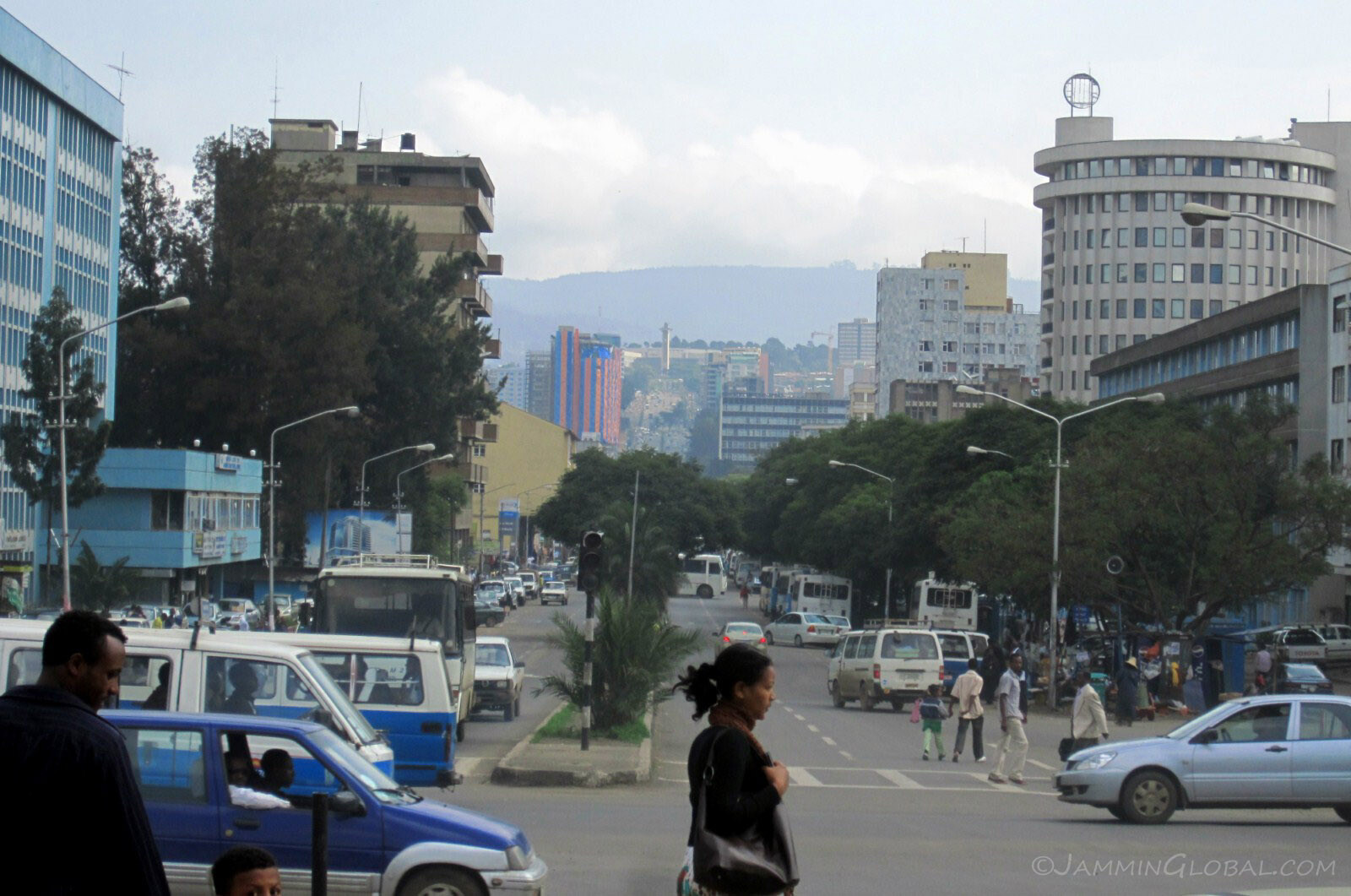 Sights of Addis Ababa: looking up Churchill Avenue, the main thoroughfare of the city, which is located at 2,350 m (7,700 ft).
Sights of Addis Ababa: looking up Churchill Avenue, the main thoroughfare of the city, which is located at 2,350 m (7,700 ft).
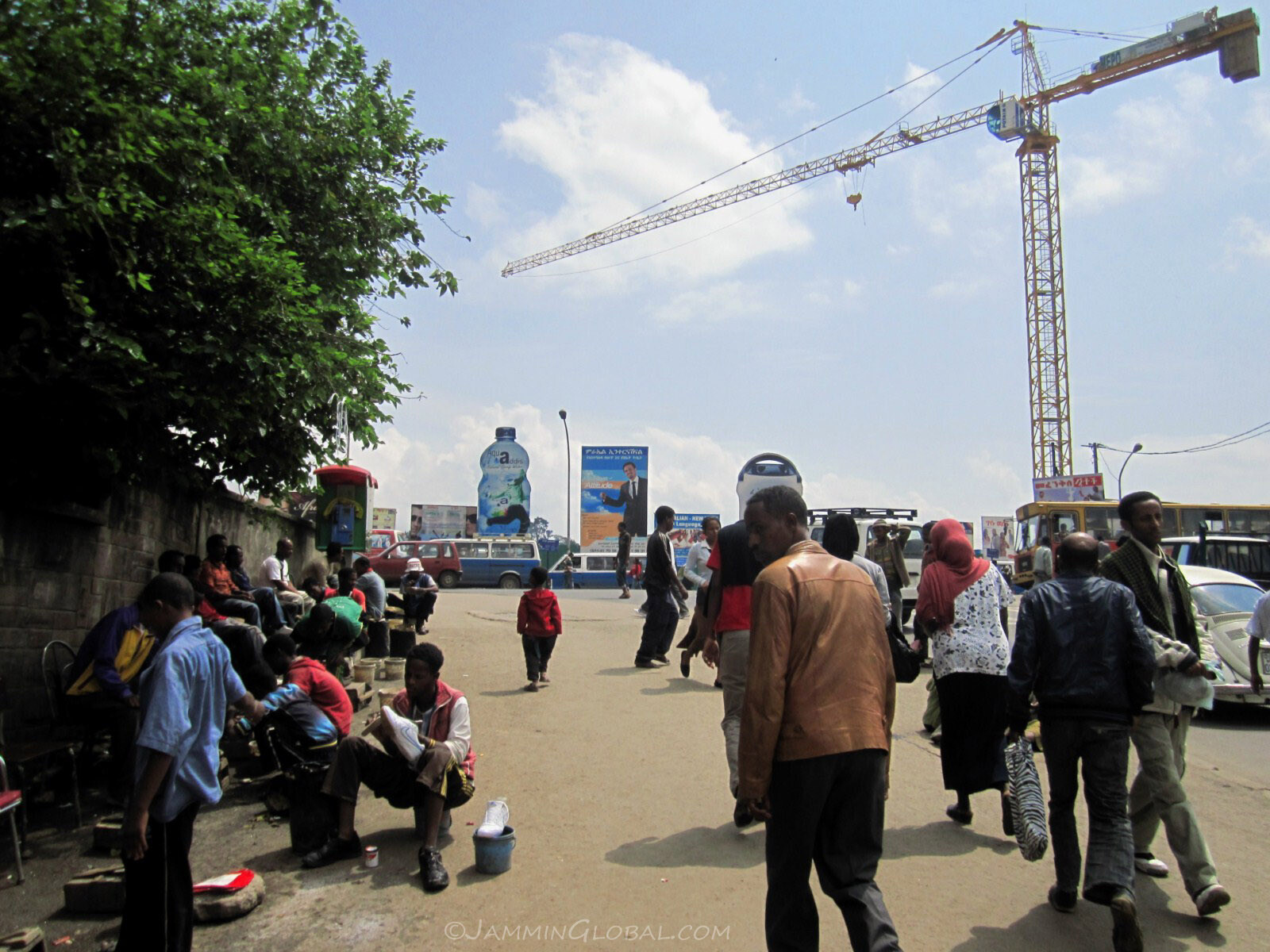 I gave sanDRina a break and walked around and took public transport and in doing so got a look into regular street life. Passing by a busy shoe shine area and noting the huge construction crane as the city booms along.
I gave sanDRina a break and walked around and took public transport and in doing so got a look into regular street life. Passing by a busy shoe shine area and noting the huge construction crane as the city booms along.
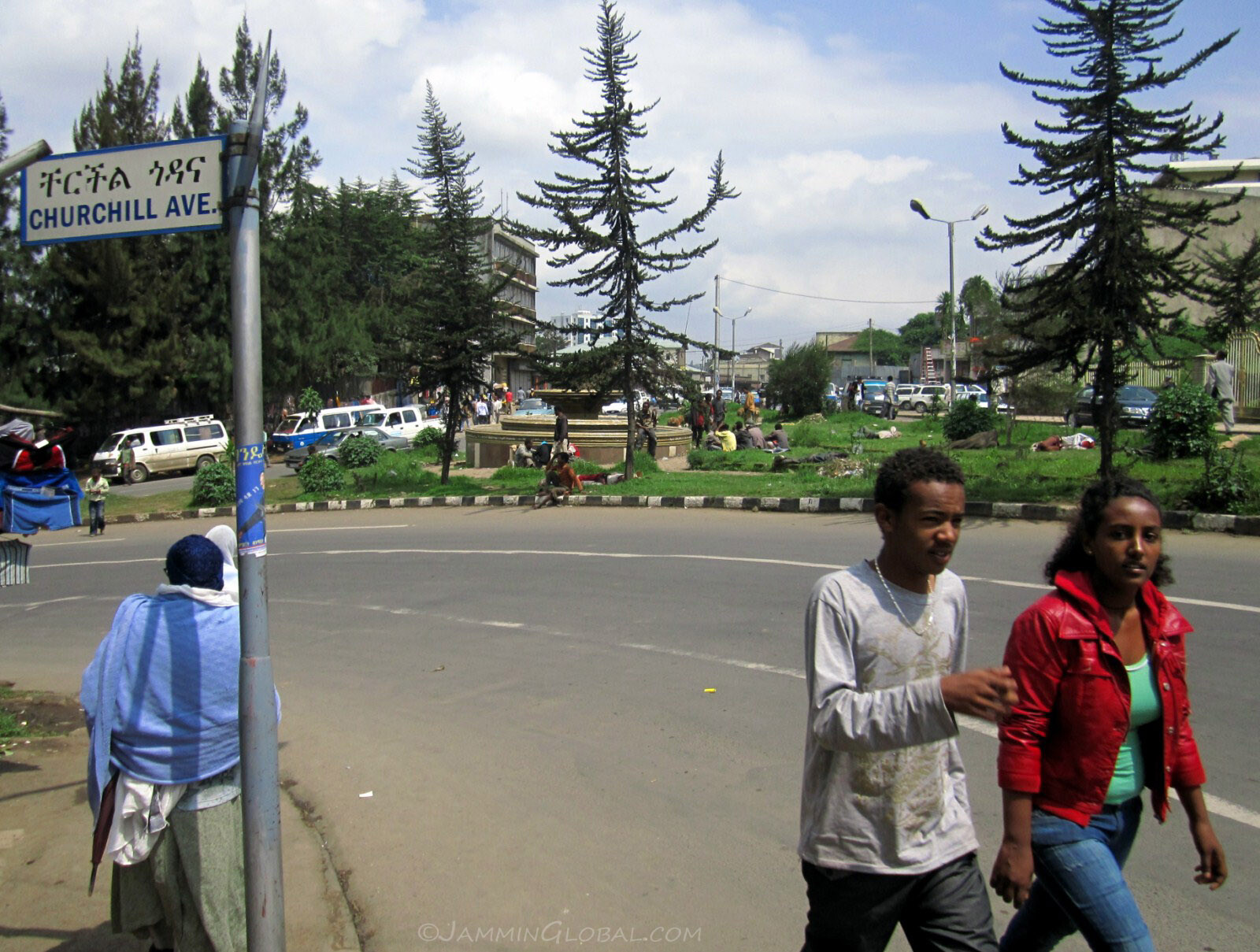 At the north end of Churchill Avenue, which was a part of my daily route as I lived at the southern end. Nice leather jacket.
At the north end of Churchill Avenue, which was a part of my daily route as I lived at the southern end. Nice leather jacket.
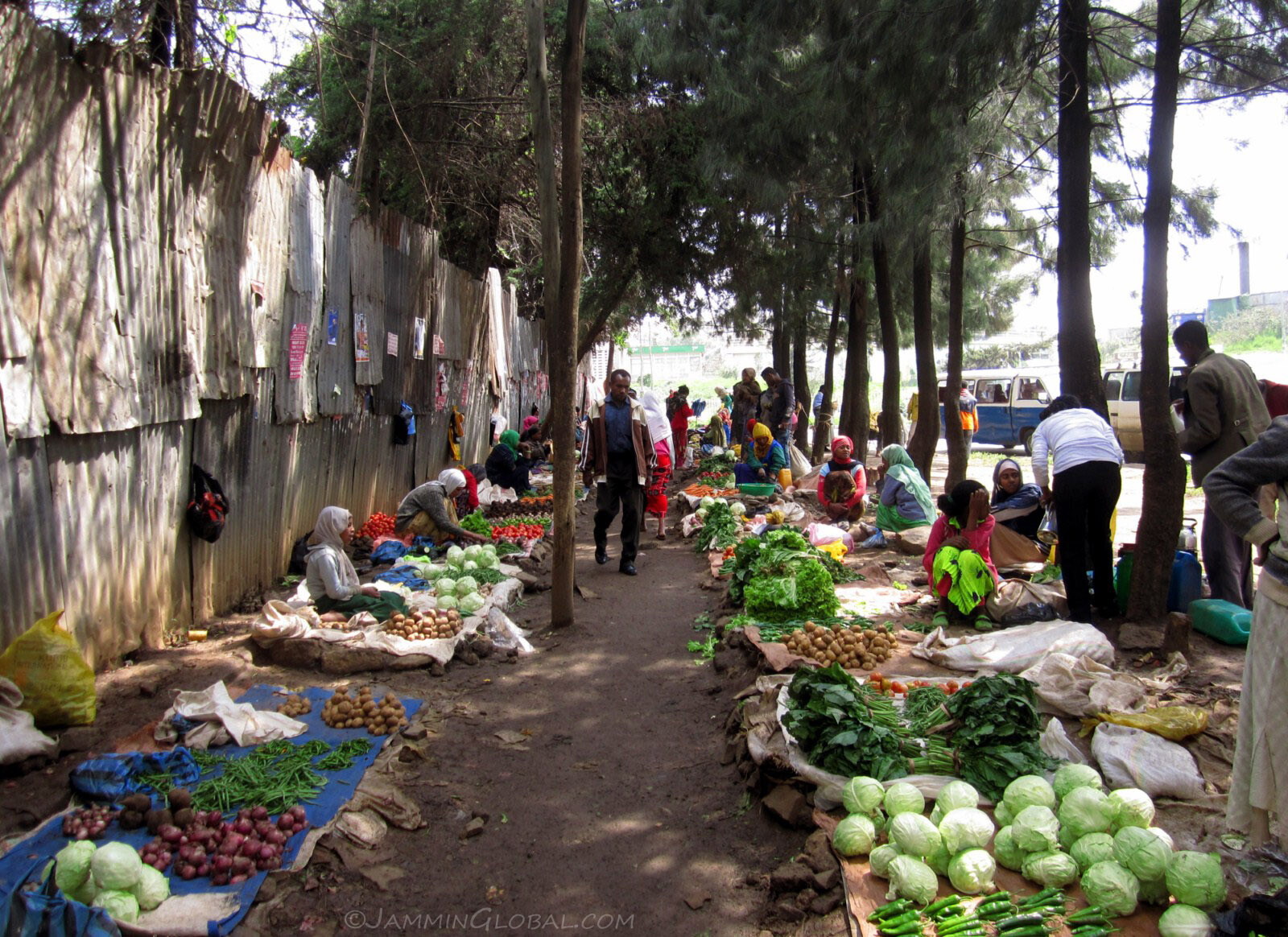 A vegetable market, hidden slightly from the busy street by the row of trees. I bought 12 small bananas for 2 Birr (\$0.12).
A vegetable market, hidden slightly from the busy street by the row of trees. I bought 12 small bananas for 2 Birr (\$0.12).
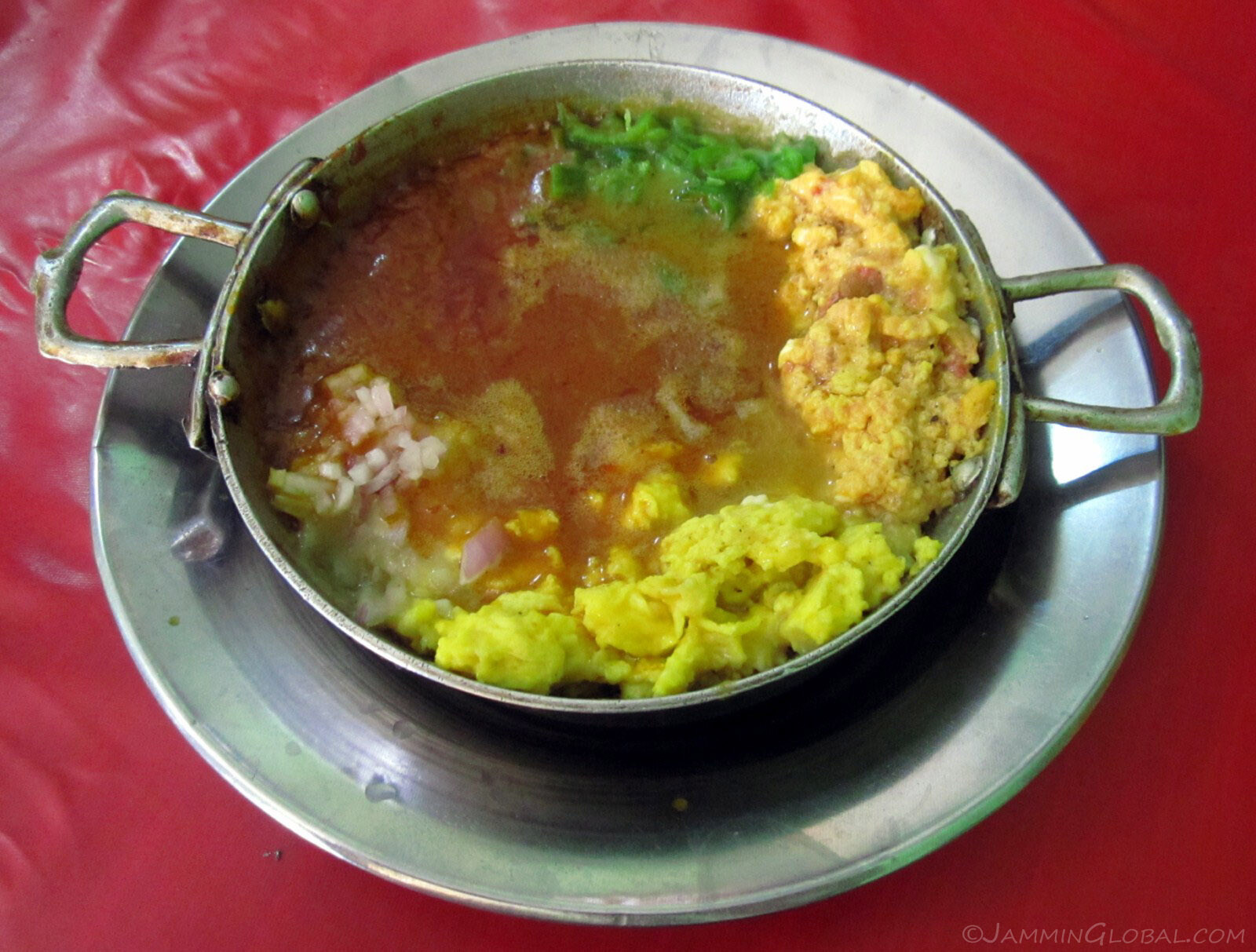 Having an interesting dish for lunch that consisted of scrambled eggs with a red sauce, chives and onions.
Having an interesting dish for lunch that consisted of scrambled eggs with a red sauce, chives and onions.
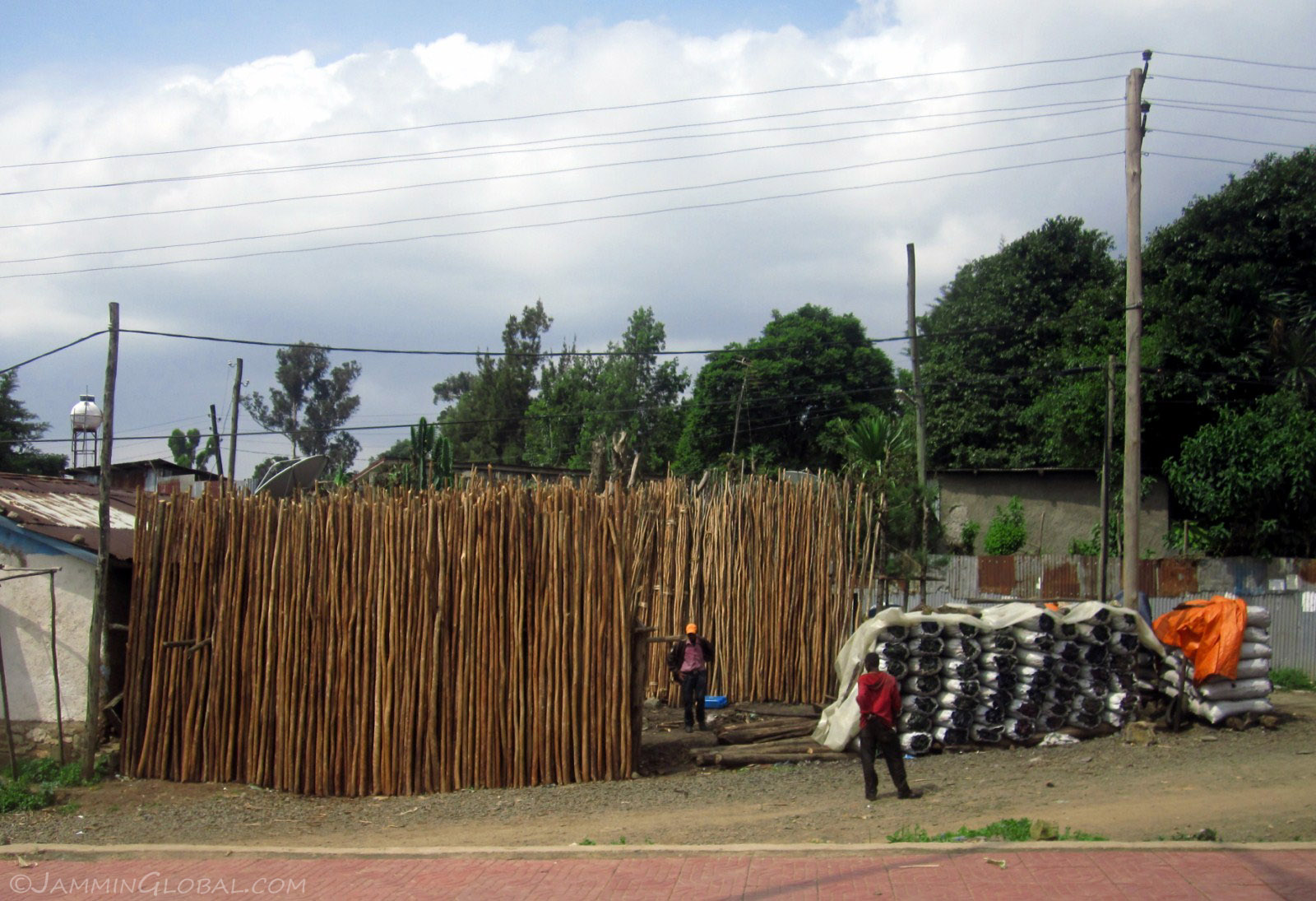 Passing by a street seller of wood for construction (scaffolding) and bags of charcoal.
Passing by a street seller of wood for construction (scaffolding) and bags of charcoal.
 An interesting game of foosball on a side street in Addis.
An interesting game of foosball on a side street in Addis.
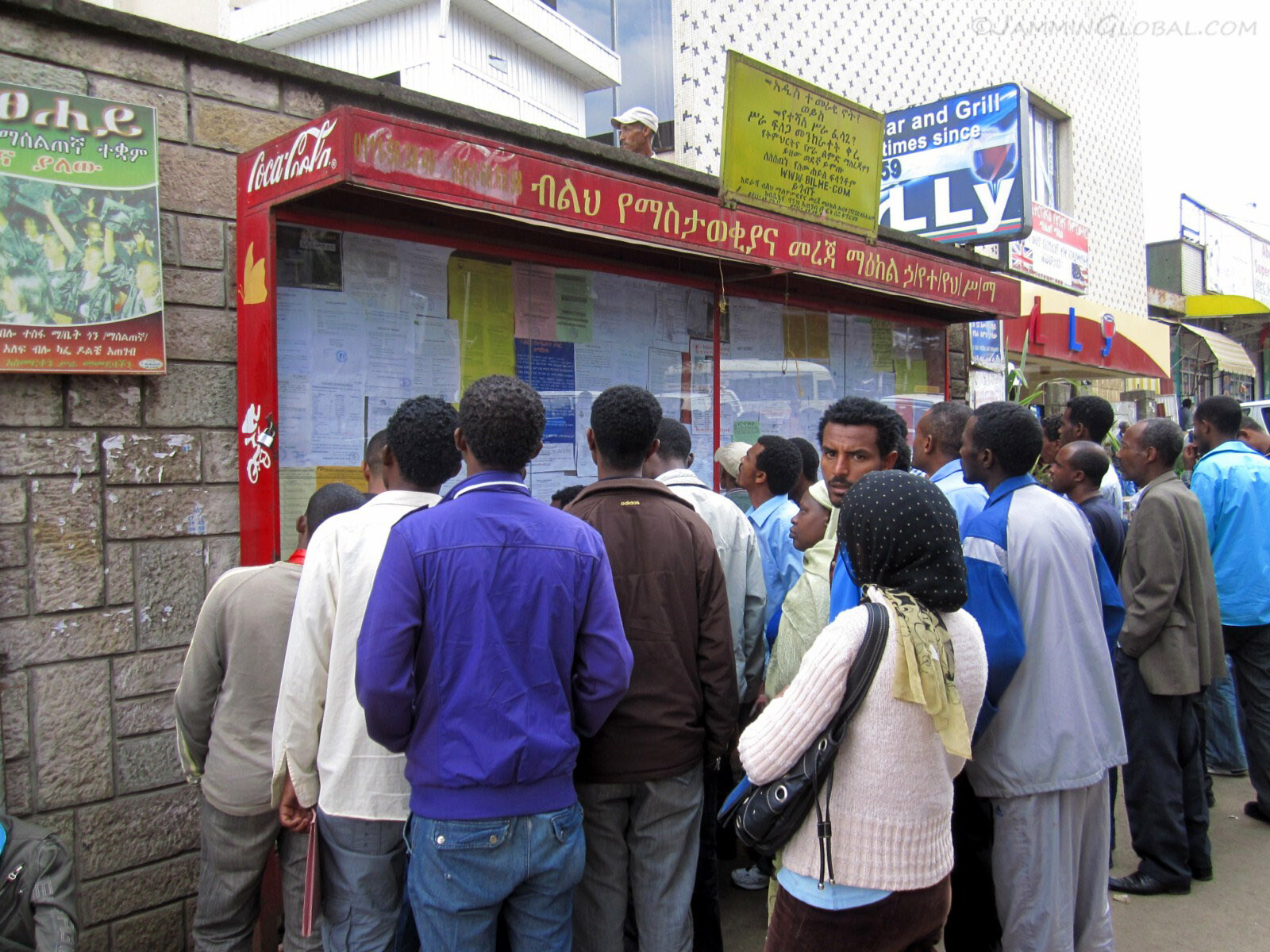 It was the end of the school year and people were checking their exam results.
It was the end of the school year and people were checking their exam results.
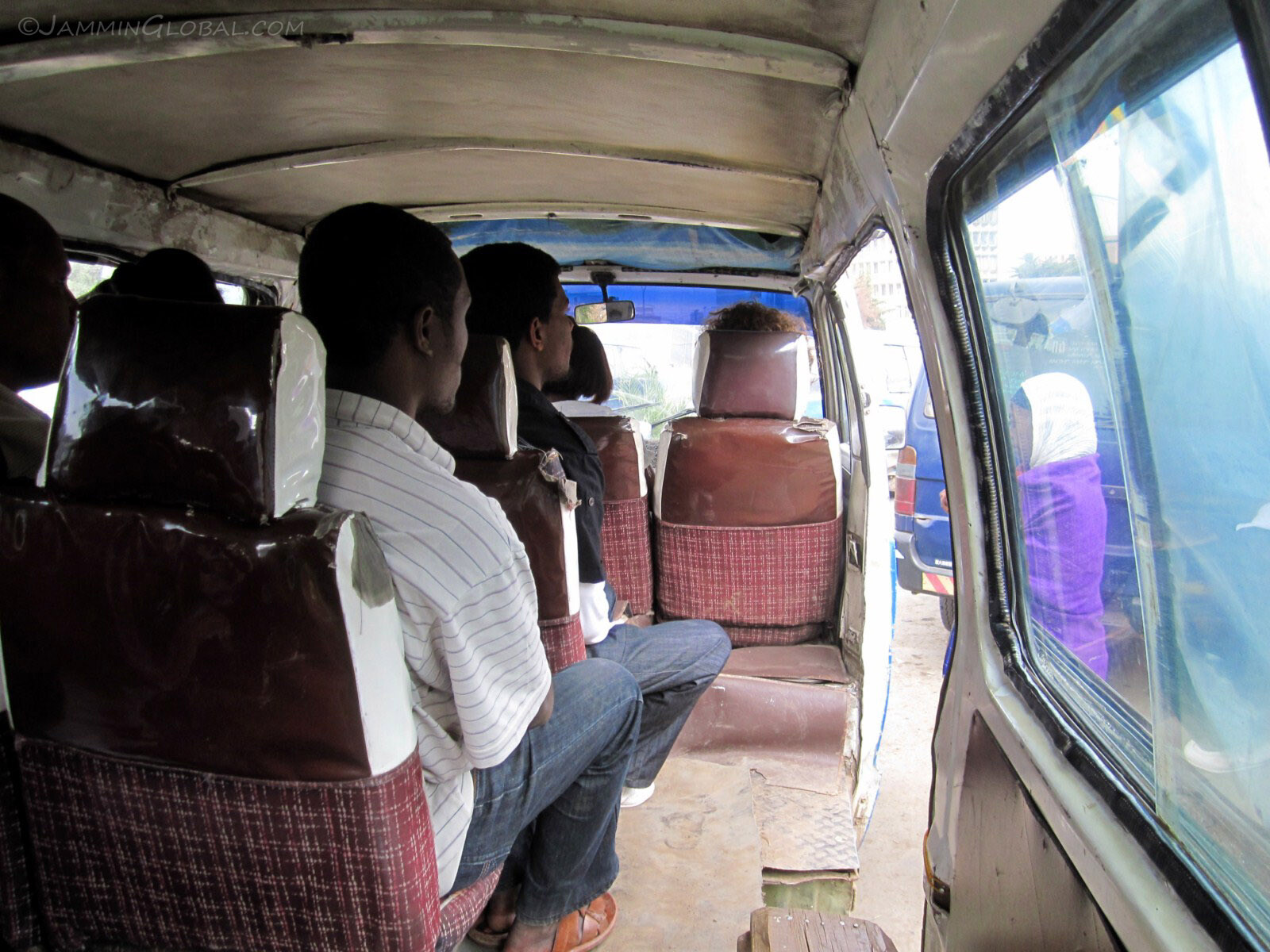 Riding a minibus to the Kenyan Embassy where I got my tourist visa issued within a day.
Riding a minibus to the Kenyan Embassy where I got my tourist visa issued within a day.
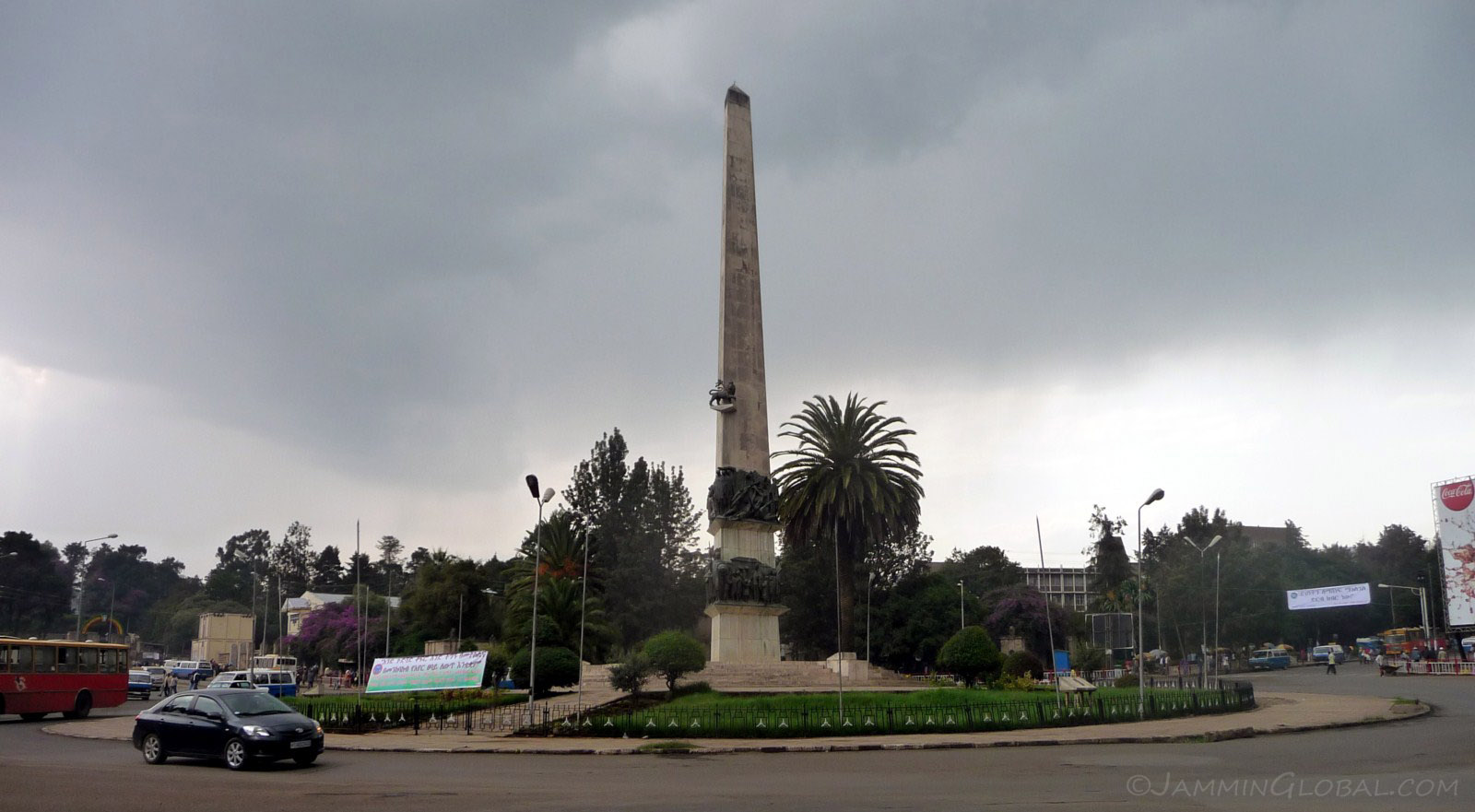 Yekatit 12 Square, also known as, Sidist Kilo, is a monument to the thousands of people that were killed during the brief Italian occupation. In 1936, Italian Vice-Roy Marshal Grazziani ordered a massacre of civilians in response to an assassination attempt on him. The metal bas relieves depict the massacre and funerals that followed and there's a Lion of Juddah above that, a symbol that Ethiopians have embraced from their biblical descent.
Yekatit 12 Square, also known as, Sidist Kilo, is a monument to the thousands of people that were killed during the brief Italian occupation. In 1936, Italian Vice-Roy Marshal Grazziani ordered a massacre of civilians in response to an assassination attempt on him. The metal bas relieves depict the massacre and funerals that followed and there's a Lion of Juddah above that, a symbol that Ethiopians have embraced from their biblical descent.
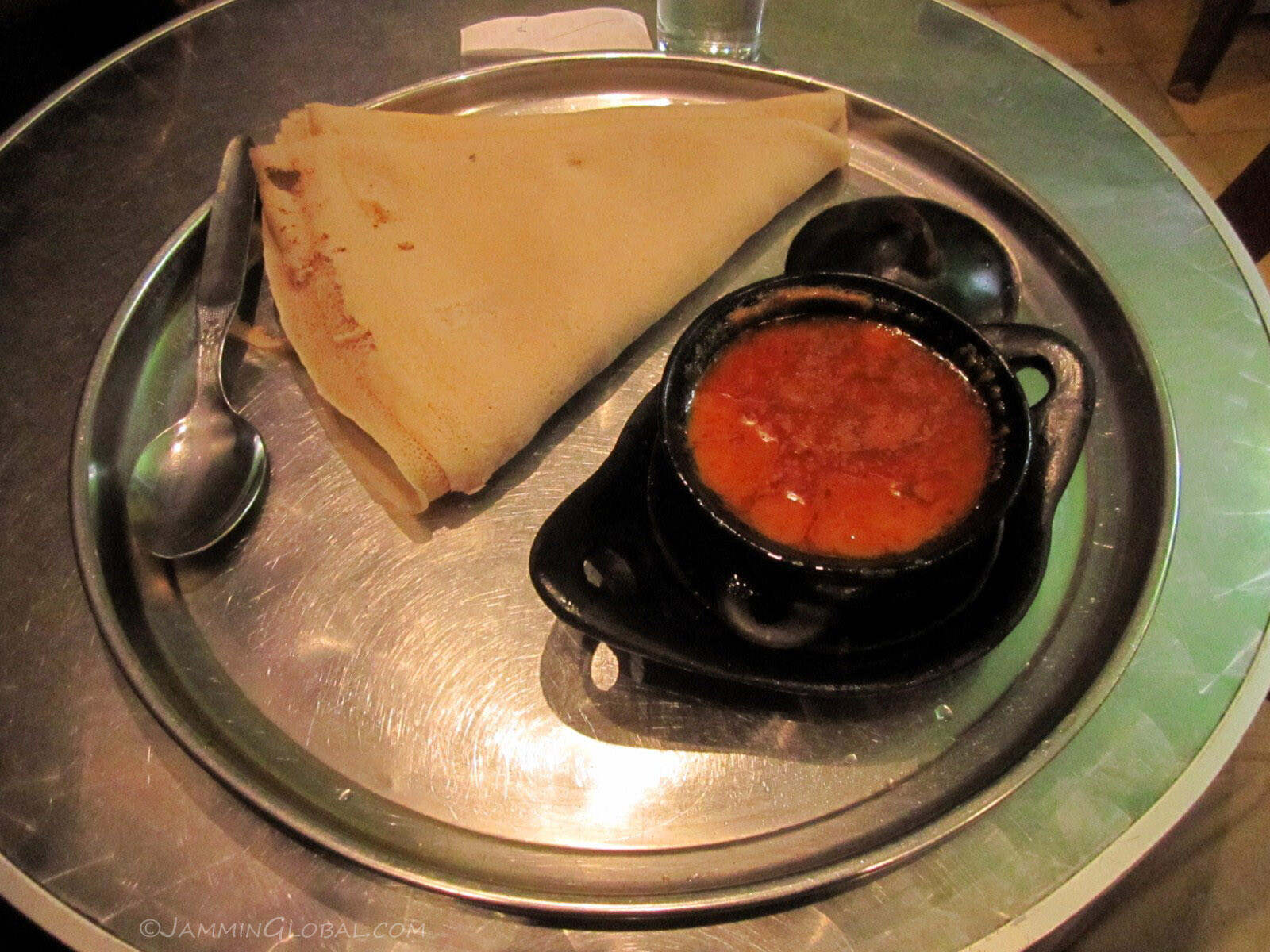 Enjoying a nice meal of injera with shiro. The injera was different from the kinds I found in smaller towns, being lighter and a bit crispier. The usual way to eat injera is to dump the sauce on top of it but due to my Indian traditions where we dip our bread (dosa) into the sauce, I have to catch the waiter before they dump the sauce and then can enjoy my dipping. Must look strange to them but that’s how I enjoy it.
Enjoying a nice meal of injera with shiro. The injera was different from the kinds I found in smaller towns, being lighter and a bit crispier. The usual way to eat injera is to dump the sauce on top of it but due to my Indian traditions where we dip our bread (dosa) into the sauce, I have to catch the waiter before they dump the sauce and then can enjoy my dipping. Must look strange to them but that’s how I enjoy it.
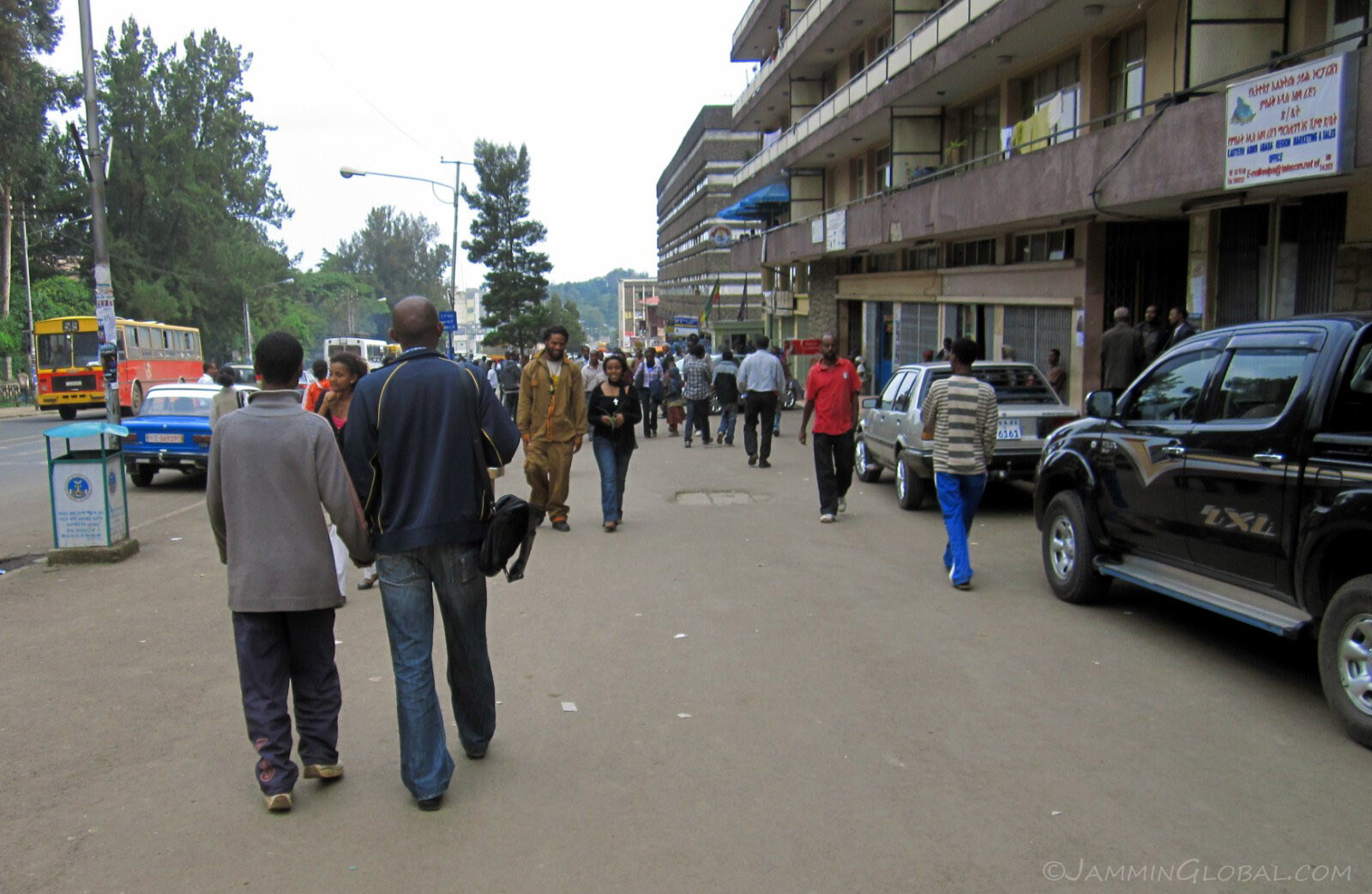 A street scene of Addis and note the two men holding hands and walking down the street, considered perfectly normal here and it doesn't indicate that their gay. It's just a non-sexual way to show affection between males. This is also common throughout India where generally it's frowned upon if girls and guys are seen holding hands but it's perfectly okay if friends of the same sex are holding hands and being close.
A street scene of Addis and note the two men holding hands and walking down the street, considered perfectly normal here and it doesn't indicate that their gay. It's just a non-sexual way to show affection between males. This is also common throughout India where generally it's frowned upon if girls and guys are seen holding hands but it's perfectly okay if friends of the same sex are holding hands and being close.
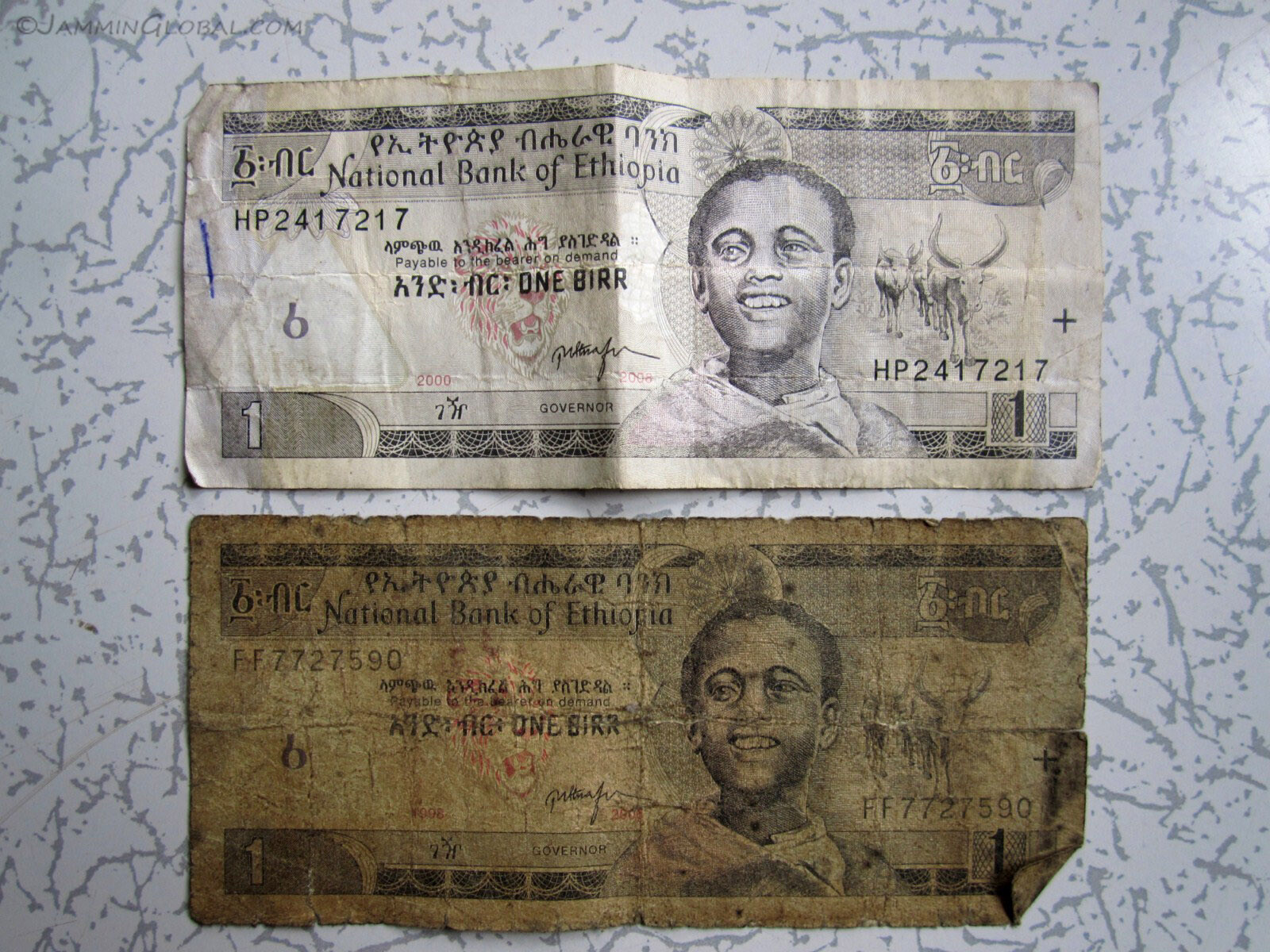 Ethiopia's currency, the Birr, which has been around since 1855. USD 1 = 17 Birr. Most travelers concur that the birr is one of the dirtiest notes to handle, in general. The above note is a cleaner version of the same 1 Birr note below it. We figured that it's because most Ethiopians eat with their hands and we noted that there isn't soap usually at the hand wash stations of local restaurants and all that spicy berbere gets rubbed off on the birrs.
Ethiopia's currency, the Birr, which has been around since 1855. USD 1 = 17 Birr. Most travelers concur that the birr is one of the dirtiest notes to handle, in general. The above note is a cleaner version of the same 1 Birr note below it. We figured that it's because most Ethiopians eat with their hands and we noted that there isn't soap usually at the hand wash stations of local restaurants and all that spicy berbere gets rubbed off on the birrs.
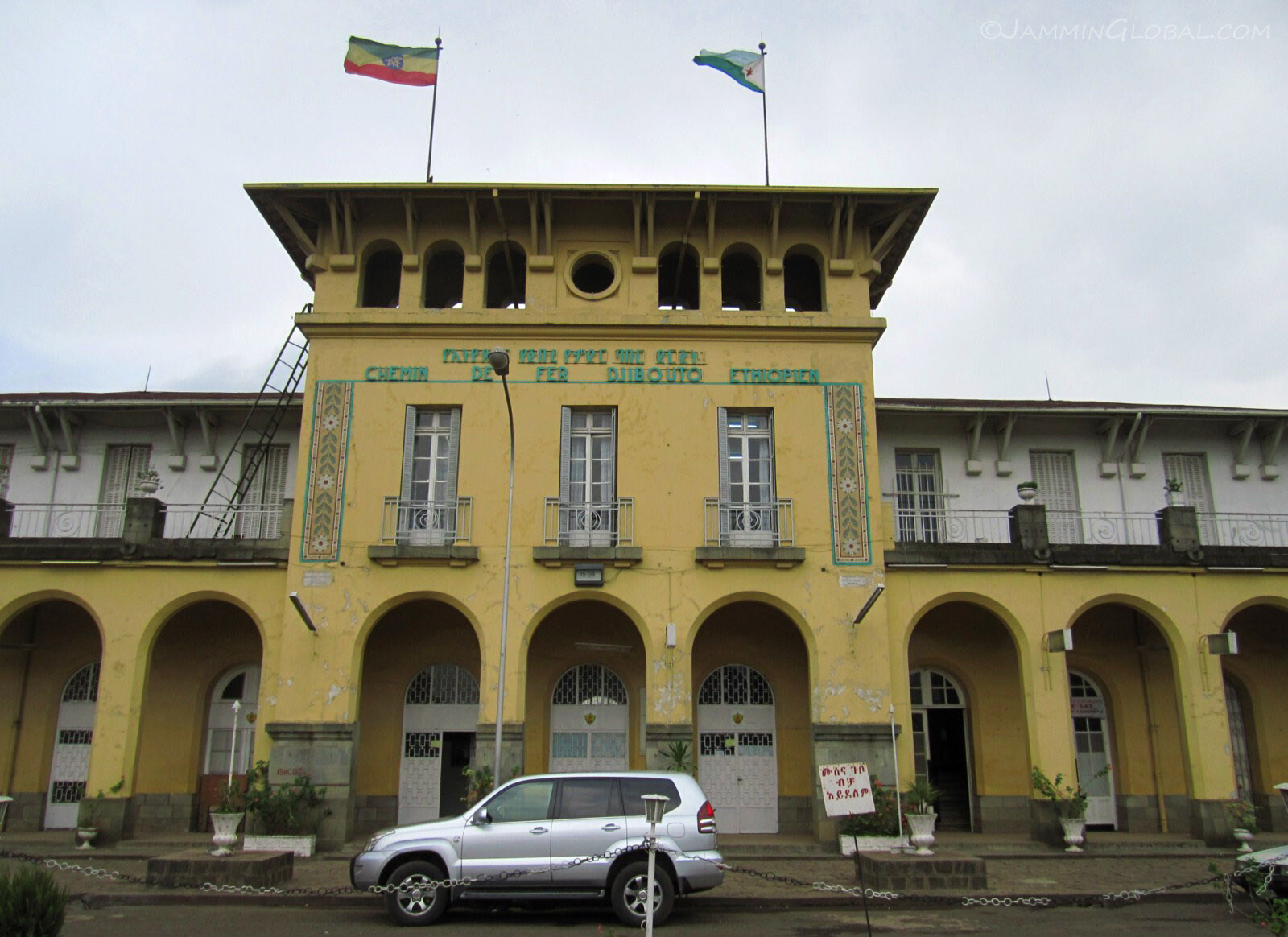 The century-old La Gare train station. It's the southern terminus of the only railway line currently in Ethiopia that was built to link the capital to the sea port in Djibouti, 800 kms (497 mi) away. There's no passenger service from here and the poor building is under threat of demolition to make way for a new road. In 2010, a Chinese construction company was given the go ahead to start work on a new rail network for Ethiopia, linking Addis with Kenya and Sudan.
The century-old La Gare train station. It's the southern terminus of the only railway line currently in Ethiopia that was built to link the capital to the sea port in Djibouti, 800 kms (497 mi) away. There's no passenger service from here and the poor building is under threat of demolition to make way for a new road. In 2010, a Chinese construction company was given the go ahead to start work on a new rail network for Ethiopia, linking Addis with Kenya and Sudan.
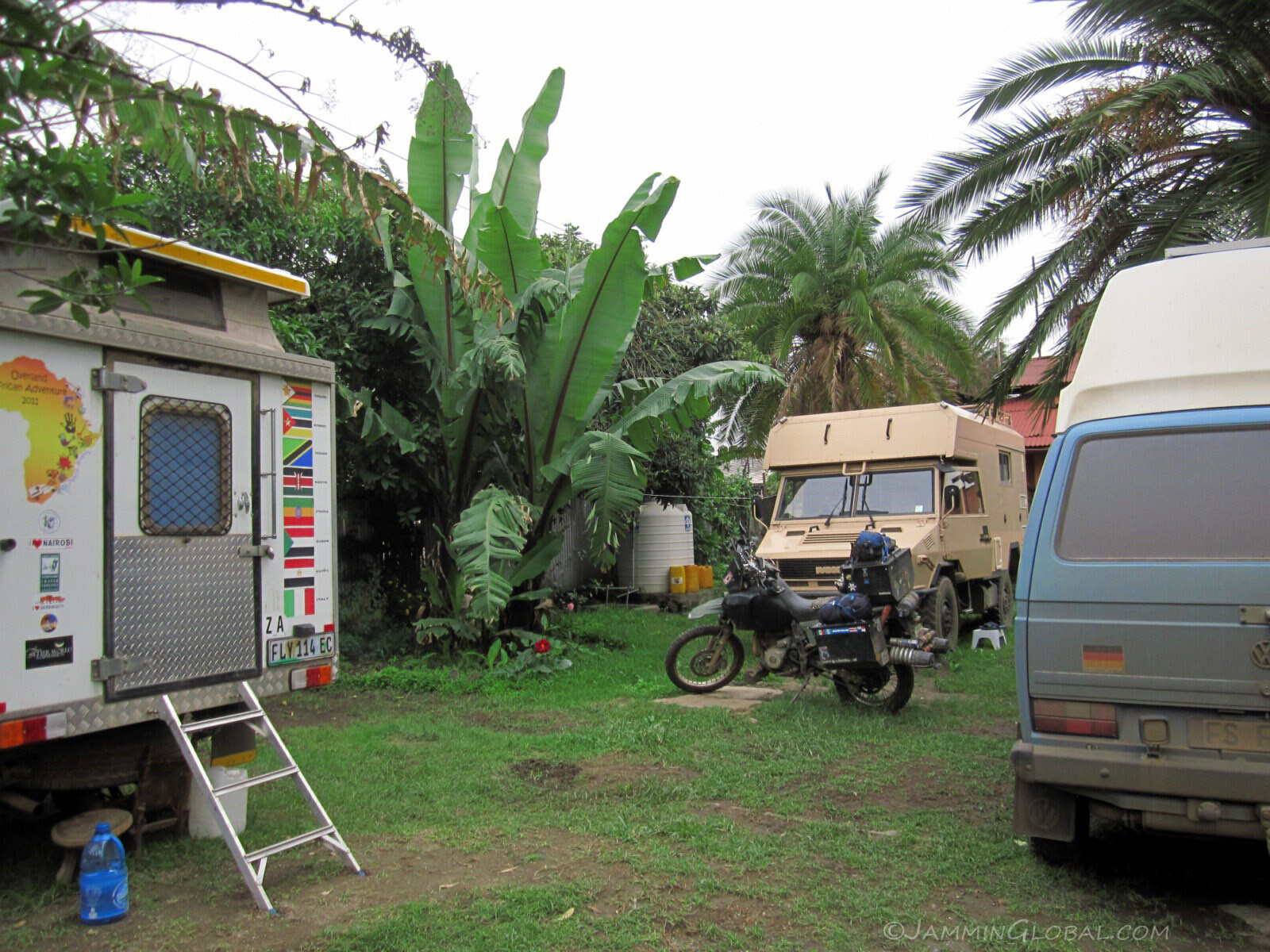 To the left of La Gare is a small street that leads to Wim's Holland House, the overland junction in Addis. I stayed here as I needed to connect with other travelers to plan our convoy for the Lake Turkana route into Kenya. The white Toyota Hilux camper belonged to a South African couple who were heading north and told me I had a place to stay when I got to their home town of Port Elizabeth. The brown Iveco motorhome was being driven by a very elderly British couple, Austin and Oona, who've been on the road for the past 12 years and the blue and white VW Syncro was Ferdie and Katie's, who I met earlier at Tim and Kim’s in Gorgora and again in Lalibela. I would be primarily traveling with them on the Turkana route.
To the left of La Gare is a small street that leads to Wim's Holland House, the overland junction in Addis. I stayed here as I needed to connect with other travelers to plan our convoy for the Lake Turkana route into Kenya. The white Toyota Hilux camper belonged to a South African couple who were heading north and told me I had a place to stay when I got to their home town of Port Elizabeth. The brown Iveco motorhome was being driven by a very elderly British couple, Austin and Oona, who've been on the road for the past 12 years and the blue and white VW Syncro was Ferdie and Katie's, who I met earlier at Tim and Kim’s in Gorgora and again in Lalibela. I would be primarily traveling with them on the Turkana route.
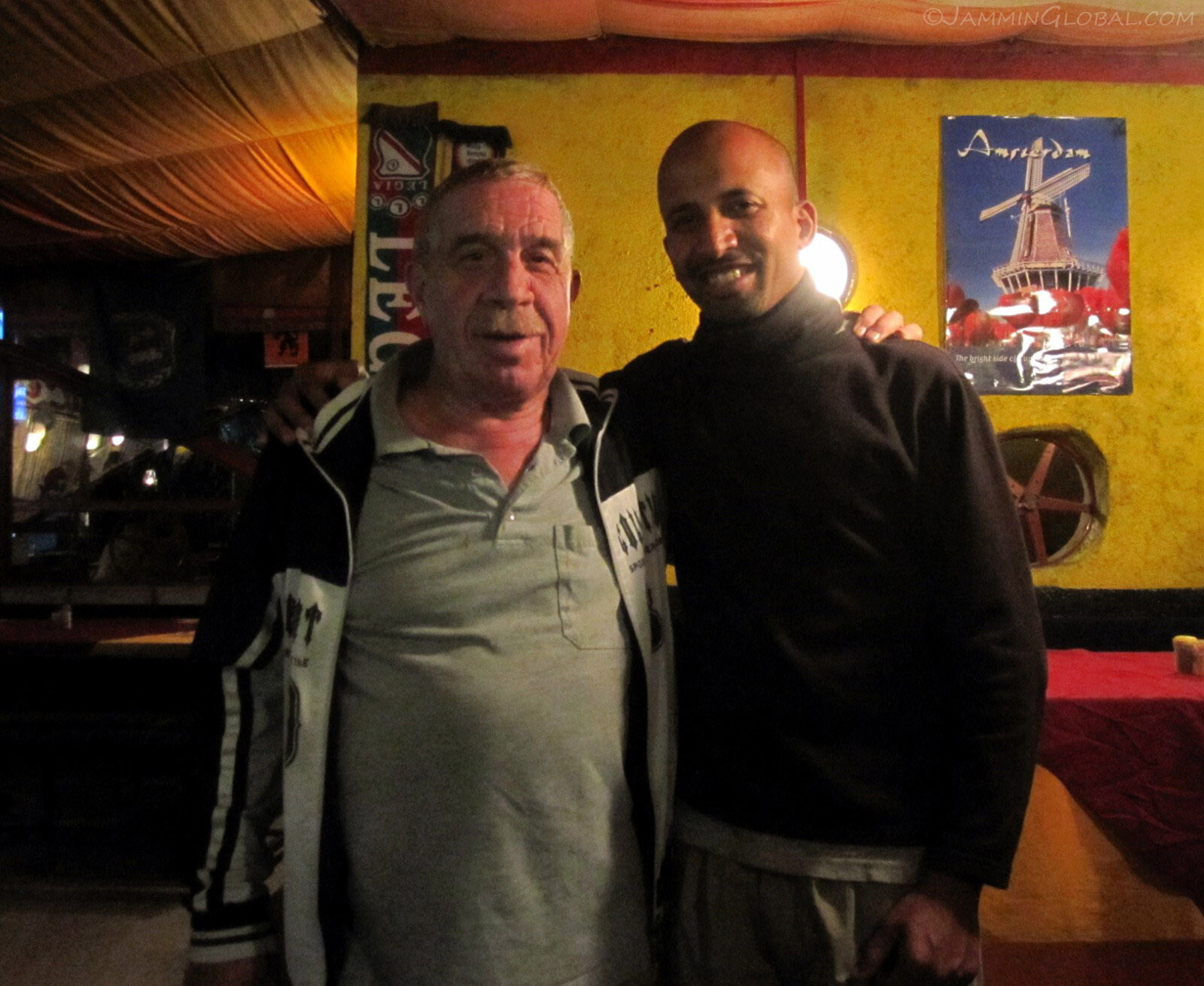 A photo with Wim, who set up his Holland House many years ago as a refuge of food and beer for all the Dutch that were living in Addis involved in the flower farming business. He's been in Africa for about 40 years and was running a successful overland trucking company into Sudan, to re-supply all the international organizations there but with the change in leadership, it got harder to do business there. I guess slowly, overland travelers started staying with him and he expanded his compound to invite them to camp and rest for a few days after the rough stretch from Kenya. He had heard about my curry from Tim and Kim and requested that I prepare it for his restaurant.
A photo with Wim, who set up his Holland House many years ago as a refuge of food and beer for all the Dutch that were living in Addis involved in the flower farming business. He's been in Africa for about 40 years and was running a successful overland trucking company into Sudan, to re-supply all the international organizations there but with the change in leadership, it got harder to do business there. I guess slowly, overland travelers started staying with him and he expanded his compound to invite them to camp and rest for a few days after the rough stretch from Kenya. He had heard about my curry from Tim and Kim and requested that I prepare it for his restaurant.
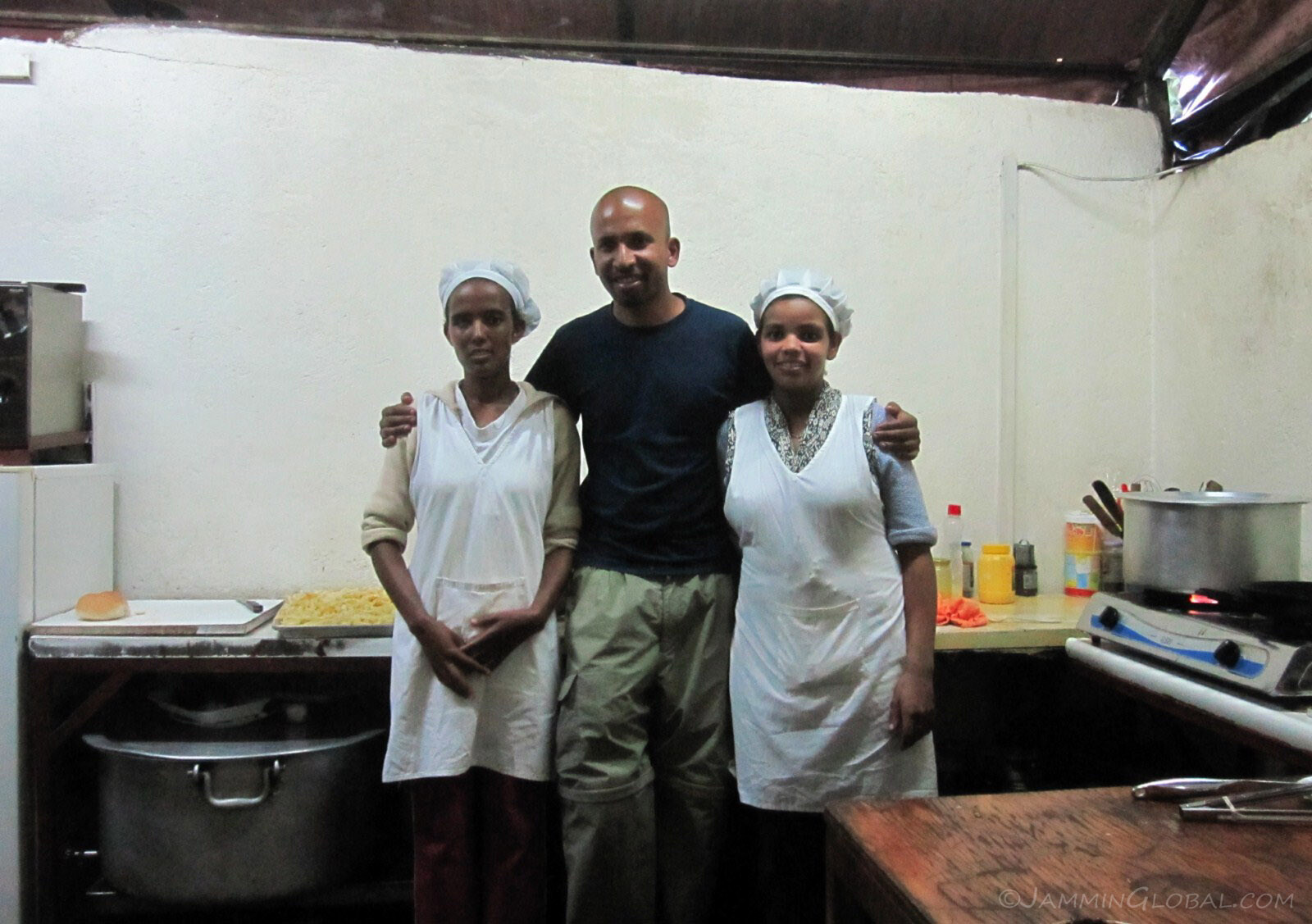 In the kitchen at Wim's Holland House with their two cooks who helped me prepare my chicken curry.
In the kitchen at Wim's Holland House with their two cooks who helped me prepare my chicken curry.
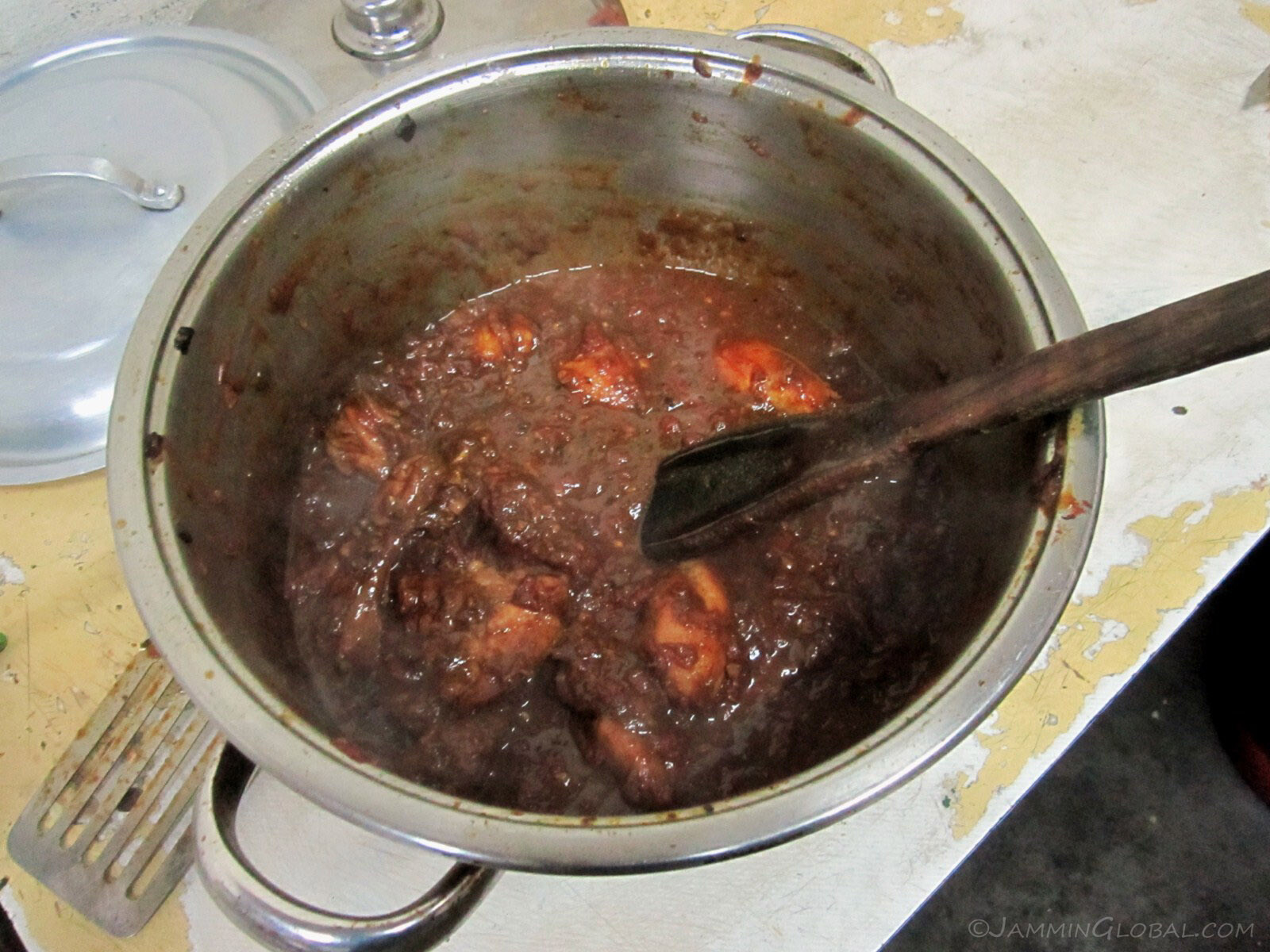 My chicken curry coming to life at Wim's Holland House, where I fed about 13 people that night. Wim was very impressed and asked if I could stay and manage the kitchen and his Holland House for a month. He was heading back to Holland for his annual medial check up and needed someone to run the place. It was a tempting offer, but I had to get to Nairobi.
My chicken curry coming to life at Wim's Holland House, where I fed about 13 people that night. Wim was very impressed and asked if I could stay and manage the kitchen and his Holland House for a month. He was heading back to Holland for his annual medial check up and needed someone to run the place. It was a tempting offer, but I had to get to Nairobi.
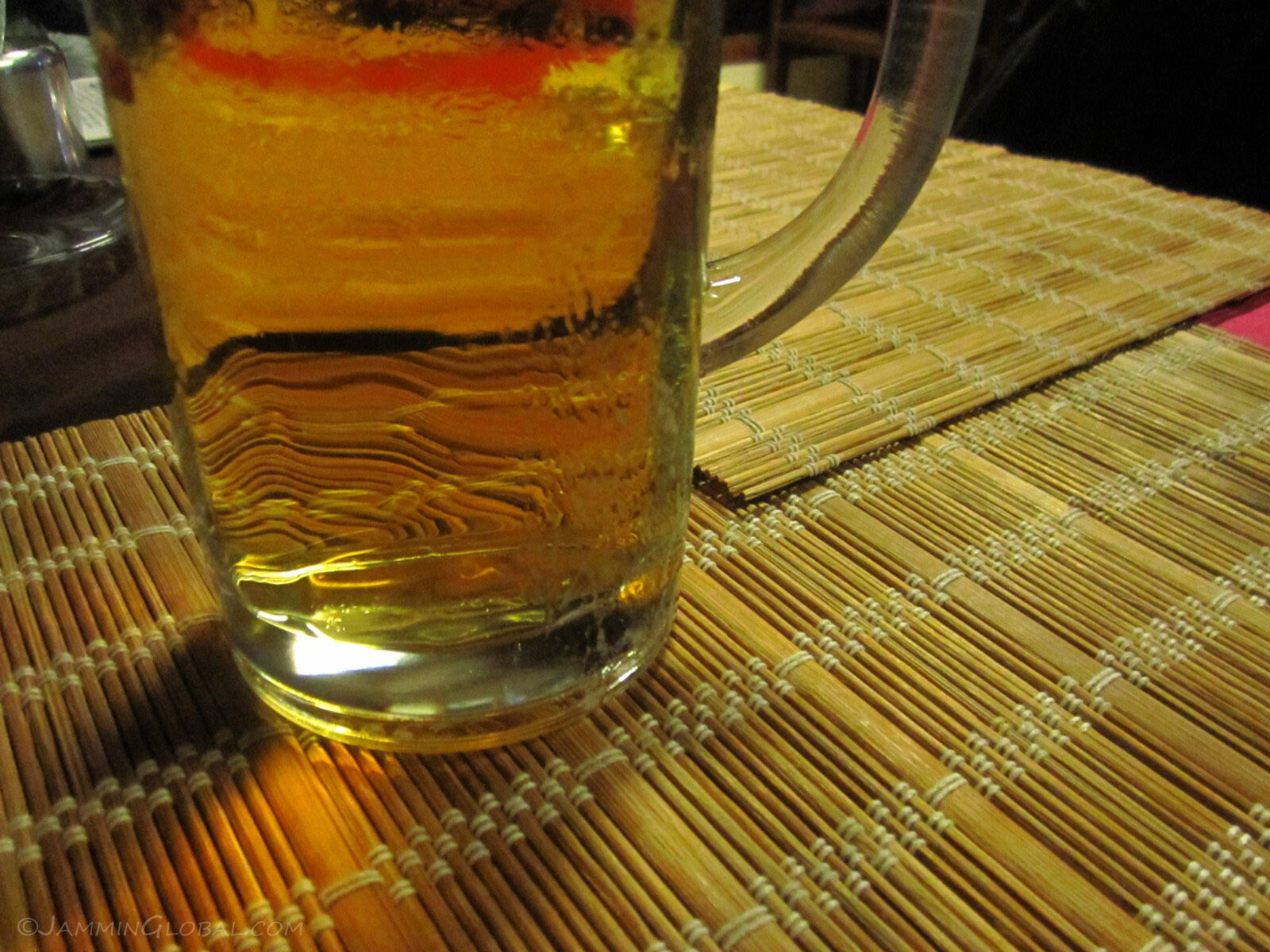 Enjoying a beer on the house after another successful Jammin Chicken Curry evening.
Enjoying a beer on the house after another successful Jammin Chicken Curry evening.
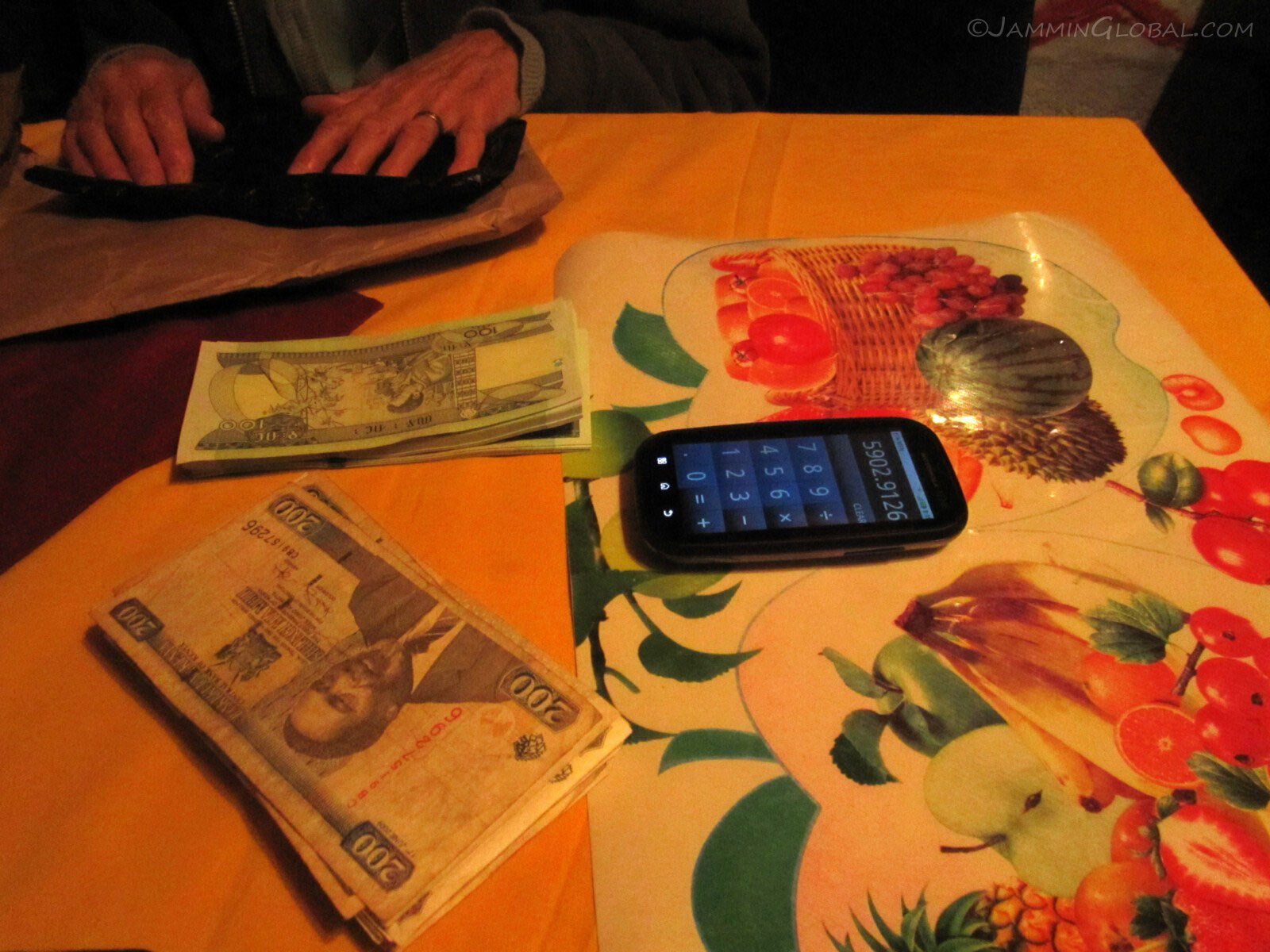 One of the things that travelers going in the opposite direction do when they meet: exchange currency. I relieved Austin and Oona of all their Kenyan Shillings in exchange for ATM-fresh Ethiopian Birr. Our convoy of travelers would be entering Kenya in the remote region of Lake Turkana where getting local currency isn't possible and we'd need to buy food and fuel for a few days before coming to the first sizeable town.
One of the things that travelers going in the opposite direction do when they meet: exchange currency. I relieved Austin and Oona of all their Kenyan Shillings in exchange for ATM-fresh Ethiopian Birr. Our convoy of travelers would be entering Kenya in the remote region of Lake Turkana where getting local currency isn't possible and we'd need to buy food and fuel for a few days before coming to the first sizeable town.
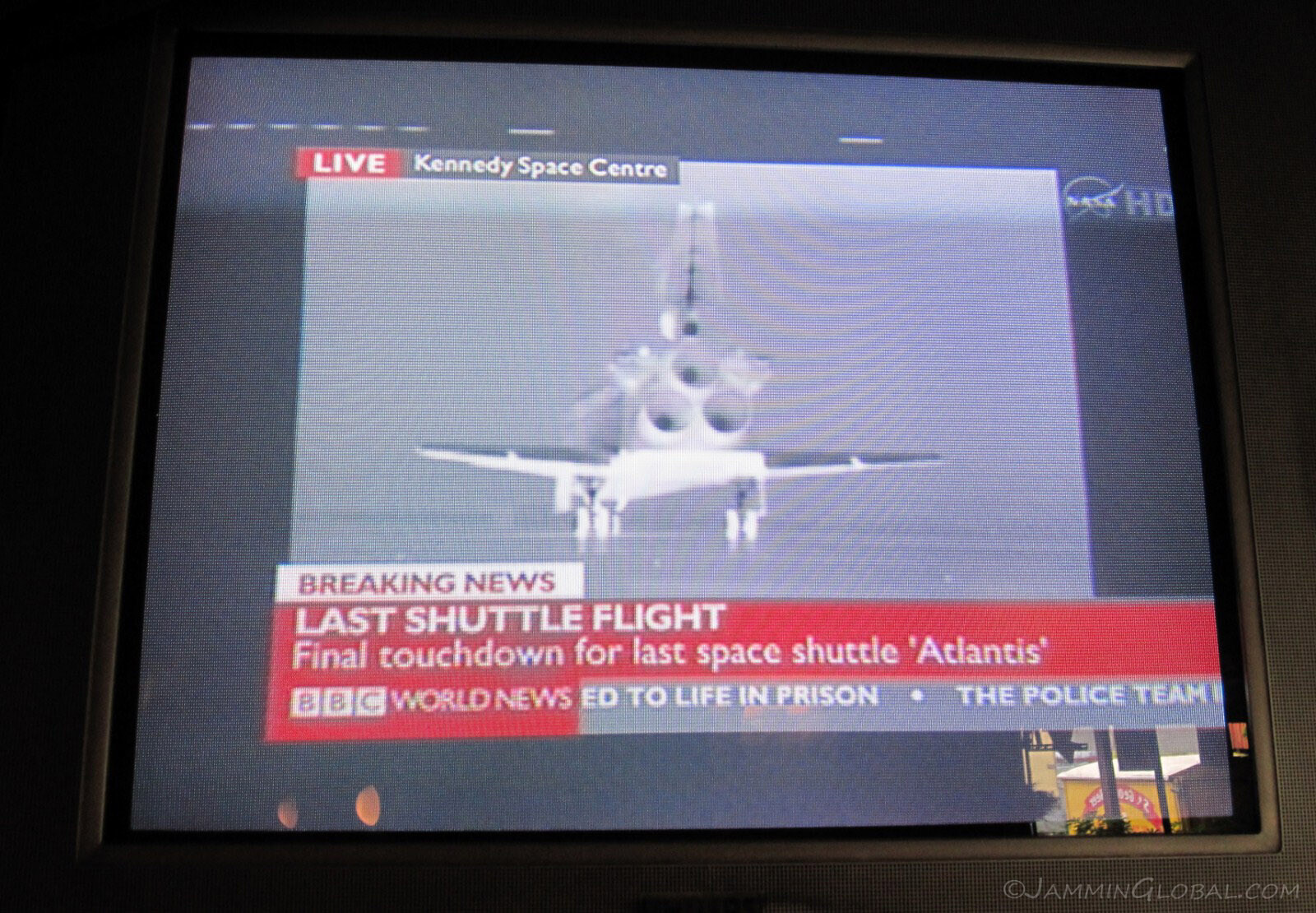 Being on the road is fantastic for many reasons but the one aspect that I lament is missing out on major historical events as they happen. The astronomy and space enthusiast in me was really excited to watch live the final touchdown of a Space Shuttle flight, as Atlantis made a night landing at the Kennedy Space Centre in Florida. NASA made a decision to retire their Space Shuttle fleet and instead allow commercial companies to provide them access to Low Earth Orbit, where the International Space Station resides. This would allow them to focus their funds on developing missions to Mars and asteroids.
Being on the road is fantastic for many reasons but the one aspect that I lament is missing out on major historical events as they happen. The astronomy and space enthusiast in me was really excited to watch live the final touchdown of a Space Shuttle flight, as Atlantis made a night landing at the Kennedy Space Centre in Florida. NASA made a decision to retire their Space Shuttle fleet and instead allow commercial companies to provide them access to Low Earth Orbit, where the International Space Station resides. This would allow them to focus their funds on developing missions to Mars and asteroids.
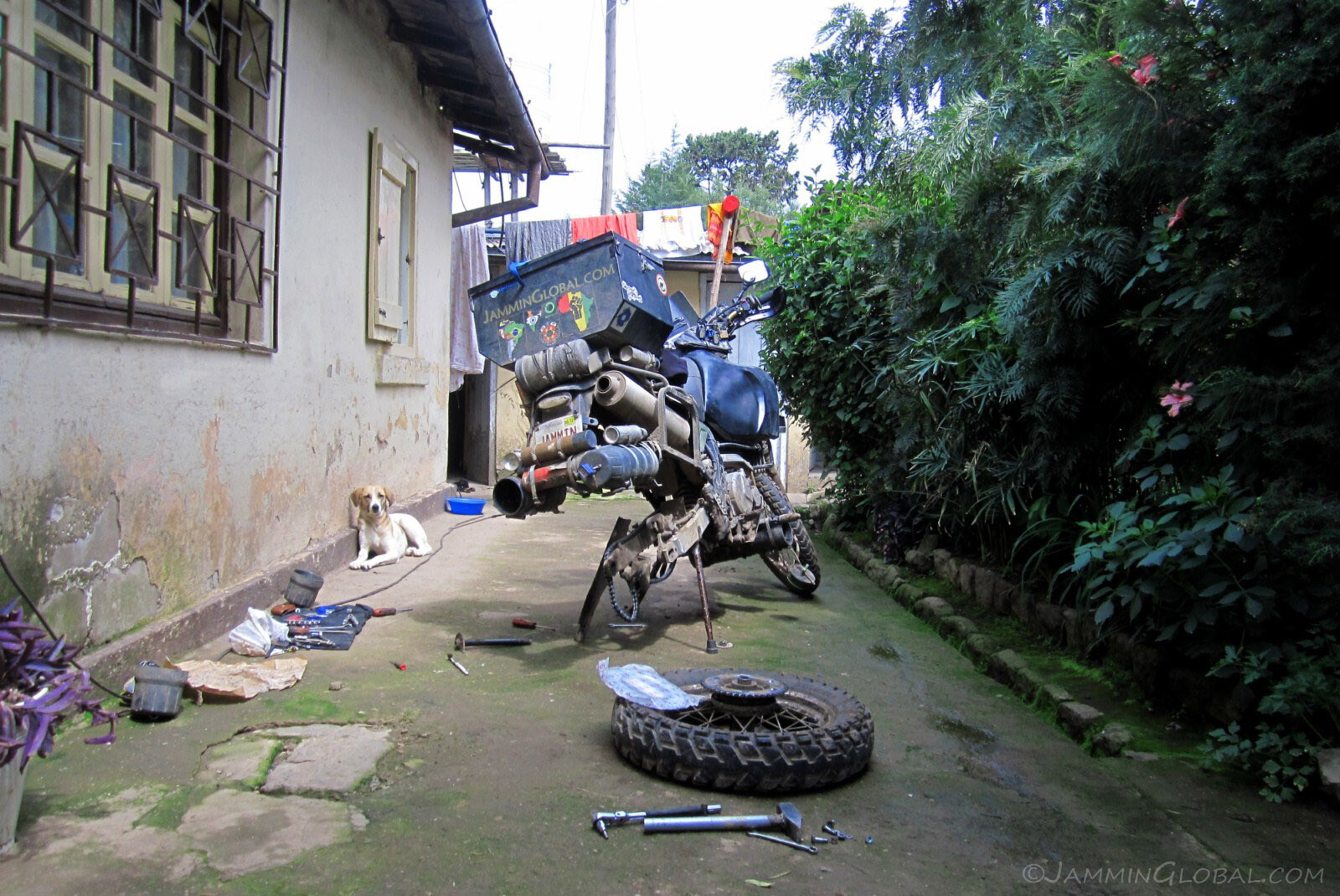 Back to Earth and prepping sanDRina for my next mission of riding the fabled Lake Turkana route into Kenya. I enjoyed the company of one of Wim's pooches who was well-behaved and did not run away with any of my scattered tools.
Back to Earth and prepping sanDRina for my next mission of riding the fabled Lake Turkana route into Kenya. I enjoyed the company of one of Wim's pooches who was well-behaved and did not run away with any of my scattered tools.
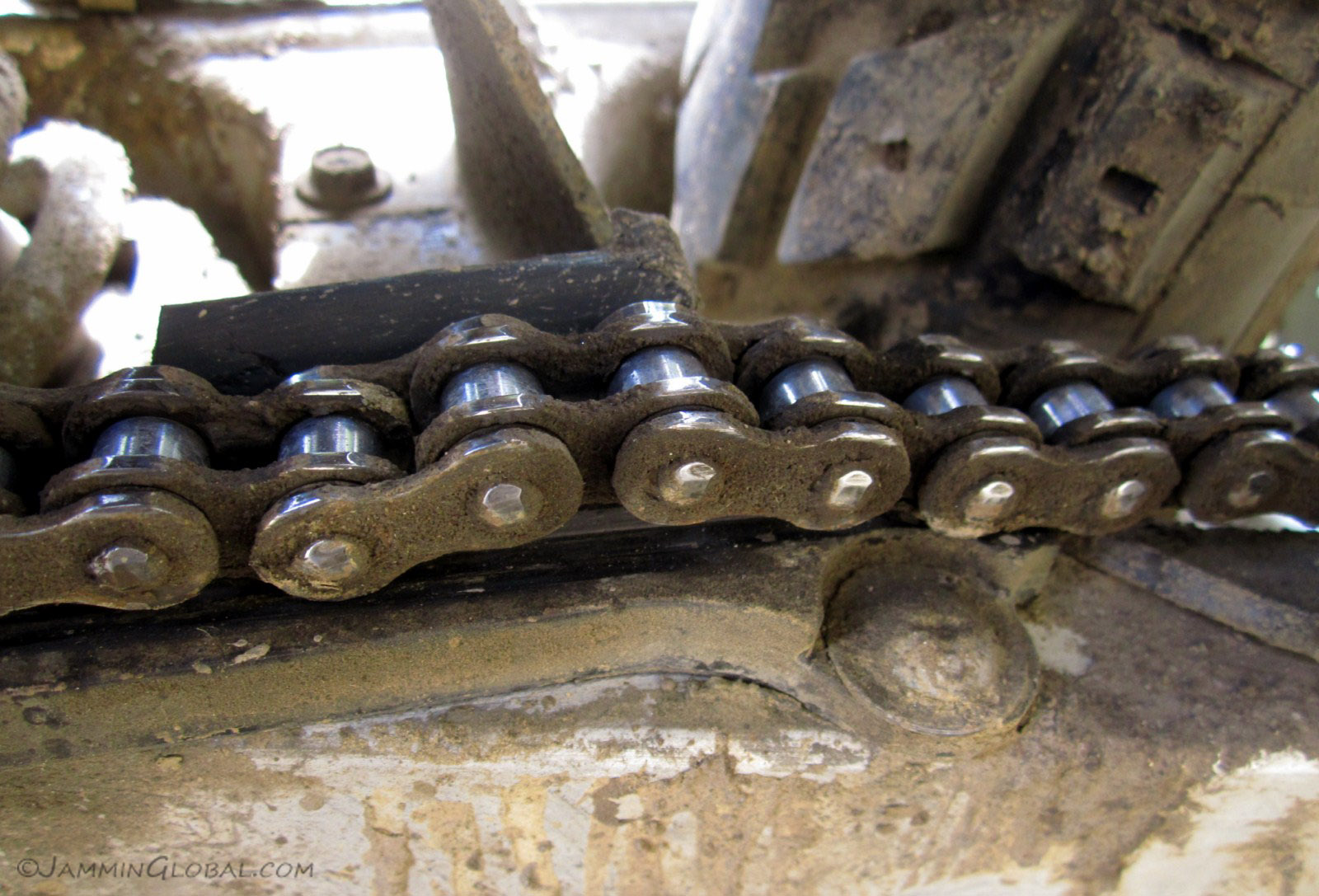 When there's a kink in the chain, it's time to replace it. This DID V8 chain was acquired and mounted in Santa Cruz, Bolivia, 23,500 kms (14,605 mi) ago. It saw me through the Lagunas Route in Bolivia, Ruta 40 in Argentina, Carretera Austral of Chile, then all the tarmac from Ushuaia into Europe, down Egypt, Sudan and then the Highlands of Ethiopia. sanDRina got a new DID V8 chain installed and the mechanic in me is always pleased when new parts are installed before the bike is subject to harsh conditions.
When there's a kink in the chain, it's time to replace it. This DID V8 chain was acquired and mounted in Santa Cruz, Bolivia, 23,500 kms (14,605 mi) ago. It saw me through the Lagunas Route in Bolivia, Ruta 40 in Argentina, Carretera Austral of Chile, then all the tarmac from Ushuaia into Europe, down Egypt, Sudan and then the Highlands of Ethiopia. sanDRina got a new DID V8 chain installed and the mechanic in me is always pleased when new parts are installed before the bike is subject to harsh conditions.
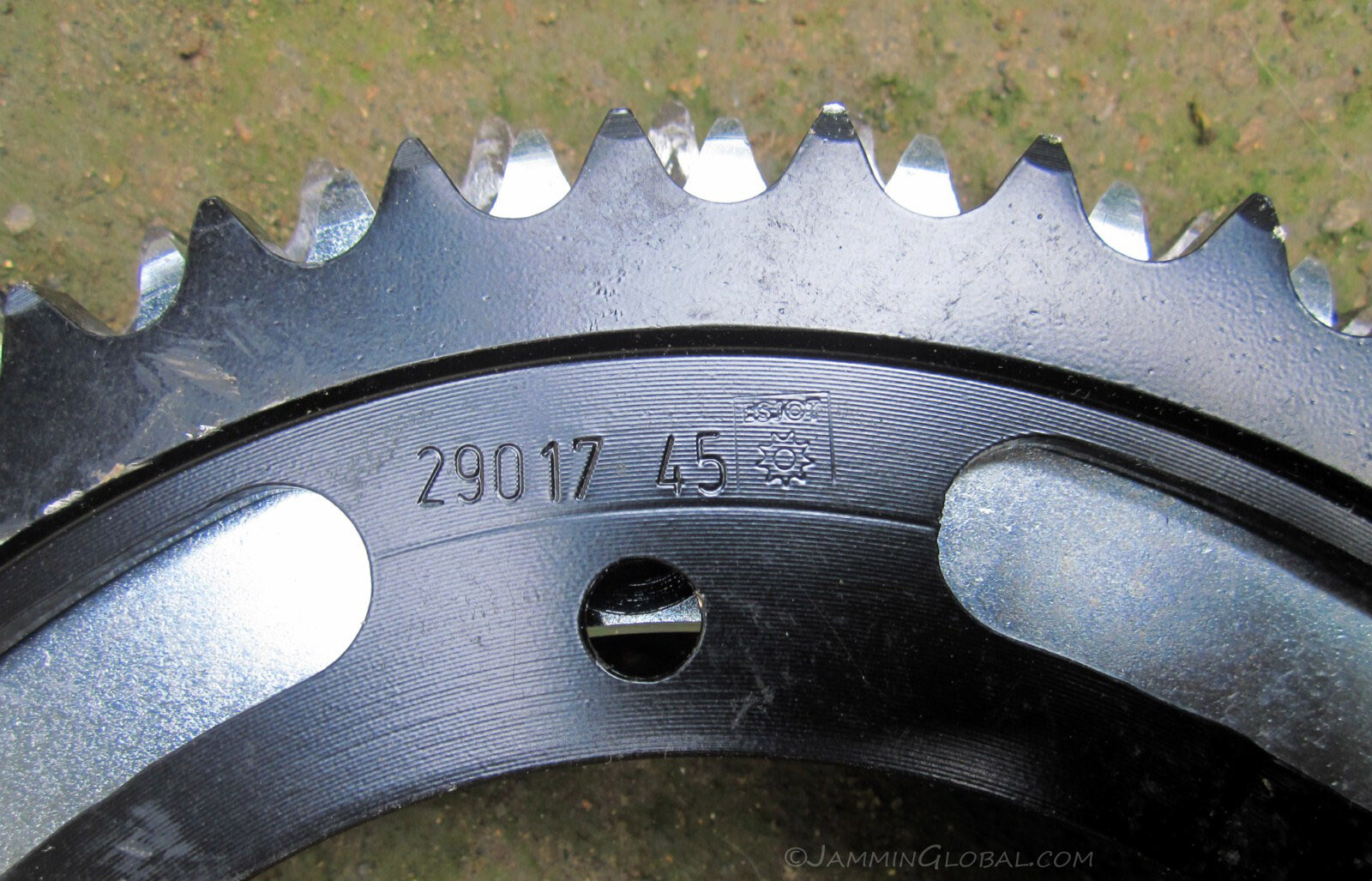 I usually run a 42 tooth rear sprocket (old one on the bottom, new 42 in the middle) but for the sandy and rocky route around Lake Turkana, sanDRina got a 45 tooth rear sprocket. For the non-gearheads, that means the bike will have more power (torque) at low speeds, which is good for crawling through sand and rocky sections. At the front, I was running a 14 tooth sprocket, so that my gearing was now set at 14/45, which is a big step up from the stock gearing on the DR, 15/42. Being lowered geared means that my top speed would be reduced (less top-end horsepower) but in exchange, my torque at the wheel is greatly increased (more low-end grunt).
I usually run a 42 tooth rear sprocket (old one on the bottom, new 42 in the middle) but for the sandy and rocky route around Lake Turkana, sanDRina got a 45 tooth rear sprocket. For the non-gearheads, that means the bike will have more power (torque) at low speeds, which is good for crawling through sand and rocky sections. At the front, I was running a 14 tooth sprocket, so that my gearing was now set at 14/45, which is a big step up from the stock gearing on the DR, 15/42. Being lowered geared means that my top speed would be reduced (less top-end horsepower) but in exchange, my torque at the wheel is greatly increased (more low-end grunt).
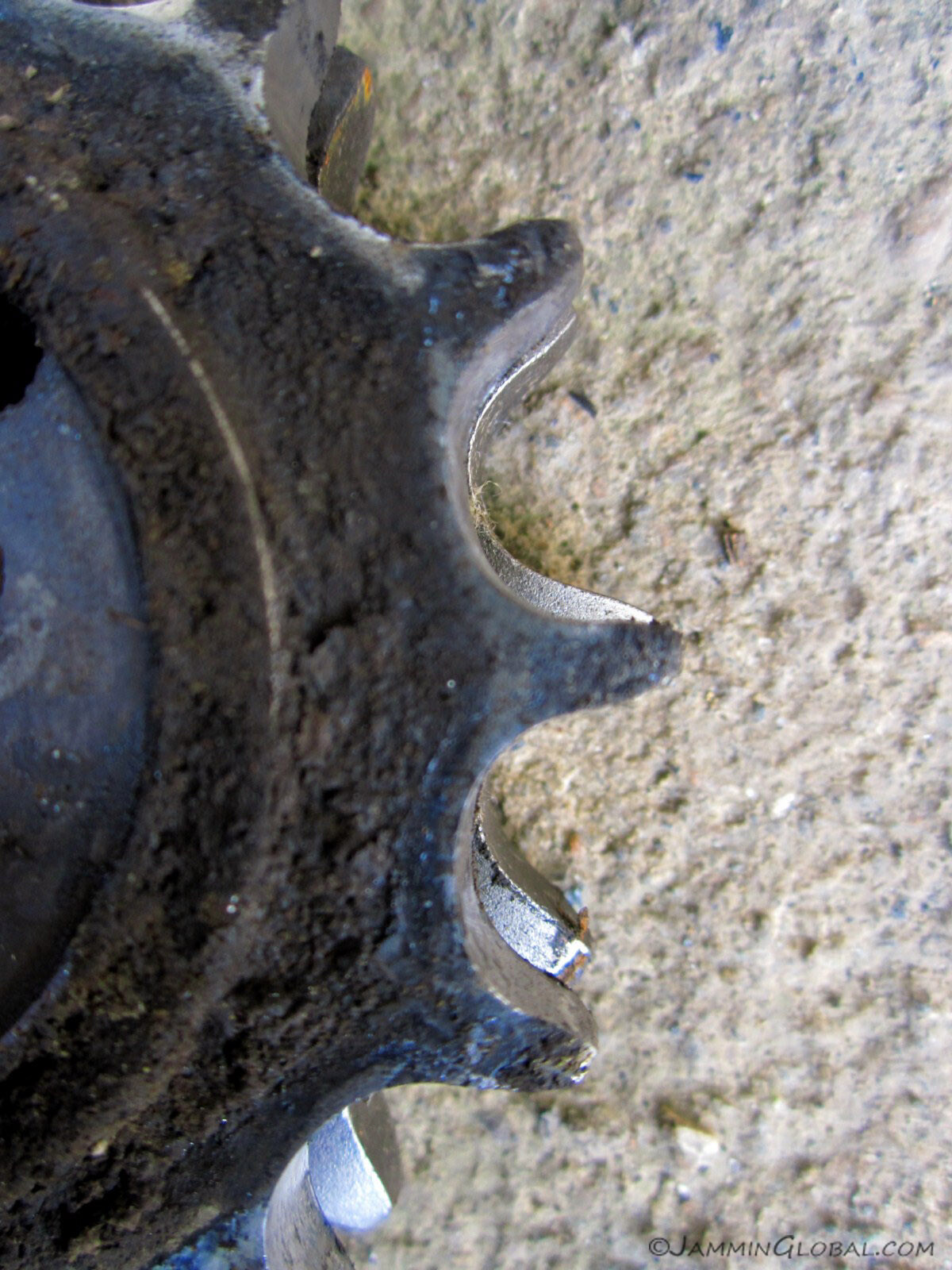 Comparing the old front sprocket (on top) that's being replaced by the new one (on bottom). As a sprocket wears out, the gap between the teeth increases as the chain constantly beats on the driven face of the tooth. The difference between the new sprocket and the old one is clearly visible. For the rider, newer parts mean a more direct feel when twisting the throttle and seeing the response from the rear wheel. Old, sloppy sprockets and chains deliver a very lose feeling, which isn't confidence-inspiring.
Comparing the old front sprocket (on top) that's being replaced by the new one (on bottom). As a sprocket wears out, the gap between the teeth increases as the chain constantly beats on the driven face of the tooth. The difference between the new sprocket and the old one is clearly visible. For the rider, newer parts mean a more direct feel when twisting the throttle and seeing the response from the rear wheel. Old, sloppy sprockets and chains deliver a very lose feeling, which isn't confidence-inspiring.
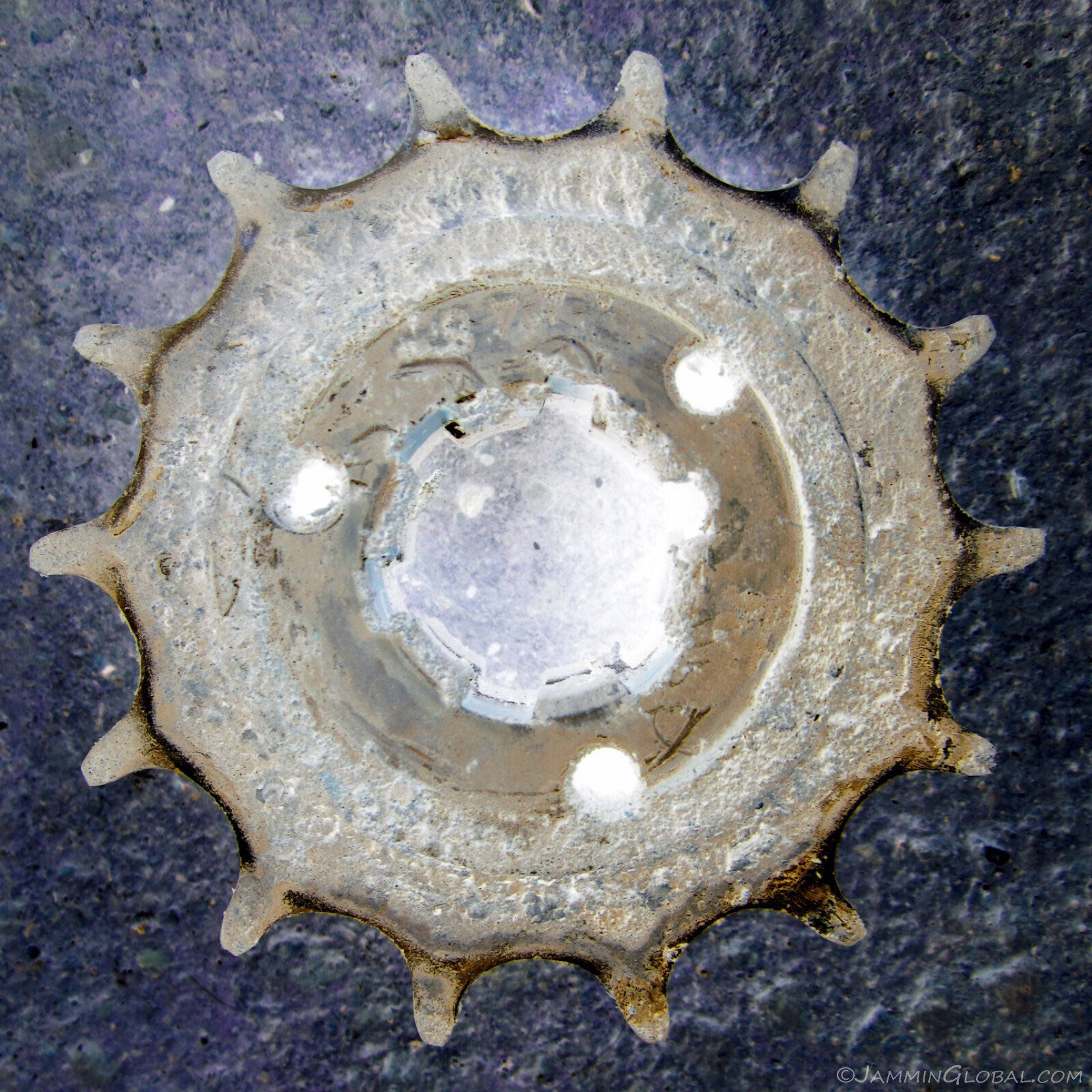 Some sprocket art. An inverted image of my used front sprocket where the hooks of the worn teeth give it the appearance of a chakra, a point of energy, which it is actually is since it translates the energy coming from the engine into the chain that then gets translated into the wheel by the rear sprocket and forward motion happens. It's beautiful how a motorcycle works.
Some sprocket art. An inverted image of my used front sprocket where the hooks of the worn teeth give it the appearance of a chakra, a point of energy, which it is actually is since it translates the energy coming from the engine into the chain that then gets translated into the wheel by the rear sprocket and forward motion happens. It's beautiful how a motorcycle works.
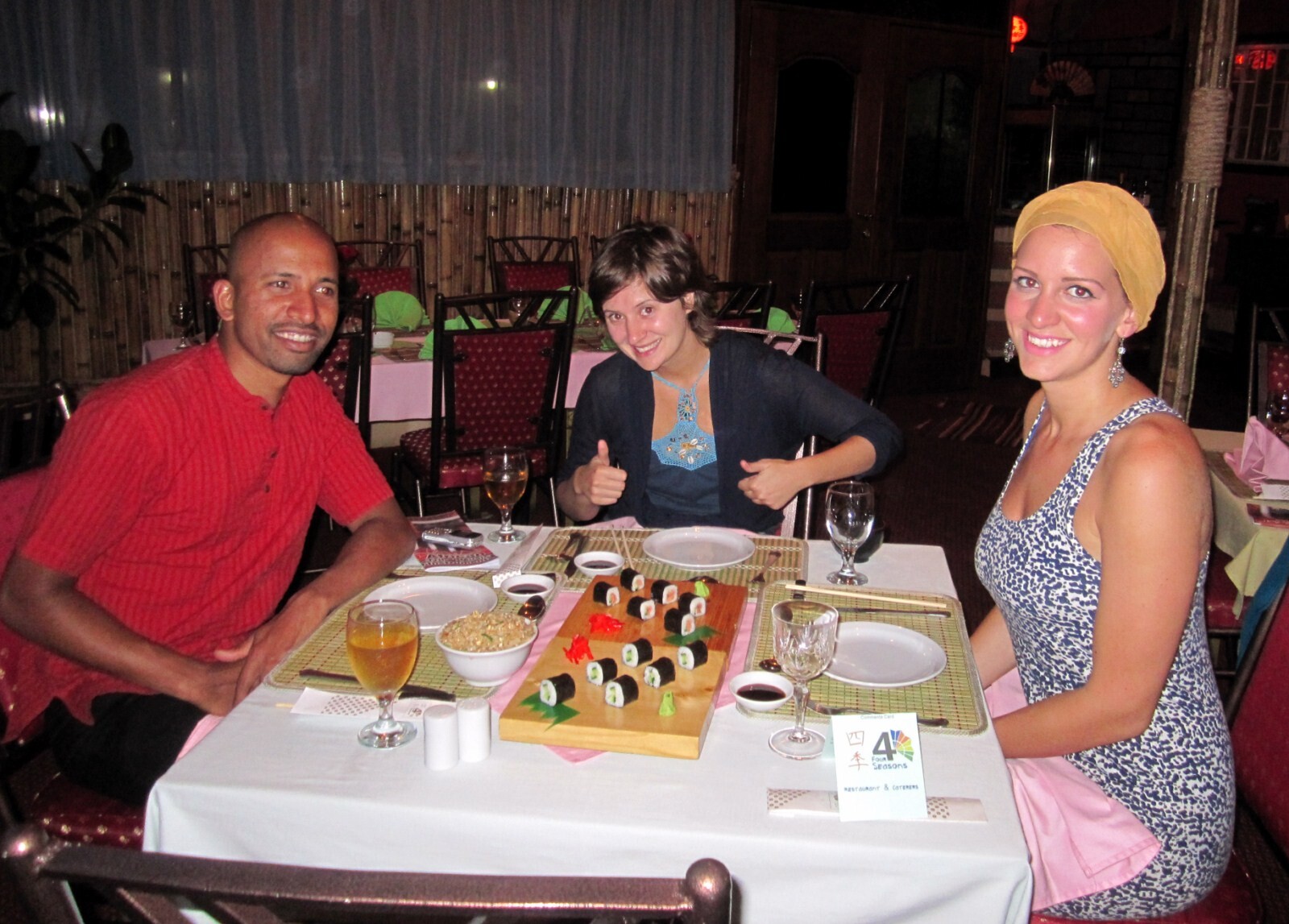 Meeting up with Sadie and Nicola for a fancy dinner of sushi on a night out in Addis. Sadie is a friend of Shridhar's (Indian DR friend in San Francisco) who was based in Addis for three months working with a company that produces business documentaries. She had traveled quite a bit of Africa through her work, recently visiting Sierra Leone and Mozambique. Nicola is a traveler I met earlier in Lalibela, who was backpacking the Horn of Africa before going back to medical school in Halifax. This was the fanciest meal any of us had had in a long while.
Meeting up with Sadie and Nicola for a fancy dinner of sushi on a night out in Addis. Sadie is a friend of Shridhar's (Indian DR friend in San Francisco) who was based in Addis for three months working with a company that produces business documentaries. She had traveled quite a bit of Africa through her work, recently visiting Sierra Leone and Mozambique. Nicola is a traveler I met earlier in Lalibela, who was backpacking the Horn of Africa before going back to medical school in Halifax. This was the fanciest meal any of us had had in a long while.
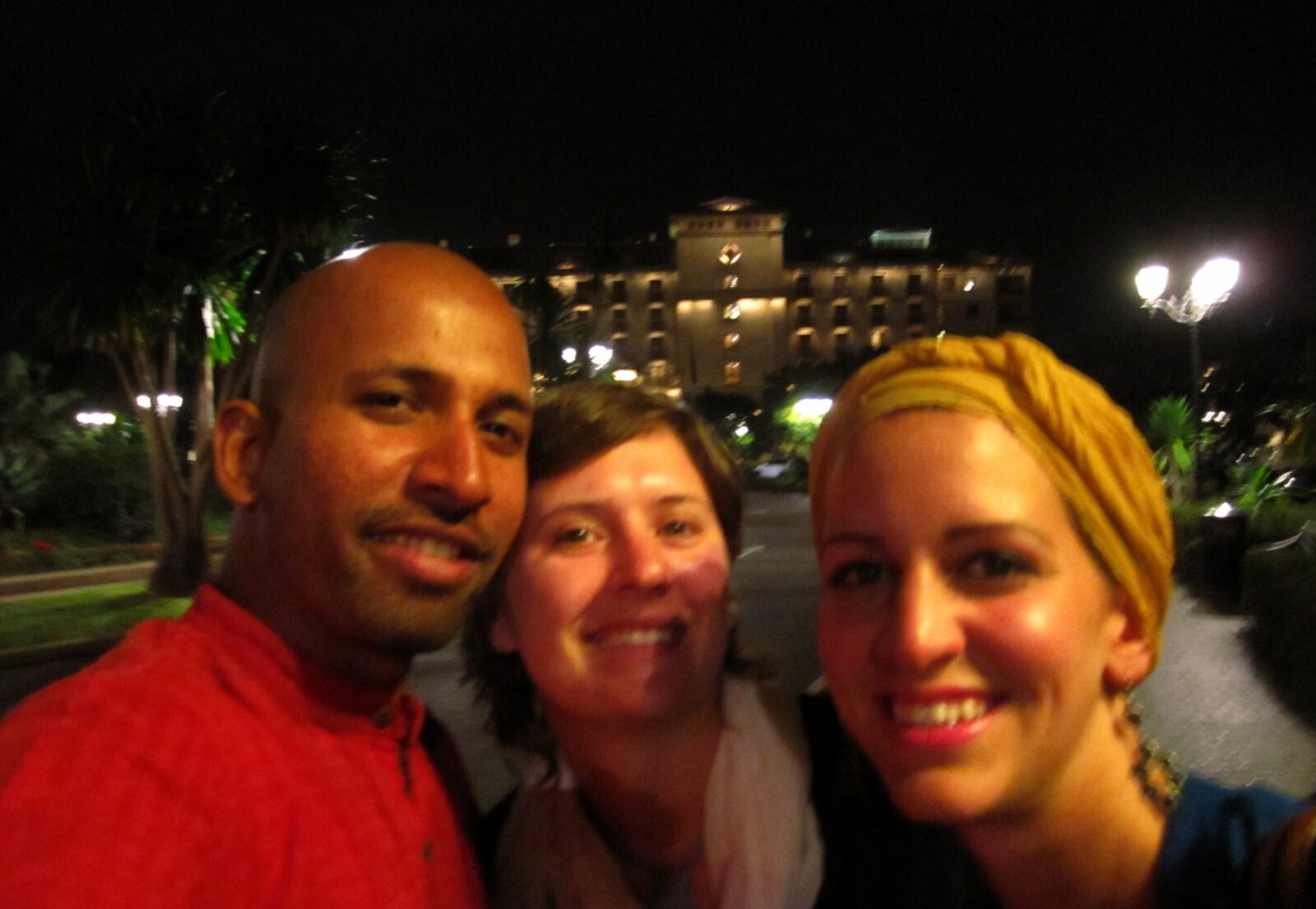 Heading to the Sheraton in Addis, the swankiest hotel in town and supposedly all of Sub-Saharan Africa for an RnB show that Nicola heard of. The cheapest rooms in this five-star hotel go for a couple hundred dollars a night, equaling my total expenditure on lodging for this whole trip. But you got to walk in like you own the place.
Heading to the Sheraton in Addis, the swankiest hotel in town and supposedly all of Sub-Saharan Africa for an RnB show that Nicola heard of. The cheapest rooms in this five-star hotel go for a couple hundred dollars a night, equaling my total expenditure on lodging for this whole trip. But you got to walk in like you own the place.
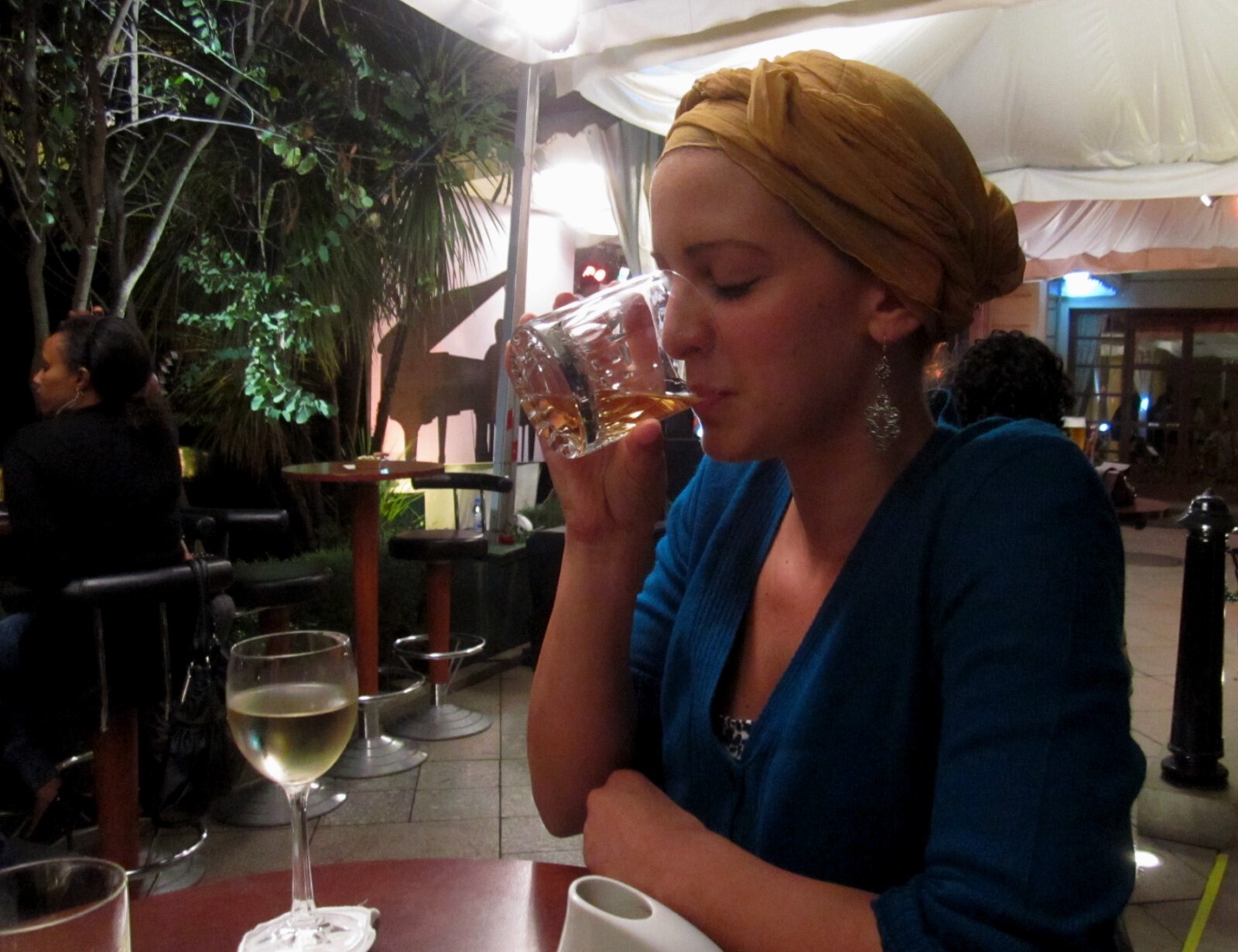 Nicola taking a sip of the single malt scotches that Sadie and I were enjoying. For being a fancy hotel, drinks were very cheap. Sadie and I shared five pegs of whisky between us that cost just 150 Birr (\$8.90).
Nicola taking a sip of the single malt scotches that Sadie and I were enjoying. For being a fancy hotel, drinks were very cheap. Sadie and I shared five pegs of whisky between us that cost just 150 Birr (\$8.90).
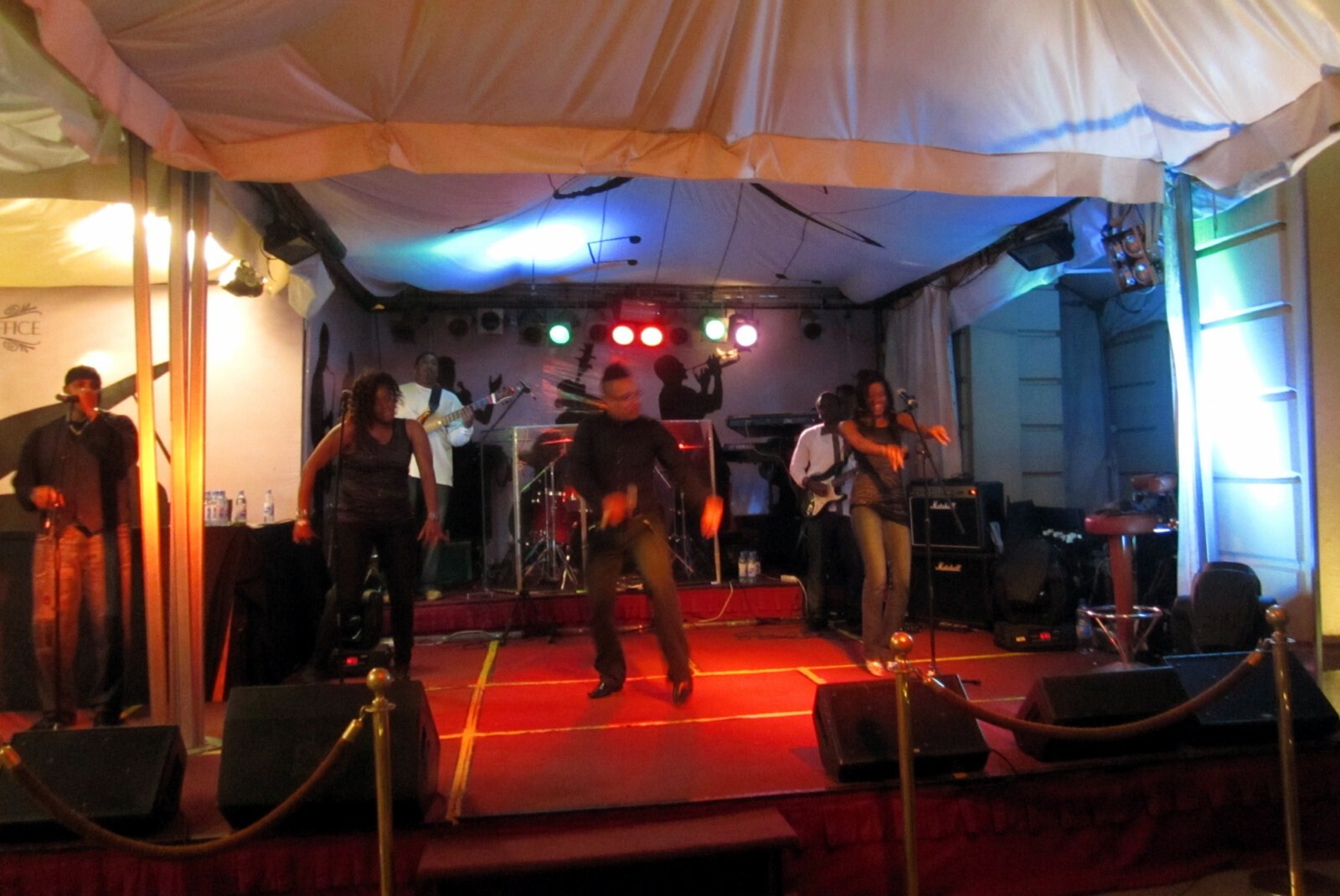 The Celebration Club from Atlanta putting on a good show at the Sheraton. Nicola met the band when they were performing in the town of Bahir Dar.
The Celebration Club from Atlanta putting on a good show at the Sheraton. Nicola met the band when they were performing in the town of Bahir Dar.
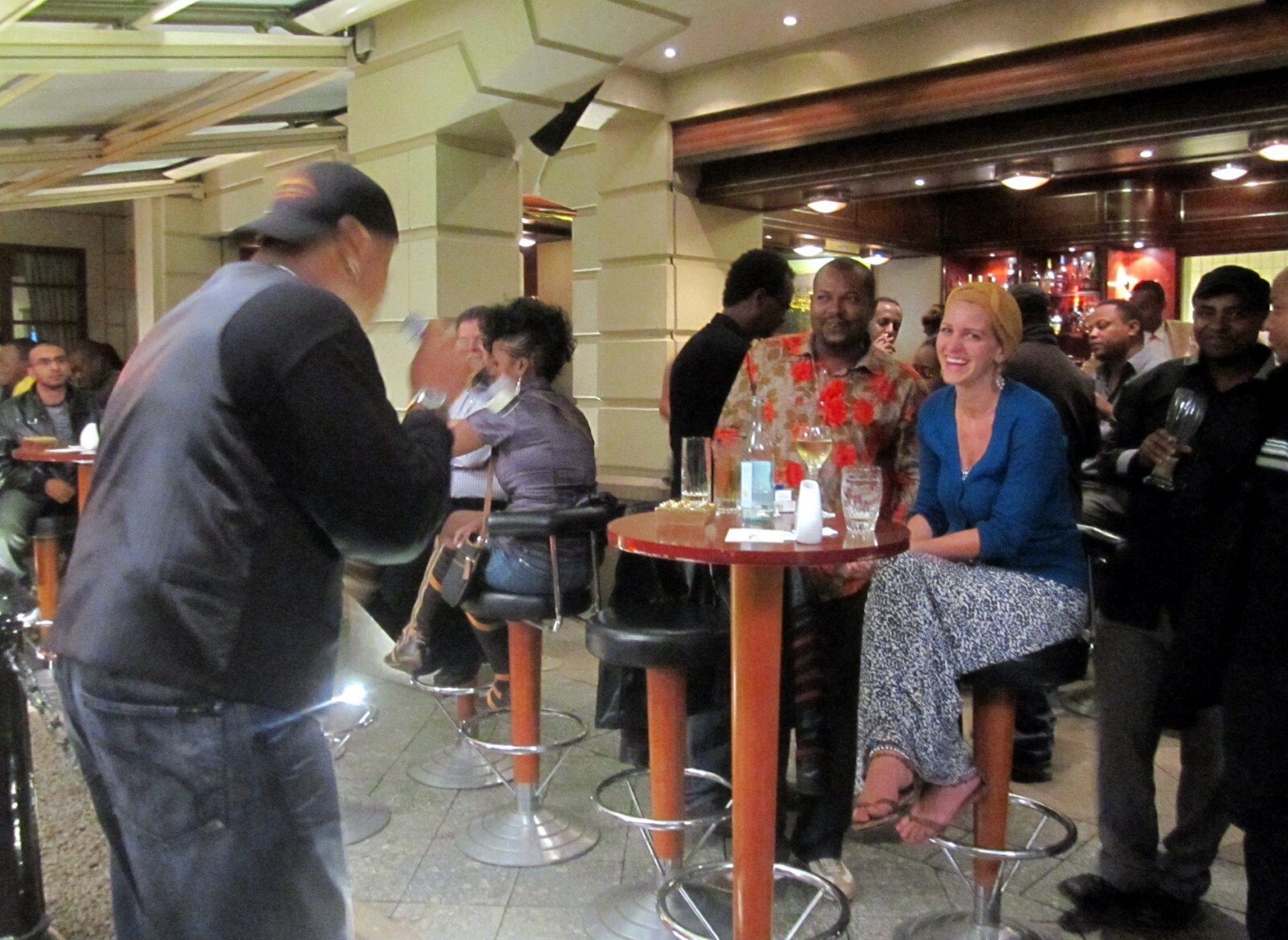 Nicola being serenaded by a band member. A fun night and nice to enjoy some night life after a long while.
Nicola being serenaded by a band member. A fun night and nice to enjoy some night life after a long while.
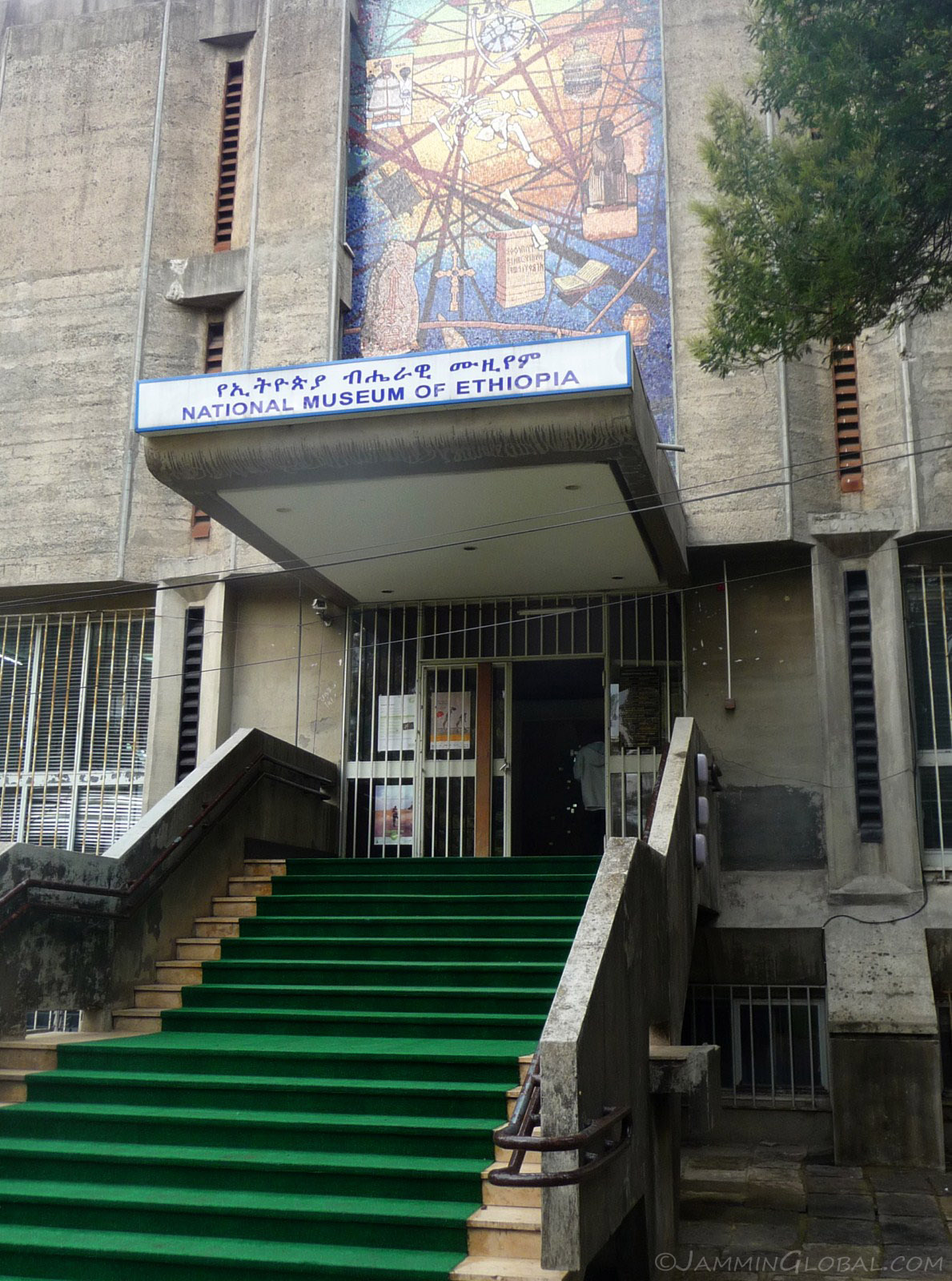 Paying a visit to the National Museum of Ethiopia, housing the most famous hominin skeleton...
Paying a visit to the National Museum of Ethiopia, housing the most famous hominin skeleton...
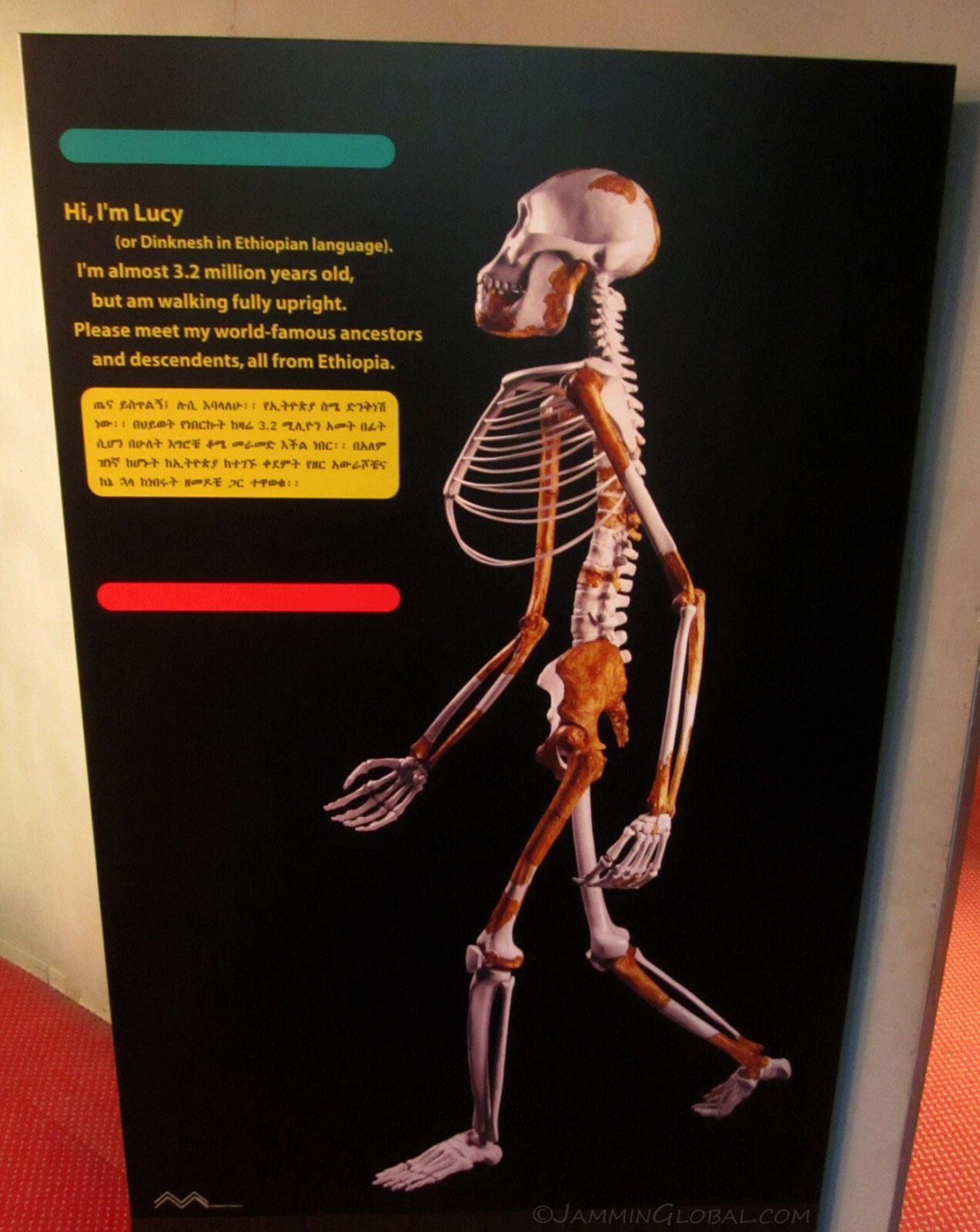 ...Lucy, a 3.2 million year old hominin fossil unearthed in the Afar region of Ethiopia in 1974. Lucy was a very interesting find and caused the stir that she did because she had a brain that was similar in size to an ape but her skeleton revealed that she definitely walked upright, a clear indication that modern humans evolved from a common ancestor with apes.
...Lucy, a 3.2 million year old hominin fossil unearthed in the Afar region of Ethiopia in 1974. Lucy was a very interesting find and caused the stir that she did because she had a brain that was similar in size to an ape but her skeleton revealed that she definitely walked upright, a clear indication that modern humans evolved from a common ancestor with apes.
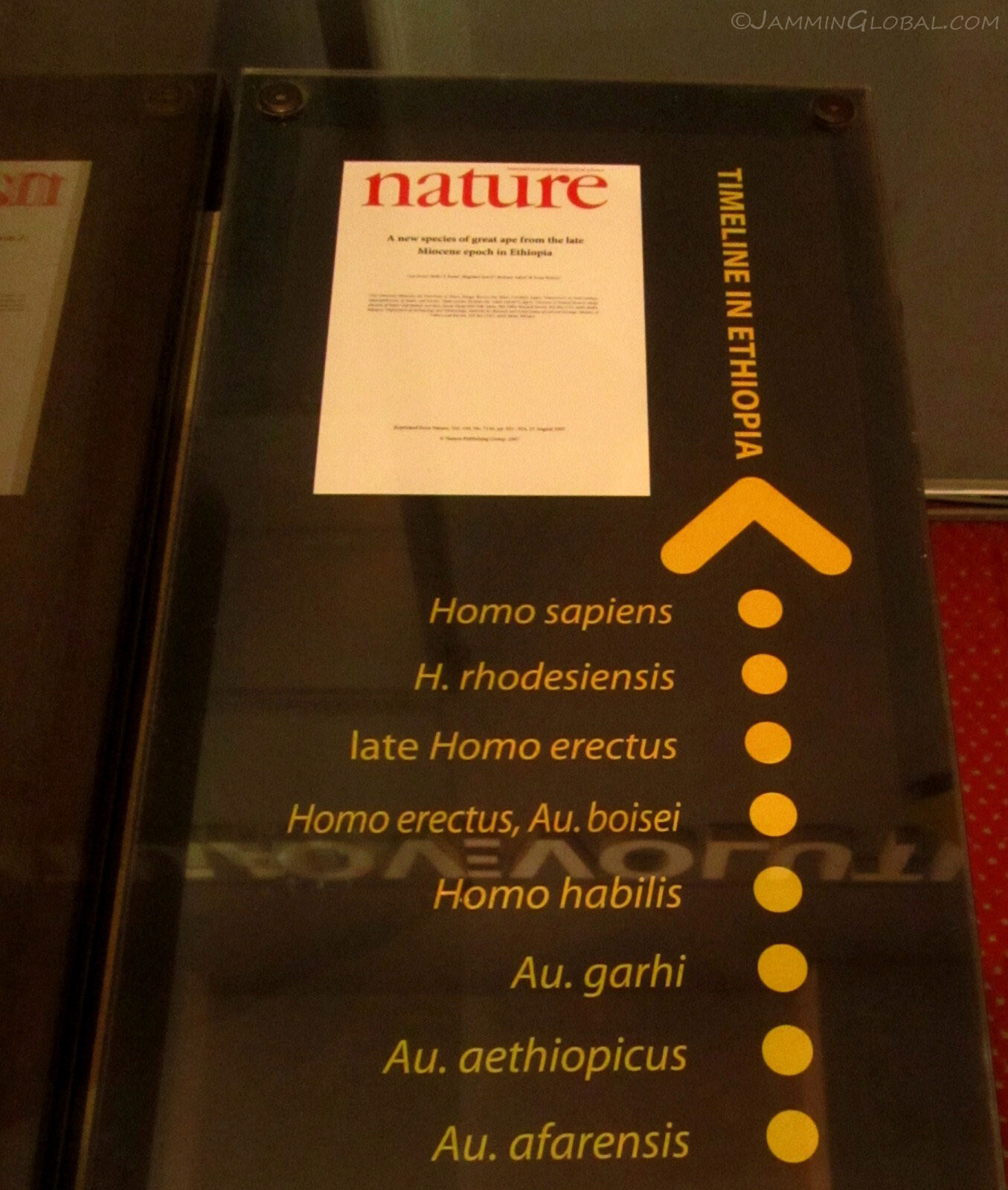 The human evolution exhibit at the museum was very detailed and informational. This timeline puts into place all the various hominin species that have been discovered, so far. Lucy's species is called Australopithecus afarensis and us, modern humans are homo sapiens. It's a bit confusing in that we did not evolve from Lucy just as we did not evolve from chimpanzees. It's just that we share a common ancestor with all these hominins at some point in the past.
The human evolution exhibit at the museum was very detailed and informational. This timeline puts into place all the various hominin species that have been discovered, so far. Lucy's species is called Australopithecus afarensis and us, modern humans are homo sapiens. It's a bit confusing in that we did not evolve from Lucy just as we did not evolve from chimpanzees. It's just that we share a common ancestor with all these hominins at some point in the past.
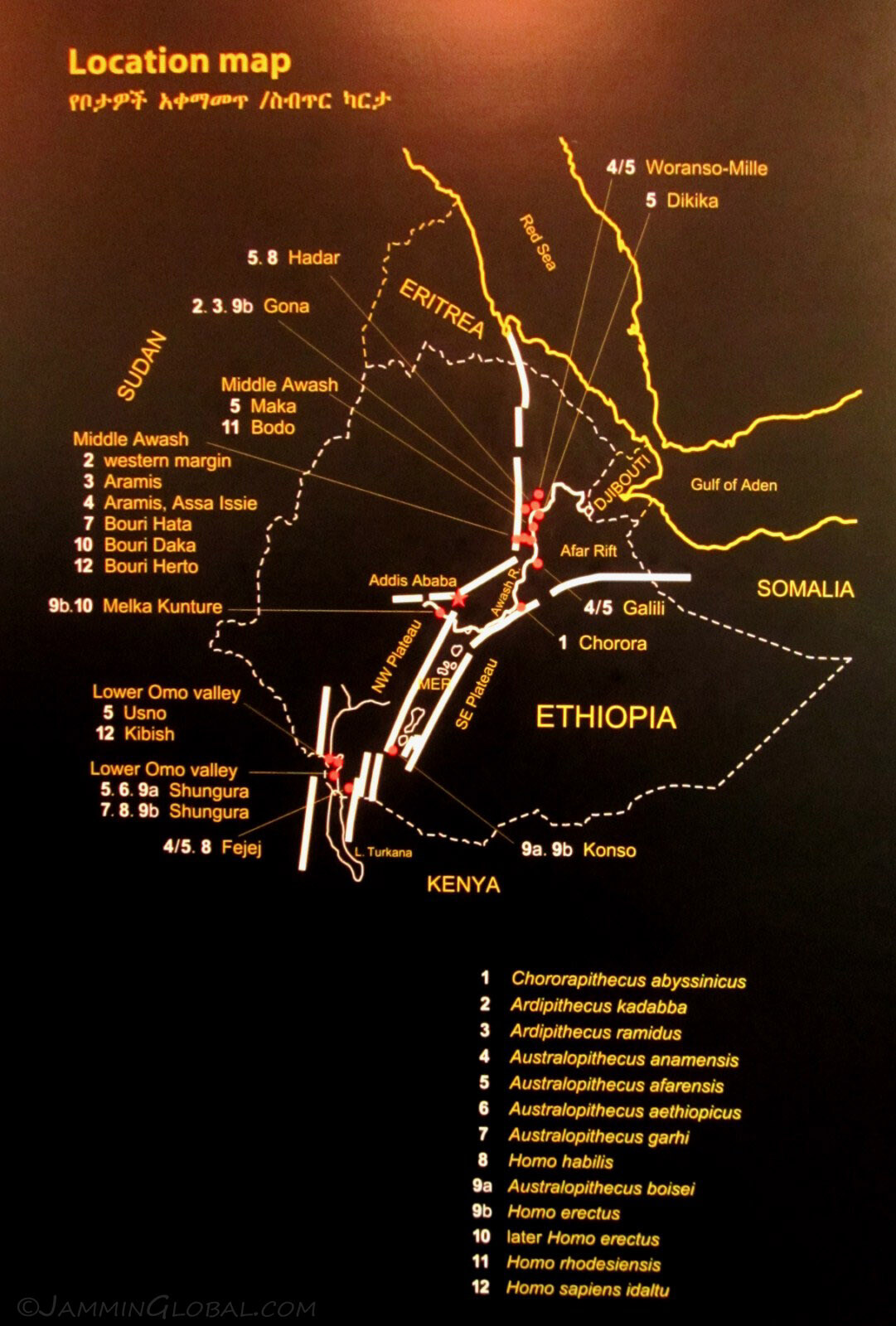 A map showing the location of hominin fossil finds in Ethiopia, that all lie in the East African Rift. Ethiopia, down into Kenya and Tanzania have been a rich source of hominin fossils because the rifting creates an ideal environment for fossil preservation. As the Somalia Plate tears East Africa away from the African Plate, the highlands on the edge of the rift create a lot of sediment that packs in hominin skeletons for future discovery. It also helps that there are many volcanoes in this region, as ash is a great preserver of fossils.
A map showing the location of hominin fossil finds in Ethiopia, that all lie in the East African Rift. Ethiopia, down into Kenya and Tanzania have been a rich source of hominin fossils because the rifting creates an ideal environment for fossil preservation. As the Somalia Plate tears East Africa away from the African Plate, the highlands on the edge of the rift create a lot of sediment that packs in hominin skeletons for future discovery. It also helps that there are many volcanoes in this region, as ash is a great preserver of fossils.
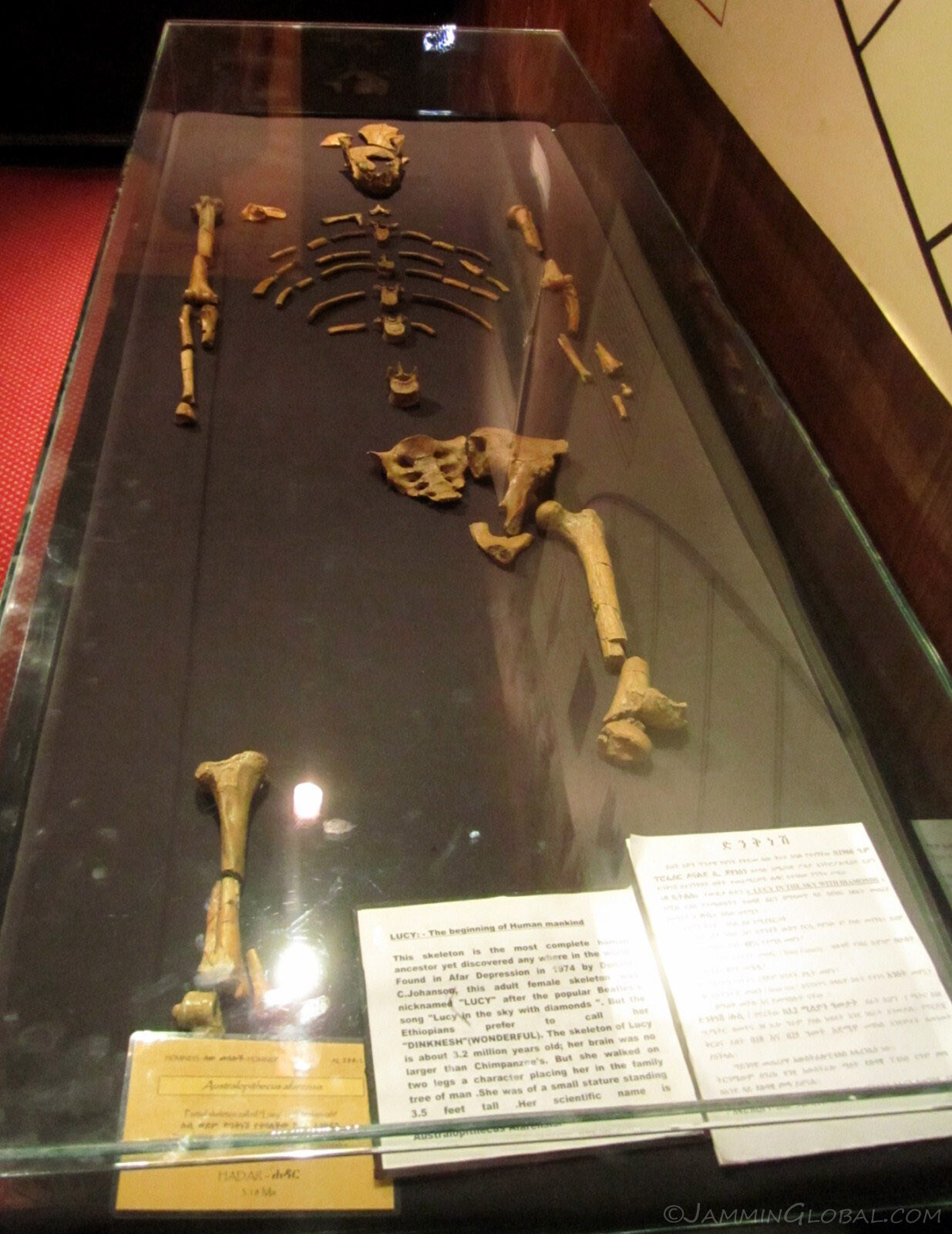 A plaster replica of all the bones that comprise the hominin fossil known as Lucy. The original skeleton is housed at the museum but not on public display. The amazing thing about Lucy's skeleton is the amount of bones that were discovered to have come from one hominin. Most hominin fossil finds consist of just a fragment of a bone from which many details have to be deduced. The almost 40% complete skeleton revealed a ton of information on human evolution.
A plaster replica of all the bones that comprise the hominin fossil known as Lucy. The original skeleton is housed at the museum but not on public display. The amazing thing about Lucy's skeleton is the amount of bones that were discovered to have come from one hominin. Most hominin fossil finds consist of just a fragment of a bone from which many details have to be deduced. The almost 40% complete skeleton revealed a ton of information on human evolution.
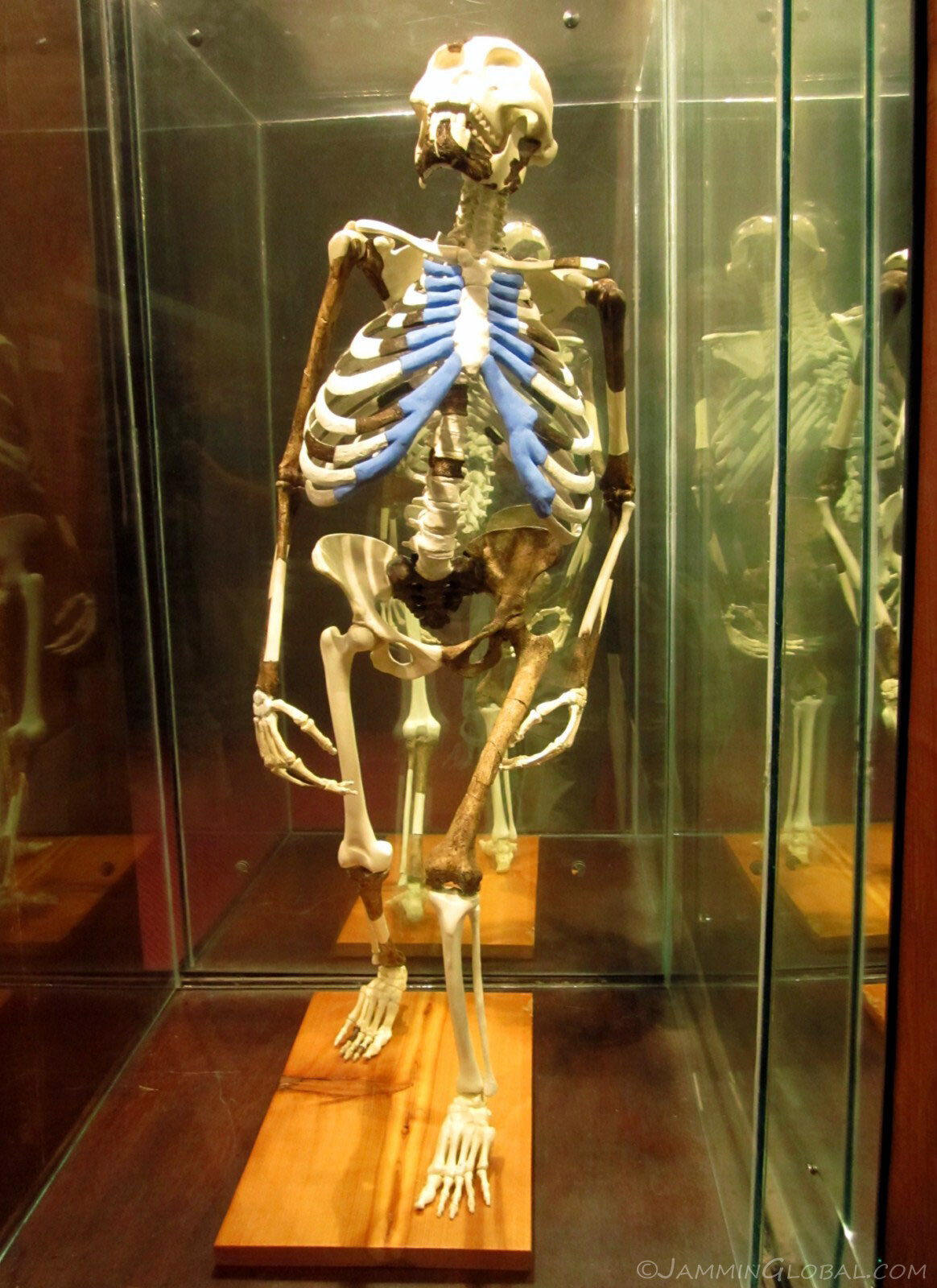 An upright skeleton reconstruction of Lucy. The brown parts are all the bones that were discovered and the white are the ones that have been deduced. Finding her pelvic bone and pieces of her spinal cord showed that Lucy walked upright, but her jaw bones revealed that her brain size was similar to that of an adult chimpanzee.
An upright skeleton reconstruction of Lucy. The brown parts are all the bones that were discovered and the white are the ones that have been deduced. Finding her pelvic bone and pieces of her spinal cord showed that Lucy walked upright, but her jaw bones revealed that her brain size was similar to that of an adult chimpanzee.
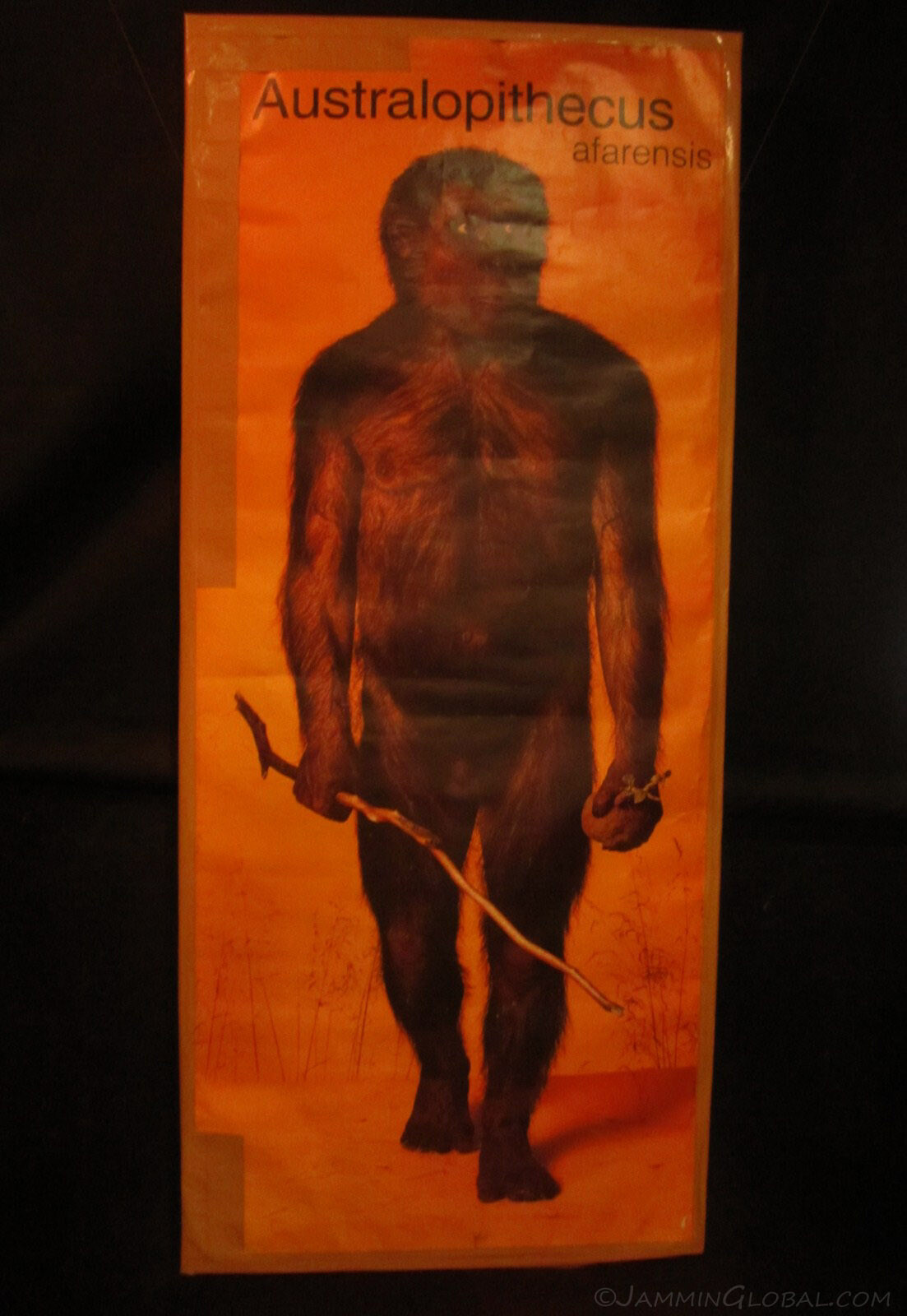 This is how evolutionary anthropologists envision Lucy would've looked, a hairy ape that walked upright and had a protruding jaw. Us modern humans slowly lost our body hair as we evolved the ability to sweat to keep our bodies cool, as hair primarily serves the function of protection from solar radiation, which I completely understand having shed all that natural protection on my scalp.
This is how evolutionary anthropologists envision Lucy would've looked, a hairy ape that walked upright and had a protruding jaw. Us modern humans slowly lost our body hair as we evolved the ability to sweat to keep our bodies cool, as hair primarily serves the function of protection from solar radiation, which I completely understand having shed all that natural protection on my scalp.
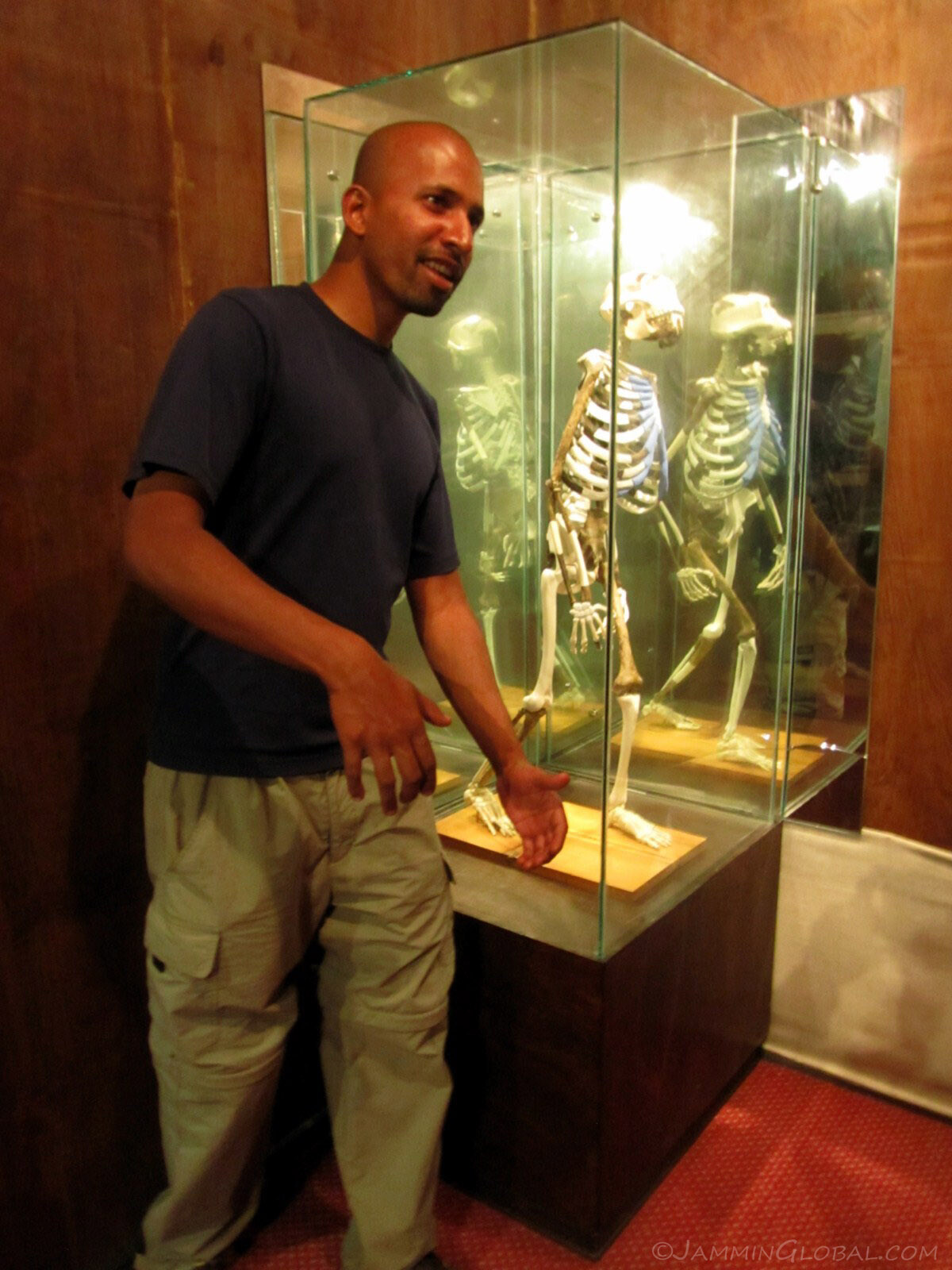 Lucy and I, showing just how small Lucy is. Lucy's brain volume is around 500 ml (17 oz) and a modern human's brain volume is around 1,250 ml (42 oz), but it's not all about brain size as it's what you do with your brain that matters.
Lucy and I, showing just how small Lucy is. Lucy's brain volume is around 500 ml (17 oz) and a modern human's brain volume is around 1,250 ml (42 oz), but it's not all about brain size as it's what you do with your brain that matters.
 Outside the museum, an old Lada celebrating the recent millennium in Ethiopia's calendar, which is about 8 years behind the Julian calendar due to a difference in calculating when Jesus was supposed to have been conceived.
Outside the museum, an old Lada celebrating the recent millennium in Ethiopia's calendar, which is about 8 years behind the Julian calendar due to a difference in calculating when Jesus was supposed to have been conceived.
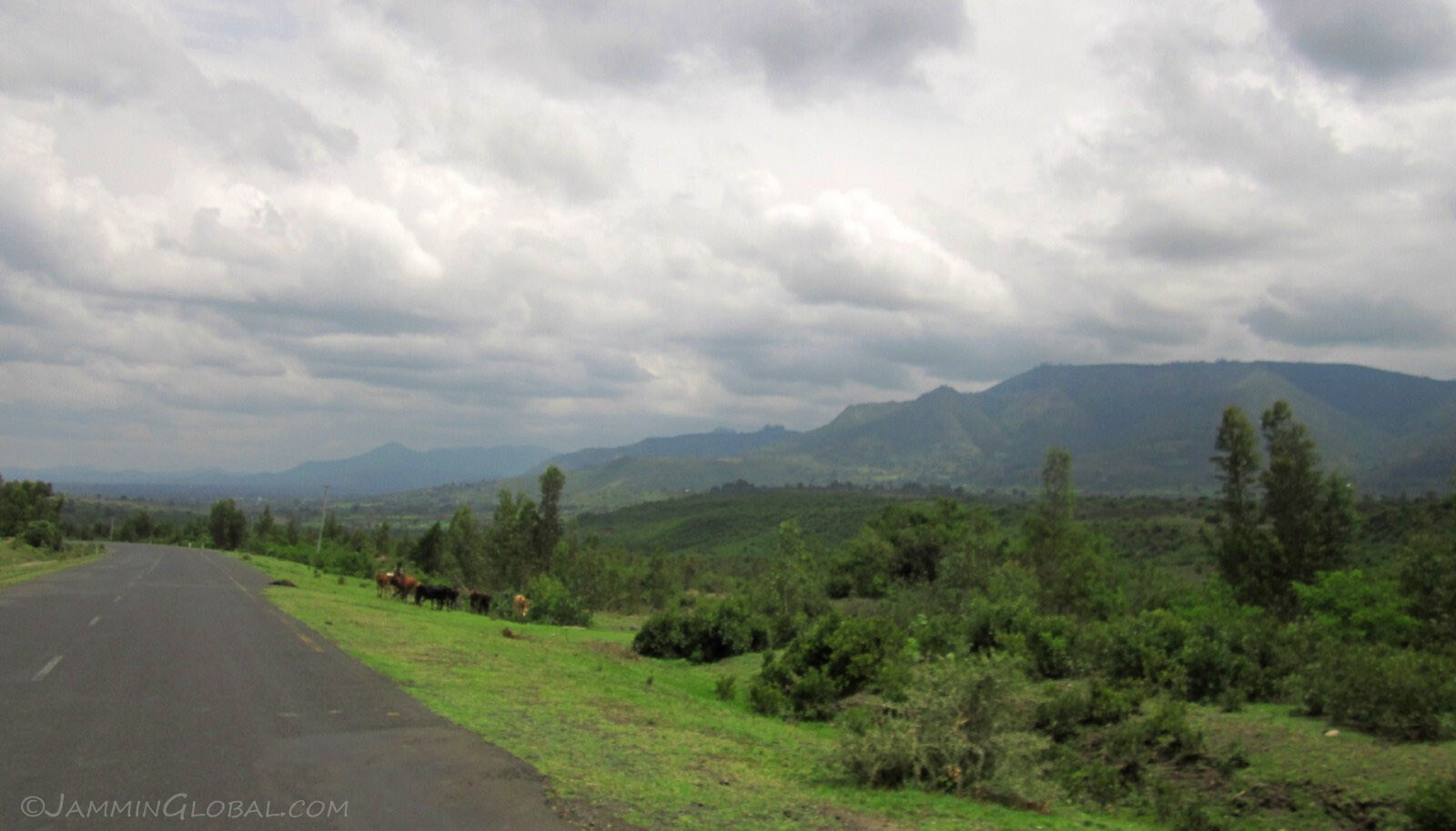 After my few days in Addis, I headed south and enjoyed the mountainous views.
After my few days in Addis, I headed south and enjoyed the mountainous views.
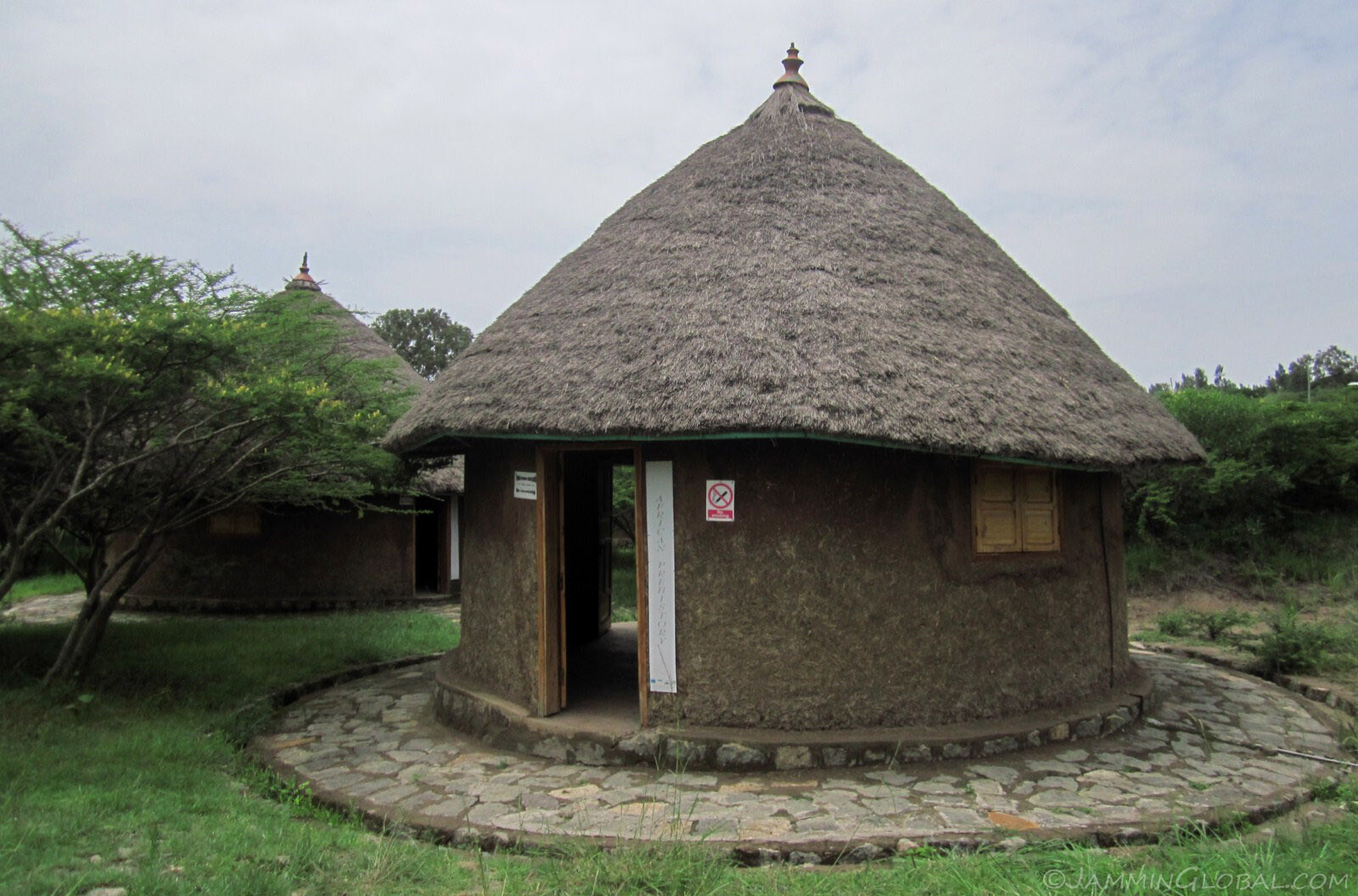 About an hour south of Addis lies the Melka Kunture Paleolithic site, where many stone tools were discovered from 1963 onwards dating across various hominin groups from as early as 1.7 million years ago.
About an hour south of Addis lies the Melka Kunture Paleolithic site, where many stone tools were discovered from 1963 onwards dating across various hominin groups from as early as 1.7 million years ago.
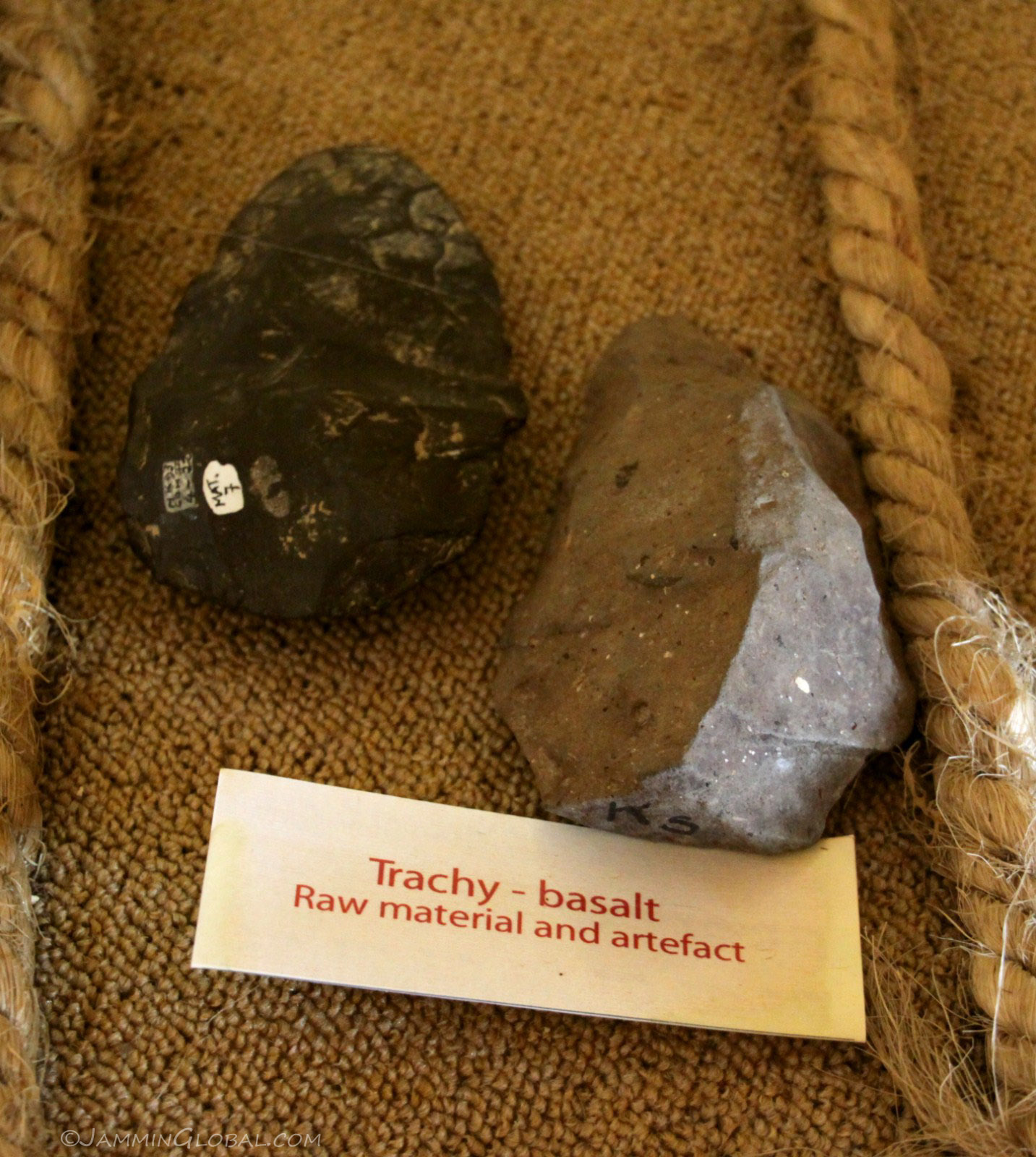 A display at the Melka Kunture museum showing the raw material of volcanic rock and a tool that was discovered in the area. By dating the soils that the tool was found in, scientists can determine when the tool was made and since no other animals have been observed to make such precise tools, these artefacts are credited to early humans.
A display at the Melka Kunture museum showing the raw material of volcanic rock and a tool that was discovered in the area. By dating the soils that the tool was found in, scientists can determine when the tool was made and since no other animals have been observed to make such precise tools, these artefacts are credited to early humans.
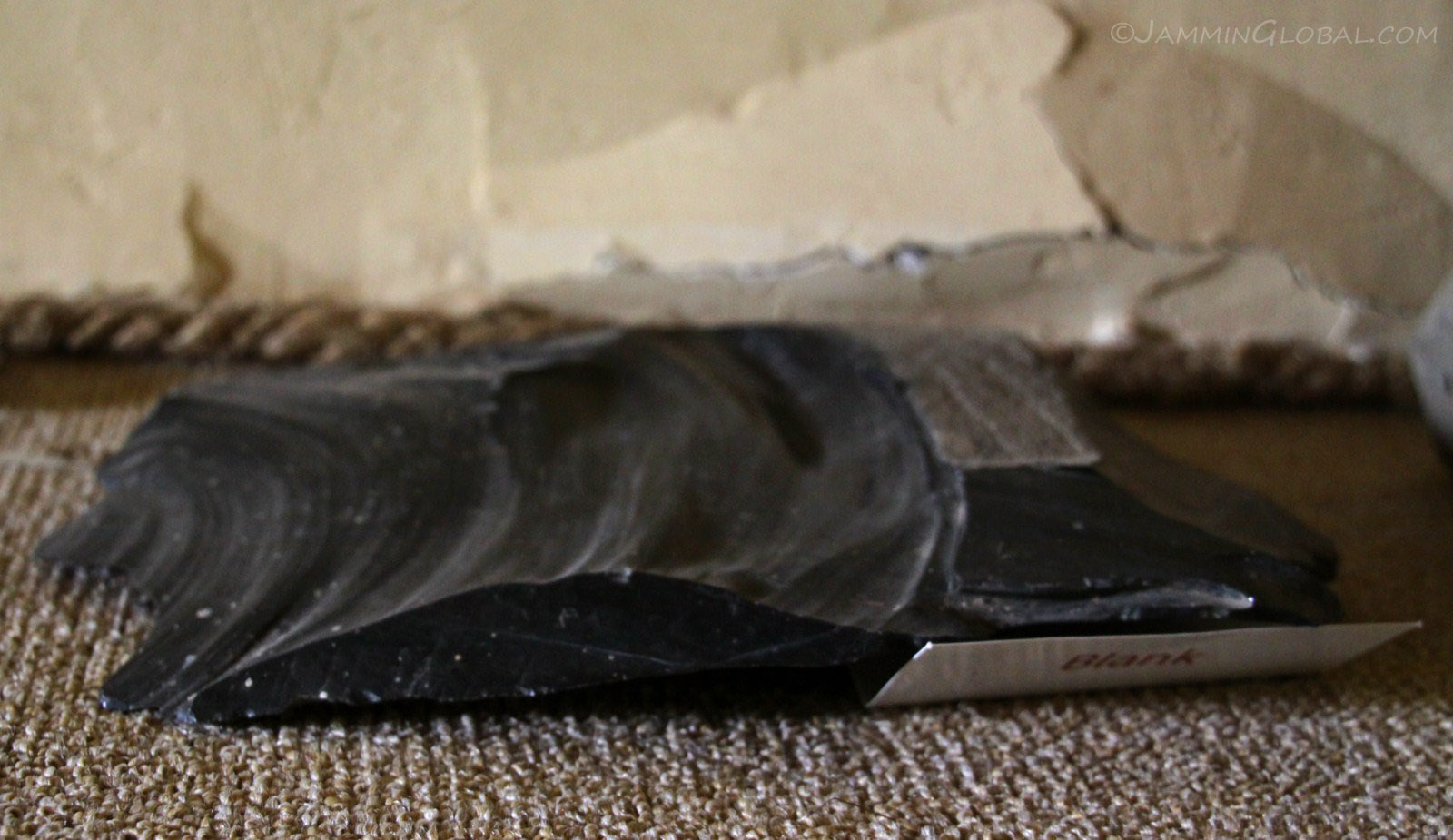 Being in the East African Rift, this is a volcanic area that produced rocks such as this blank from which early humans shaped...
Being in the East African Rift, this is a volcanic area that produced rocks such as this blank from which early humans shaped...
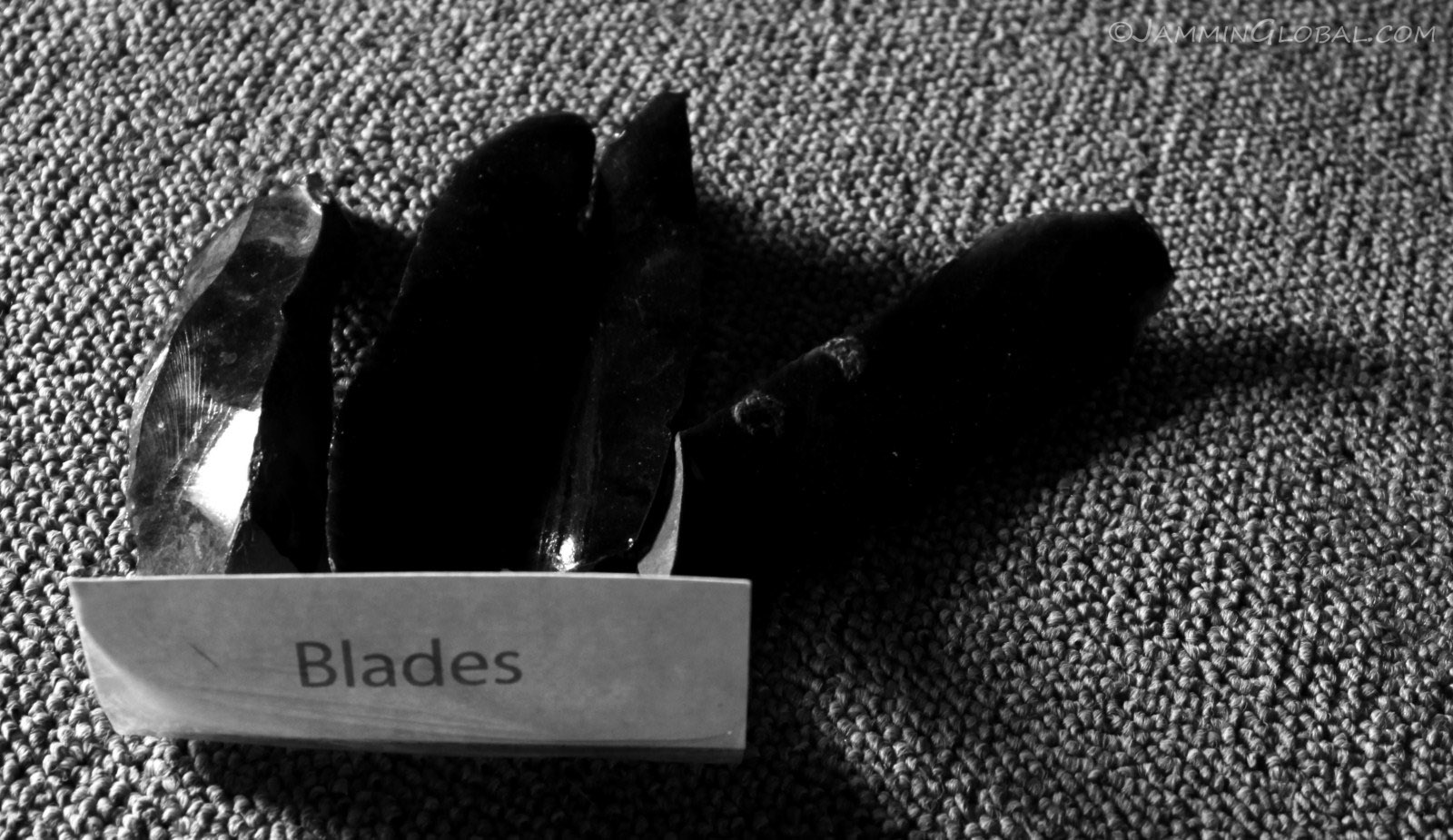 ...blades and other tools from. This allowed our ancestors to make weapons for hunting animals and subsequently to tear off the meat and eat the dense protein that lead to our large brain size, in comparison to other primates. There are many other factors for why only humans developed such ability for tool-making, but there's definitely a correlation between eating meat and growing large brains. This allowed our ancestors to evolve the intelligence that lead to our current civilization.
...blades and other tools from. This allowed our ancestors to make weapons for hunting animals and subsequently to tear off the meat and eat the dense protein that lead to our large brain size, in comparison to other primates. There are many other factors for why only humans developed such ability for tool-making, but there's definitely a correlation between eating meat and growing large brains. This allowed our ancestors to evolve the intelligence that lead to our current civilization.
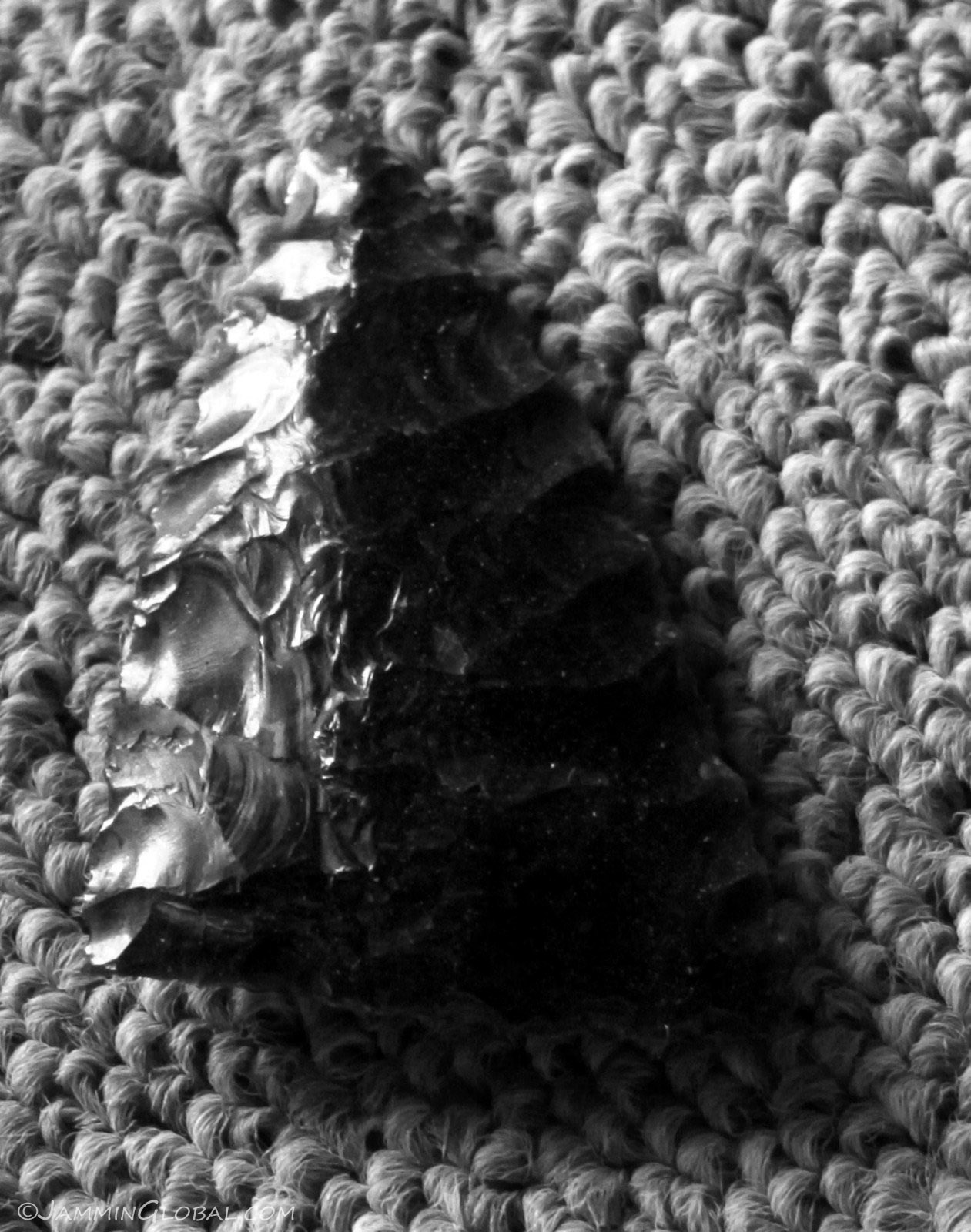 A beautifully-made spear head from volcanic basalt rock.
A beautifully-made spear head from volcanic basalt rock.
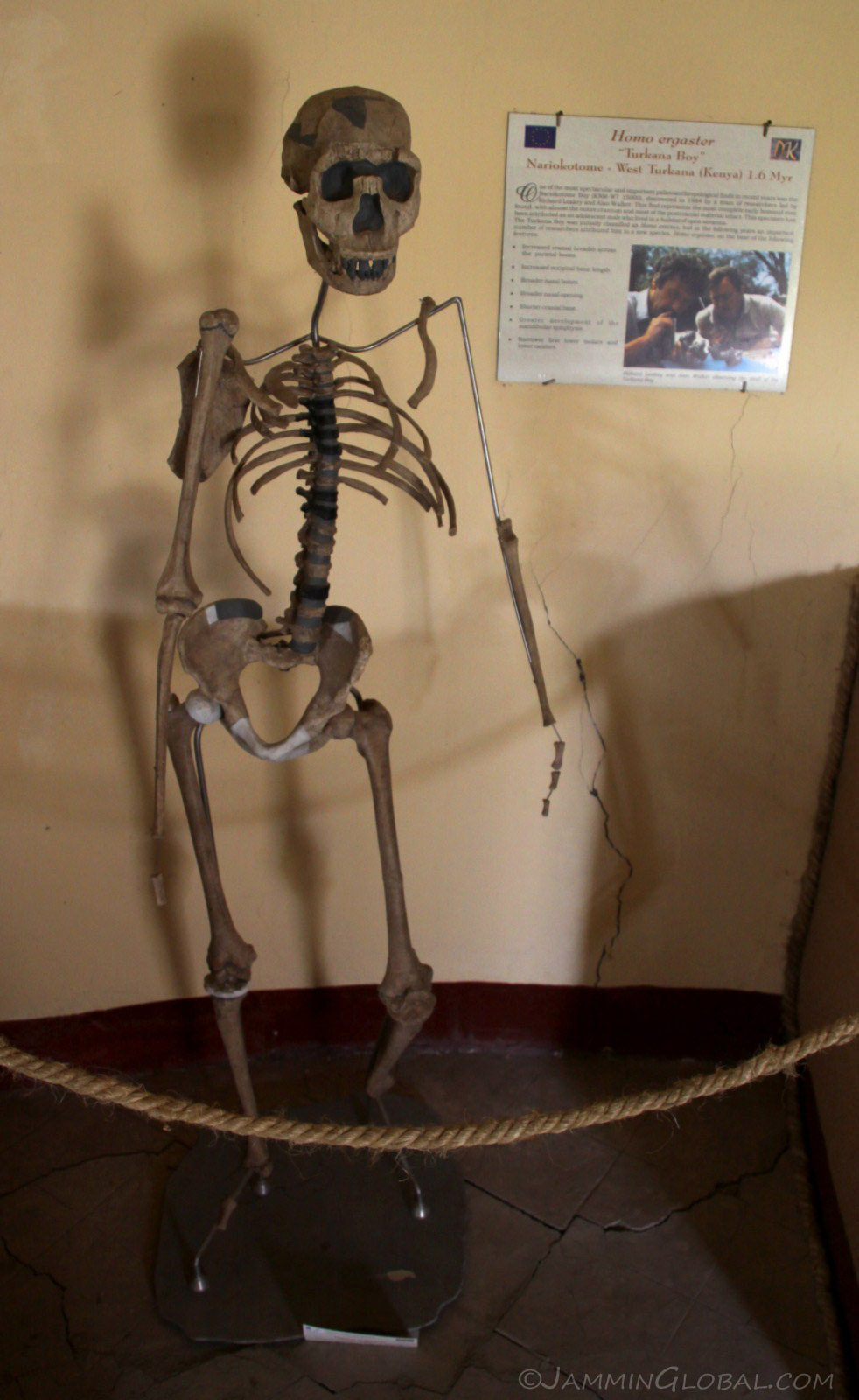 The museum also housed various other exhibits on human evolution and here's a replica of Turkana Boy, a 1.5 million year old hominid that was discovered in 1984 near Lake Turkana, where I was headed next. This is the most-complete skeleton discovered, so far, of an early human. Scientists have determined that he was a boy due to the maturity of his teeth and they can say he's a male because of his smaller pelvis, which also indicates that his body was good at long-distance running, perhaps to run-down small game. This gene of endurance running has been passed down through the ages and is evident in the marathon runners of Kenya and Ethiopia today.
The museum also housed various other exhibits on human evolution and here's a replica of Turkana Boy, a 1.5 million year old hominid that was discovered in 1984 near Lake Turkana, where I was headed next. This is the most-complete skeleton discovered, so far, of an early human. Scientists have determined that he was a boy due to the maturity of his teeth and they can say he's a male because of his smaller pelvis, which also indicates that his body was good at long-distance running, perhaps to run-down small game. This gene of endurance running has been passed down through the ages and is evident in the marathon runners of Kenya and Ethiopia today.
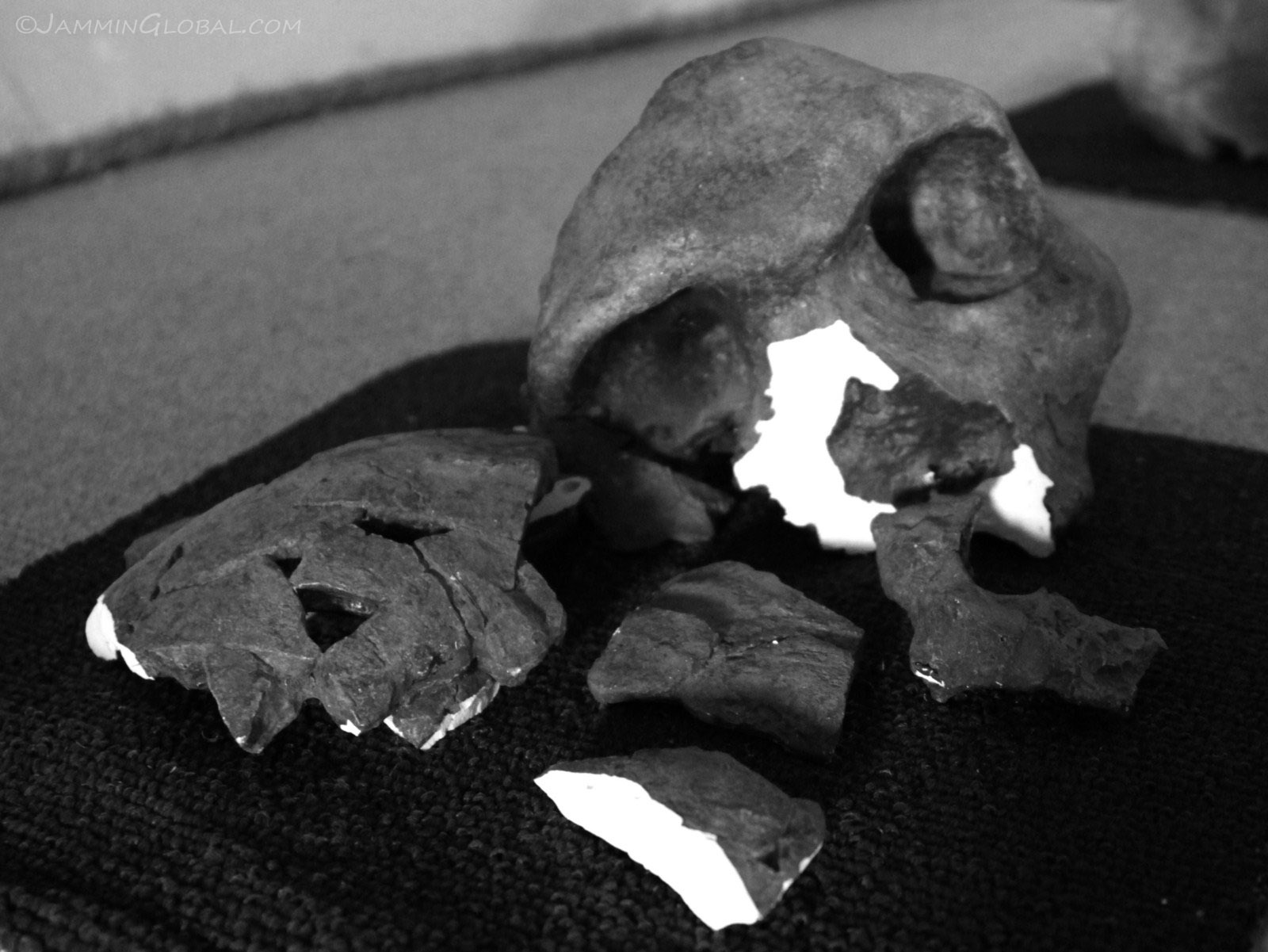 The Bodo Cranium, dating to around 600,000 years ago was discovered at Bodo, east of Addis Ababa in 1976. This skull belongs to the hominin species known as Homo rhodesiensis (or heidelbergensis) and is an interesting find because it has a very large brain capacity of 1,300 ml (44 oz), which is similar in size to modern humans but the pronounced brow ridge and wide face give it more ape-like features. All these hominin fossils fill in small bits of the story on human evolution and the picture becomes more refined with every find.
The Bodo Cranium, dating to around 600,000 years ago was discovered at Bodo, east of Addis Ababa in 1976. This skull belongs to the hominin species known as Homo rhodesiensis (or heidelbergensis) and is an interesting find because it has a very large brain capacity of 1,300 ml (44 oz), which is similar in size to modern humans but the pronounced brow ridge and wide face give it more ape-like features. All these hominin fossils fill in small bits of the story on human evolution and the picture becomes more refined with every find.
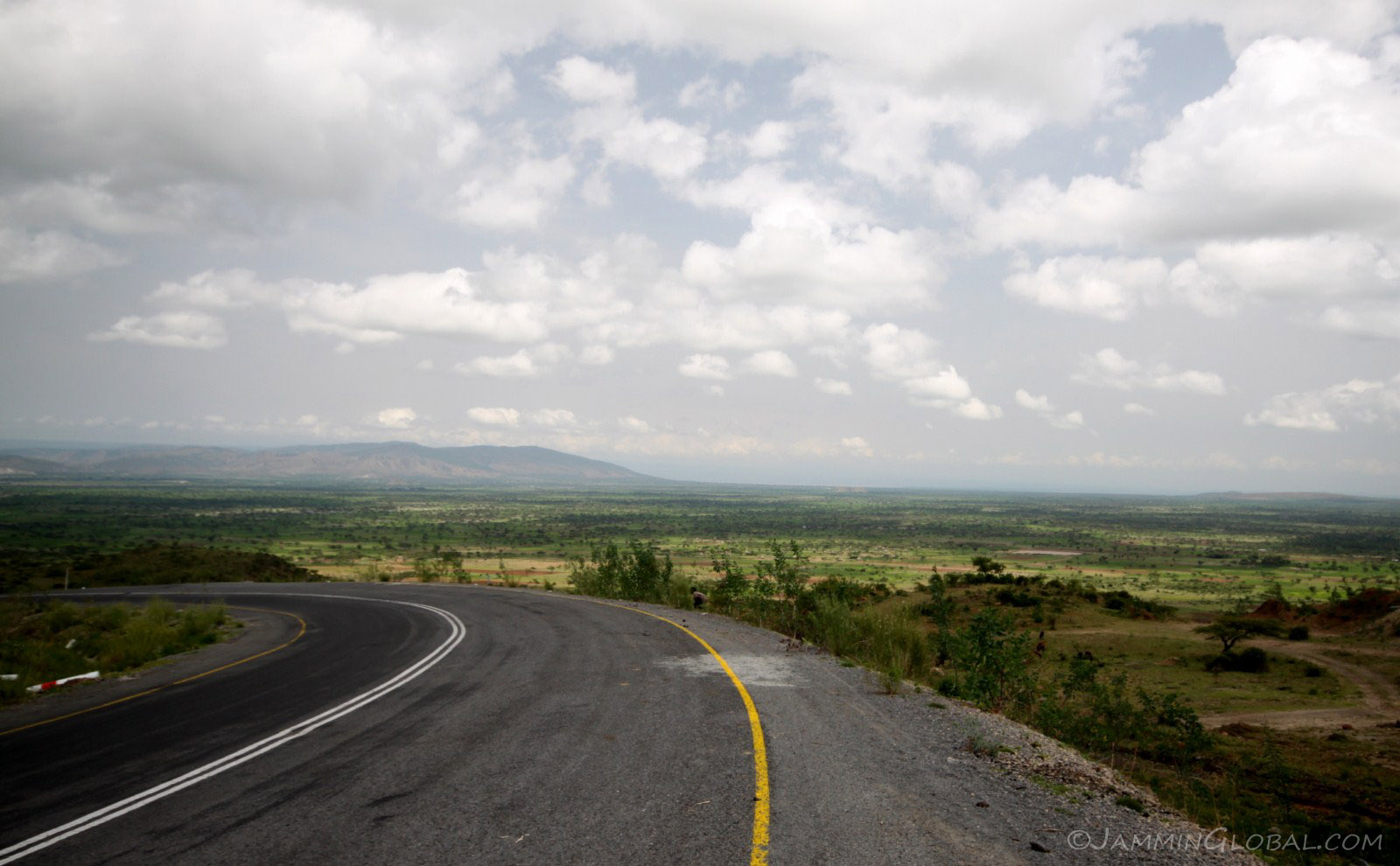 I enjoyed my fill of evolutionary anthropology and continued south to Shashamane. I came around this corner and was greeted with a wide view of the Rift Valley expanding out to the horizon in front of me. I was getting excited for the upcoming leg of following the Rift Valley through southwestern Ethiopia into Kenya.
I enjoyed my fill of evolutionary anthropology and continued south to Shashamane. I came around this corner and was greeted with a wide view of the Rift Valley expanding out to the horizon in front of me. I was getting excited for the upcoming leg of following the Rift Valley through southwestern Ethiopia into Kenya.
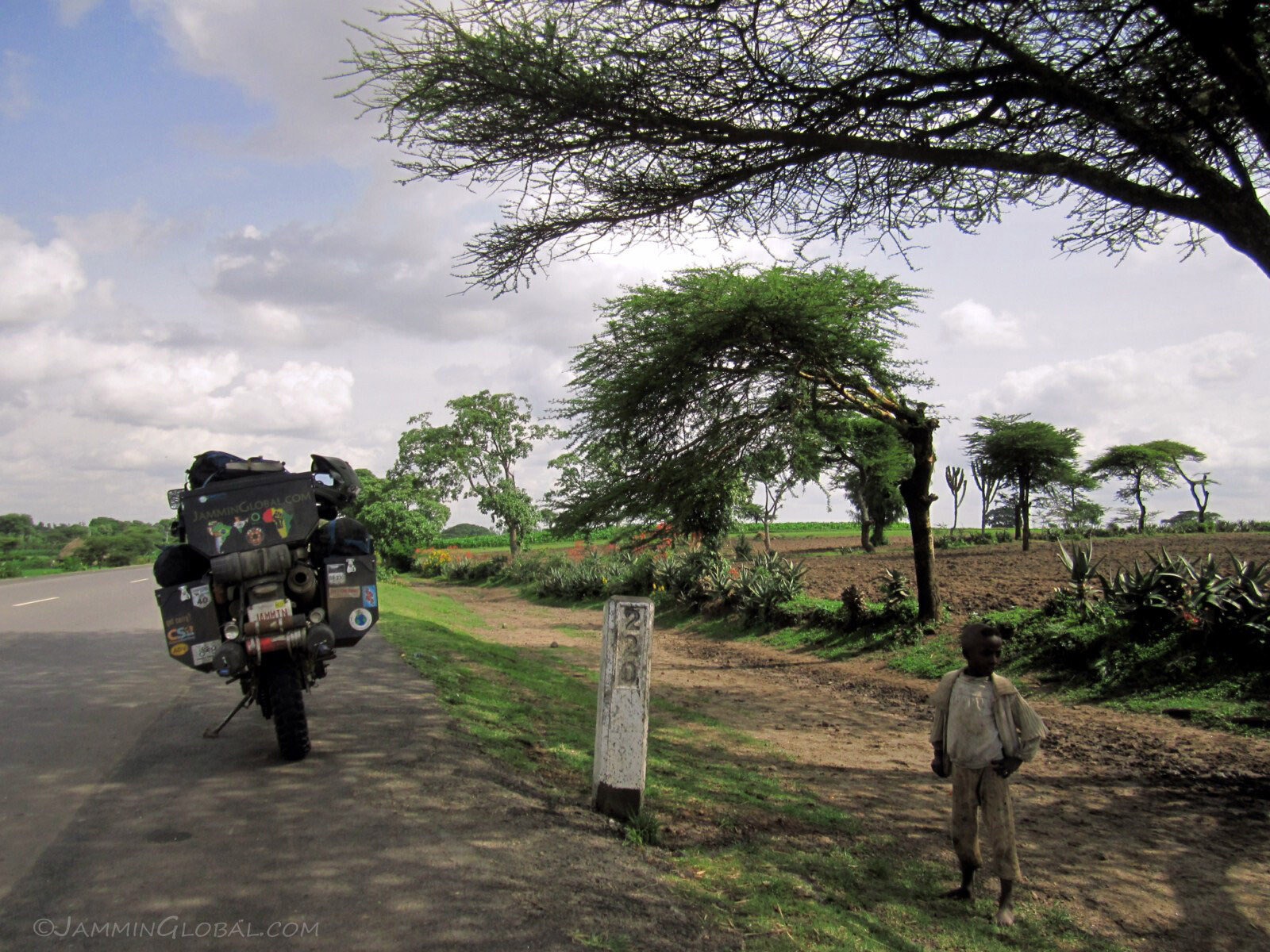 Taking a break on the side of the road and in Ethiopia, it's only a matter of seconds before a kid appears from nowhere to watch what you're doing and inevitably ask for something from you, such as money, a pen or a sweet. I have no problem being generous but the gift giving carried out by sympathetic foreigners has bred a very bad habit in the younger generation. I saw older men slapping young kids when they asked me for something, as they were clearly embarrassed but the kids were not.
Taking a break on the side of the road and in Ethiopia, it's only a matter of seconds before a kid appears from nowhere to watch what you're doing and inevitably ask for something from you, such as money, a pen or a sweet. I have no problem being generous but the gift giving carried out by sympathetic foreigners has bred a very bad habit in the younger generation. I saw older men slapping young kids when they asked me for something, as they were clearly embarrassed but the kids were not.
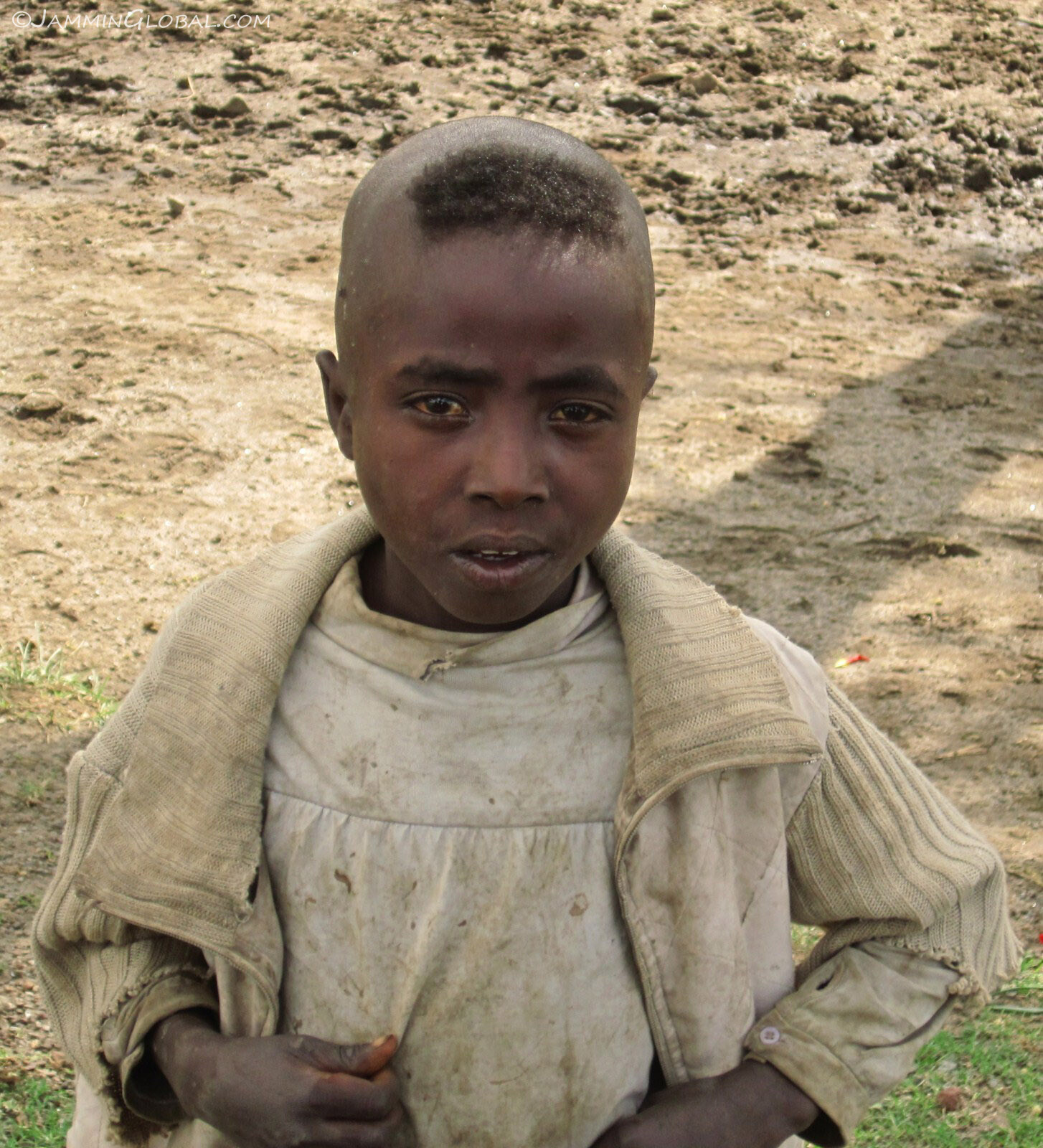 But this guy was cute with his funky hairdo so I took his photo and gave him a sweet.
But this guy was cute with his funky hairdo so I took his photo and gave him a sweet.
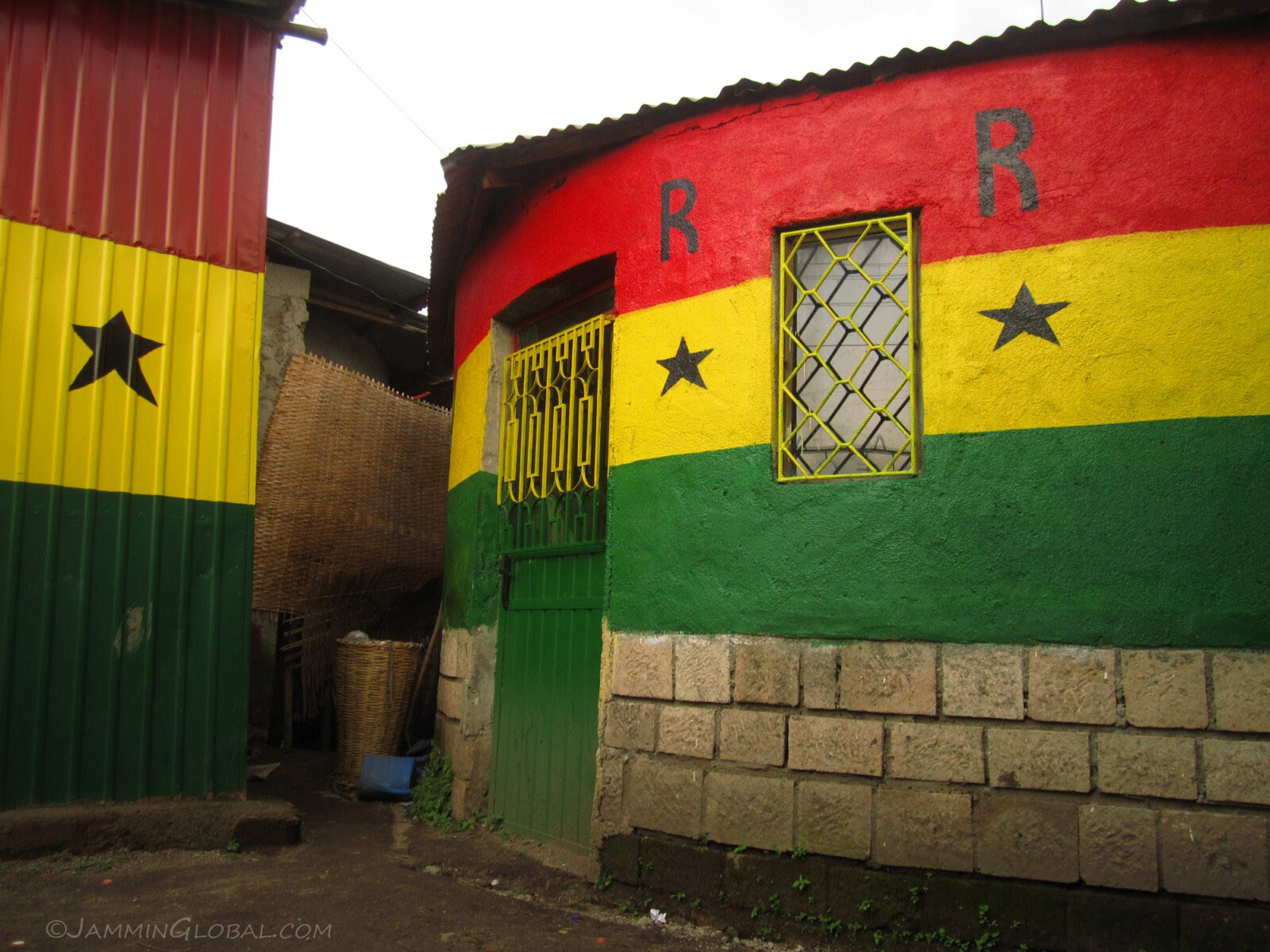 I rolled into Shashamane, a small town about 240 km (150 mi) from Addis Ababa that's known as the spiritual home of the Rastafari Movement that began in Jamaica in the 1930s. Rastas believe that the Ethiopian Emperor Haile Selassie I is an incarnation of the Christian God and refer to him as Jah. Before he became emperor in 1930, Selassie's given name was Tafari and coming from a noble family, his name was pre-fixed by Ras (like Duke in England) and that's where the movement got its name from.
I rolled into Shashamane, a small town about 240 km (150 mi) from Addis Ababa that's known as the spiritual home of the Rastafari Movement that began in Jamaica in the 1930s. Rastas believe that the Ethiopian Emperor Haile Selassie I is an incarnation of the Christian God and refer to him as Jah. Before he became emperor in 1930, Selassie's given name was Tafari and coming from a noble family, his name was pre-fixed by Ras (like Duke in England) and that's where the movement got its name from.
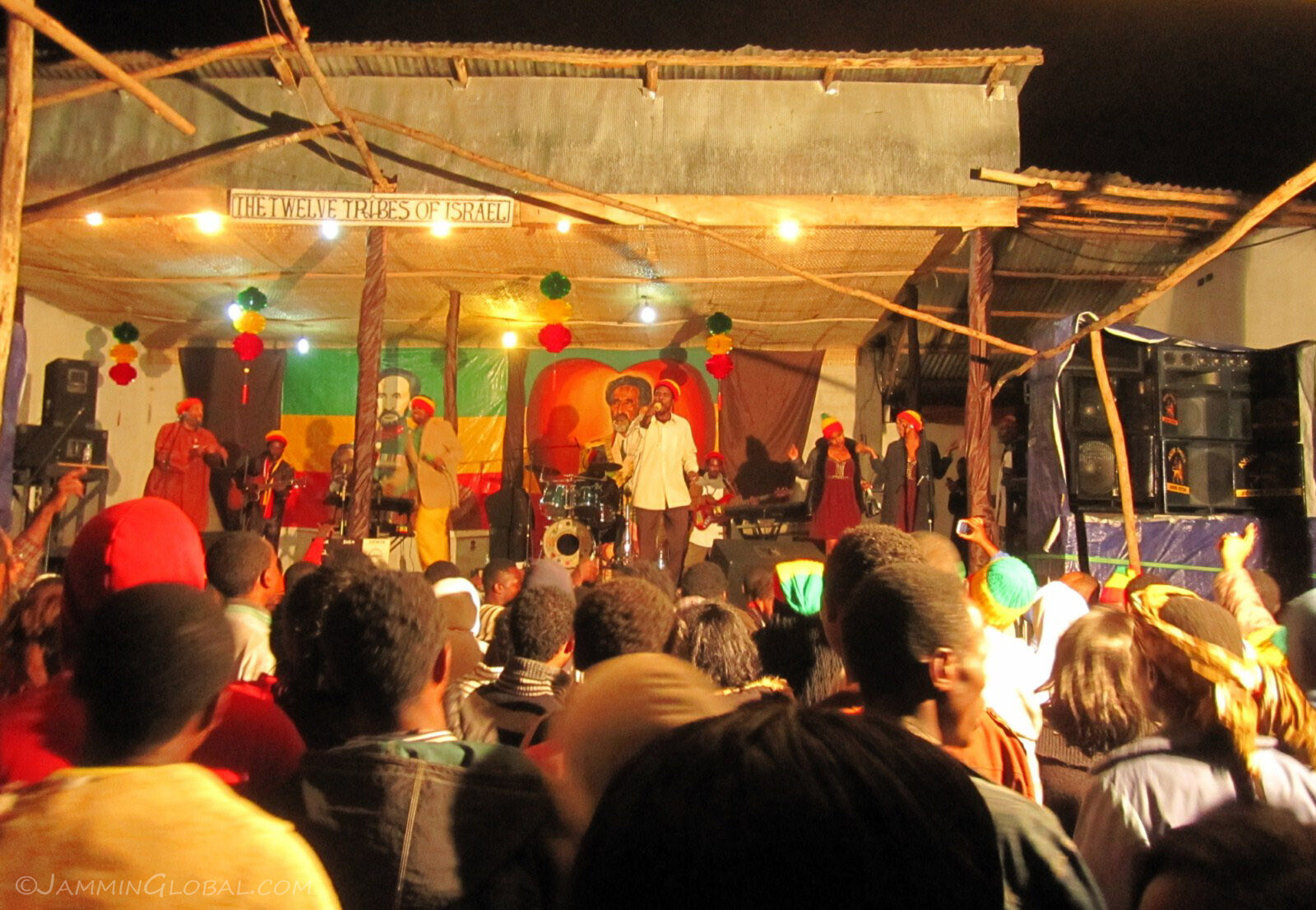 I was fortunate to be in Shashamane for Haile Selassie's 119th birthday celebration and there was a jammin reggae concert in his honor. Artists had flown in from the islands (Caribbean) and each one said a few words about Jah and their love for Shashamane. The Rastafari Movement began without Selassie's knowledge and upon learning that there were people who were worshipping him in Jamaica, he paid a visit and duly invited whoever wanted to come to settle in the holy land of Ethiopia. Selassie gave the Rastas 500 acres of land around Shashamane and encouraged them to settle here, which they did, slowly over the years and now it's considered the spiritual home of the movement.
I was fortunate to be in Shashamane for Haile Selassie's 119th birthday celebration and there was a jammin reggae concert in his honor. Artists had flown in from the islands (Caribbean) and each one said a few words about Jah and their love for Shashamane. The Rastafari Movement began without Selassie's knowledge and upon learning that there were people who were worshipping him in Jamaica, he paid a visit and duly invited whoever wanted to come to settle in the holy land of Ethiopia. Selassie gave the Rastas 500 acres of land around Shashamane and encouraged them to settle here, which they did, slowly over the years and now it's considered the spiritual home of the movement.
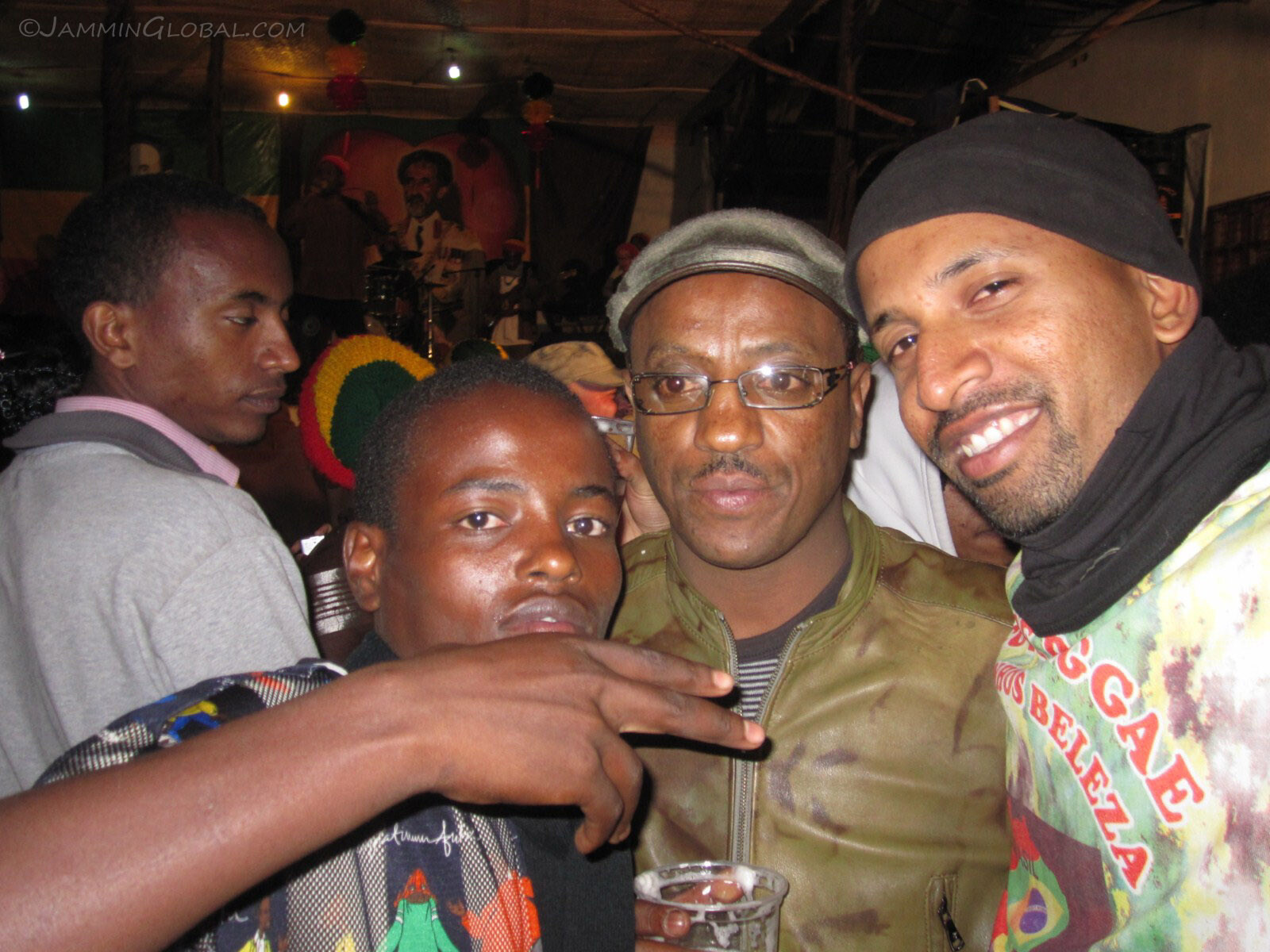 I hung out with these two guys for the evening that I met while getting some food. Good vibrations all around. And I was very happy to wear my reggae t-shirt that I got in Sao Luis, Brazil; another reggae paradise.
I hung out with these two guys for the evening that I met while getting some food. Good vibrations all around. And I was very happy to wear my reggae t-shirt that I got in Sao Luis, Brazil; another reggae paradise.
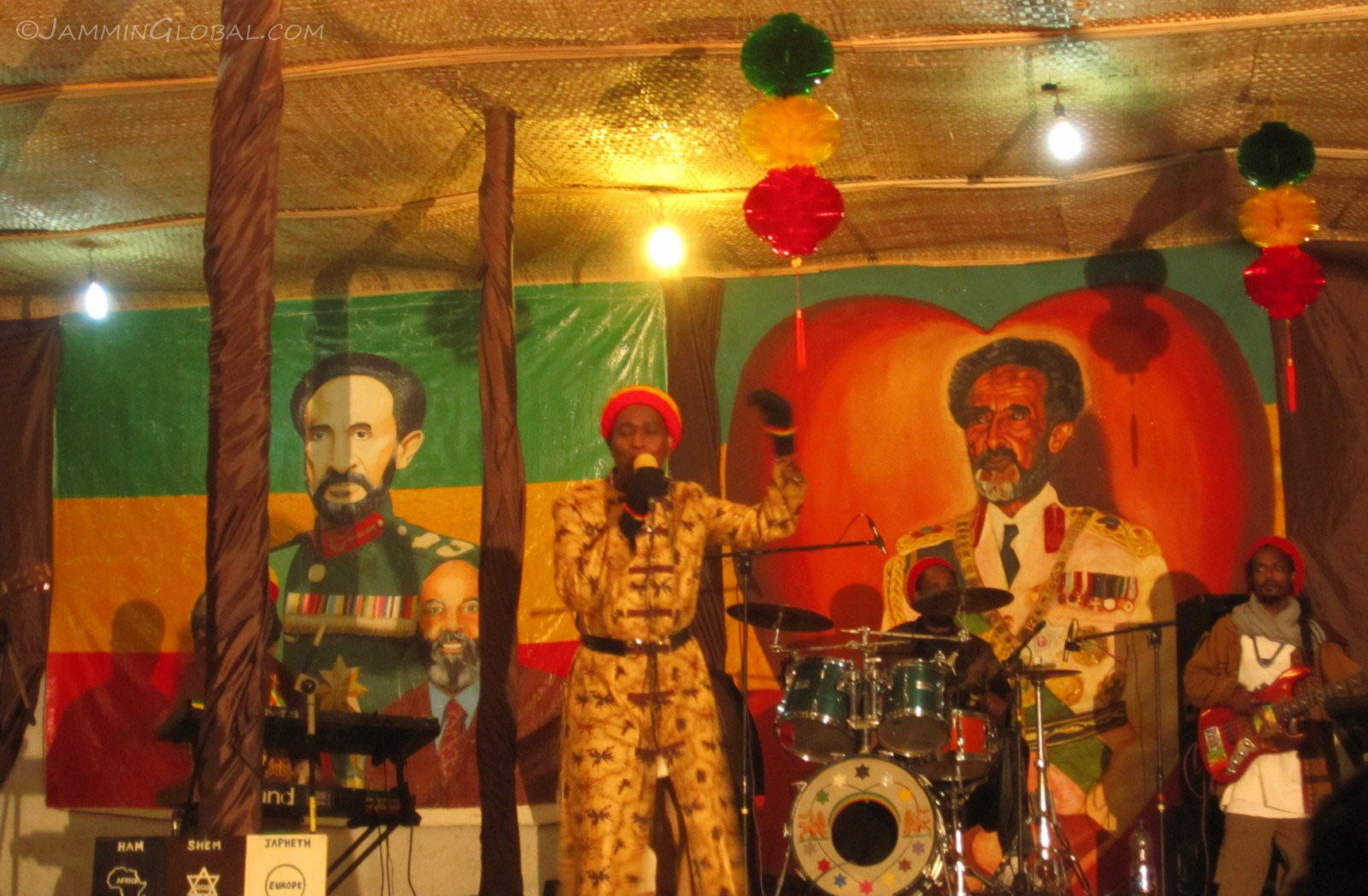 Lots of love for Haile Selassie. The Rastafari Movement has been around for a long time but it was the worldwide spread of reggae music that brought the movement greater attention, particularly the success of Bob Marley, whose songs were played with great emotion on the stage. I was especially thrilled when Jammin was played! Yah mon!
Lots of love for Haile Selassie. The Rastafari Movement has been around for a long time but it was the worldwide spread of reggae music that brought the movement greater attention, particularly the success of Bob Marley, whose songs were played with great emotion on the stage. I was especially thrilled when Jammin was played! Yah mon!
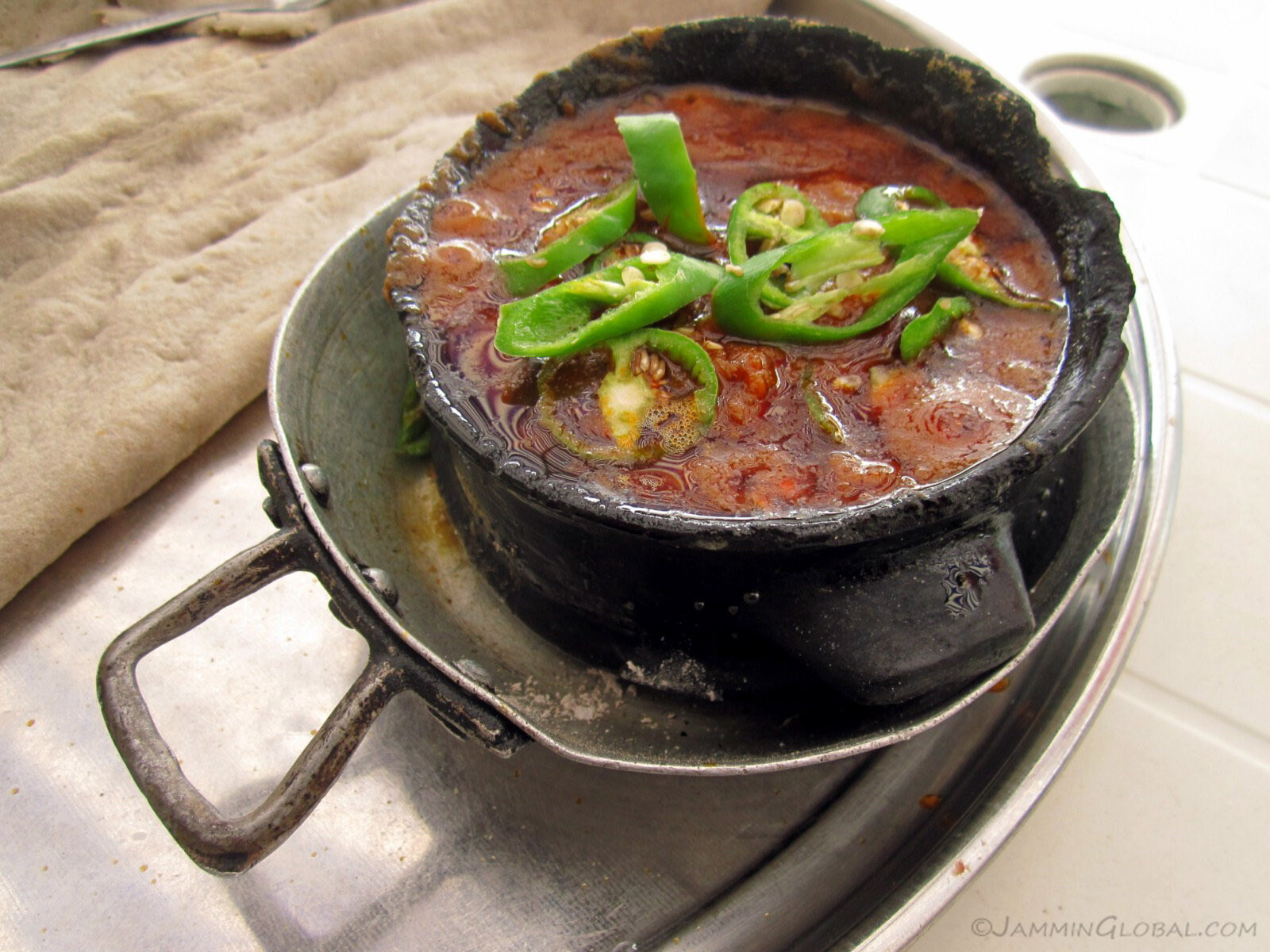 I spent a few more lazy days in Shashamane and enjoyed southern Ethiopia's version of Shiro Tagabino, which was rich and smooth and oh yeah, spicy.
I spent a few more lazy days in Shashamane and enjoyed southern Ethiopia's version of Shiro Tagabino, which was rich and smooth and oh yeah, spicy.
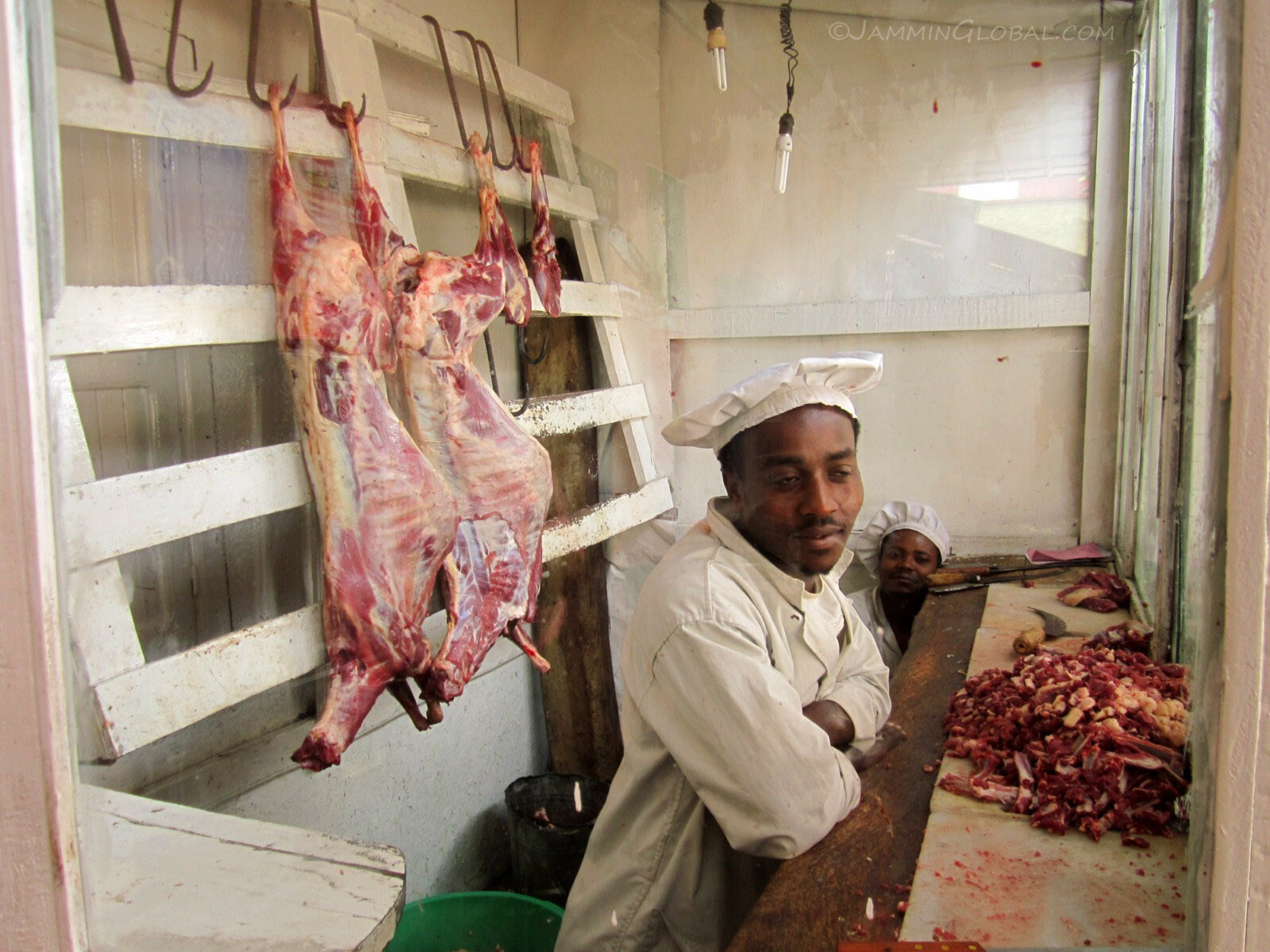 The customary butcher in front of every restaurant. Most Ethiopians were there to eat meat but I enjoyed all the vegetarian dishes in Ethiopian cuisine.
The customary butcher in front of every restaurant. Most Ethiopians were there to eat meat but I enjoyed all the vegetarian dishes in Ethiopian cuisine.
I had read a lot on human evolution and how Africa is our ancestral homeland and felt satisfied by coming to Ethiopia and getting up close to our human origins. I truly believe that if more people realized how connected all humans are, we would see through most of our problems with another culture or society, which is plaguing our current progress towards a more sustainable future. It's a complex problem and raising awareness of our interconnectedness is a step towards that goal.
Next: Ethiopia, Part 9: Off-Road Convoy thru Omo Valley
Previous: Ethiopia, Part 7: Lalibela and its Rock-Hewn Churches